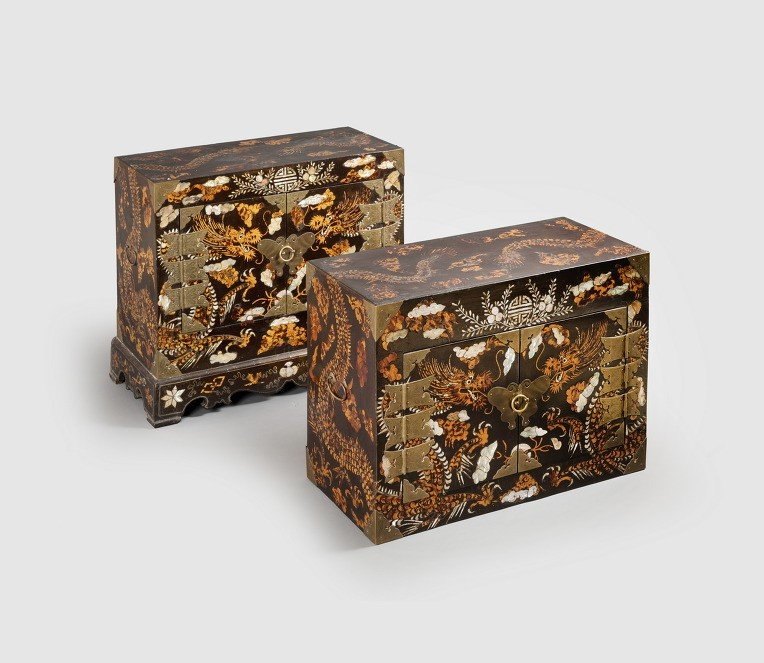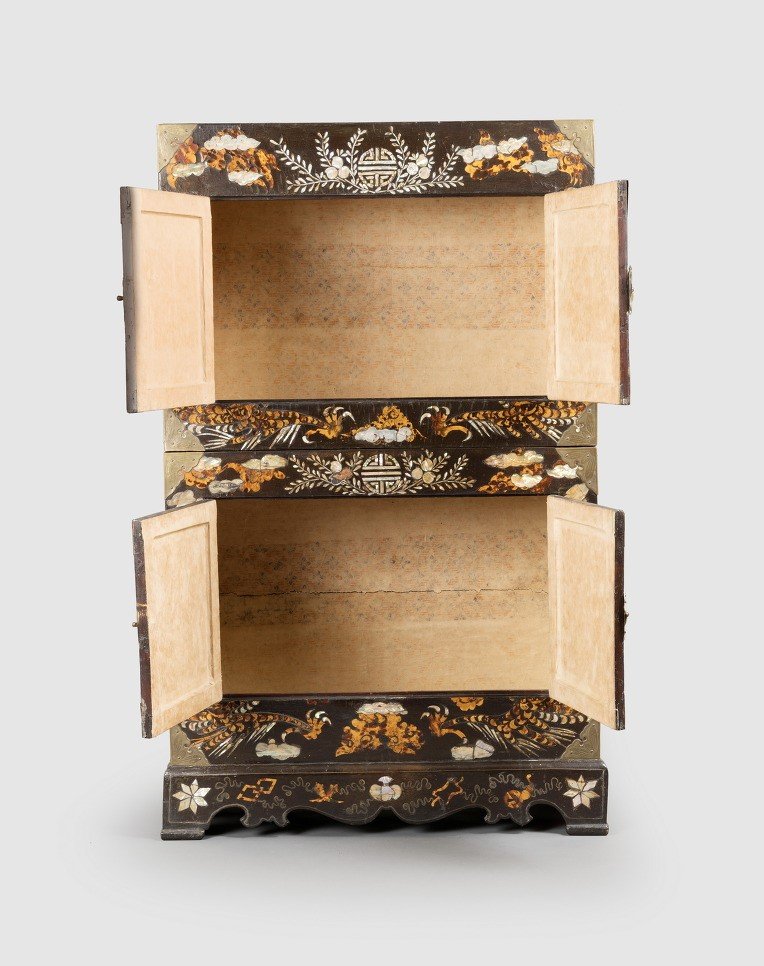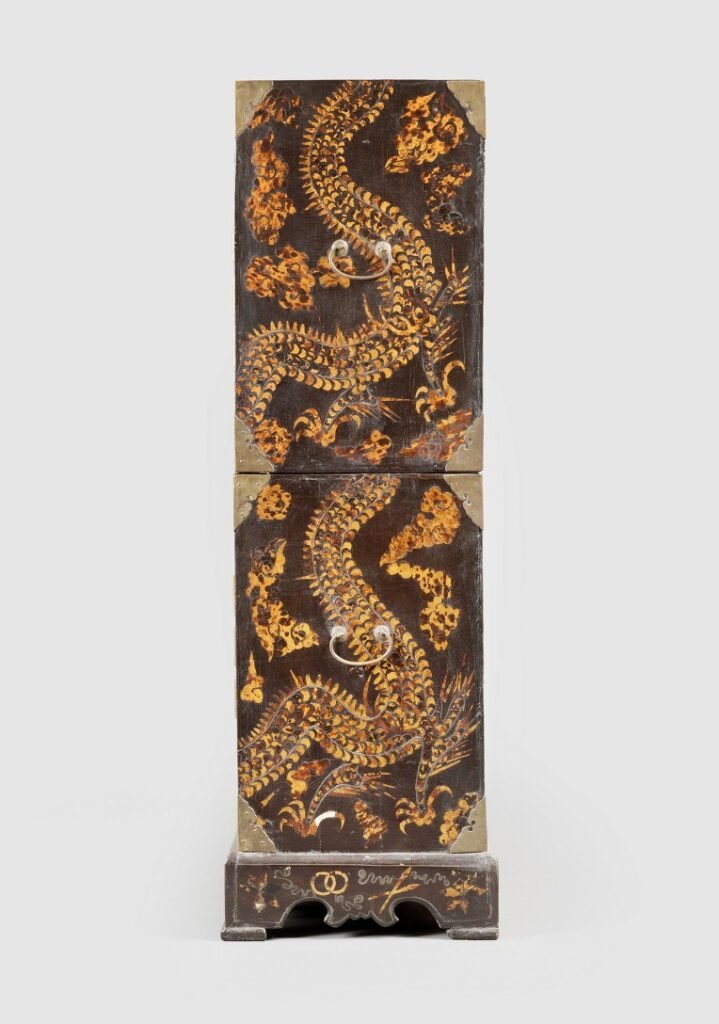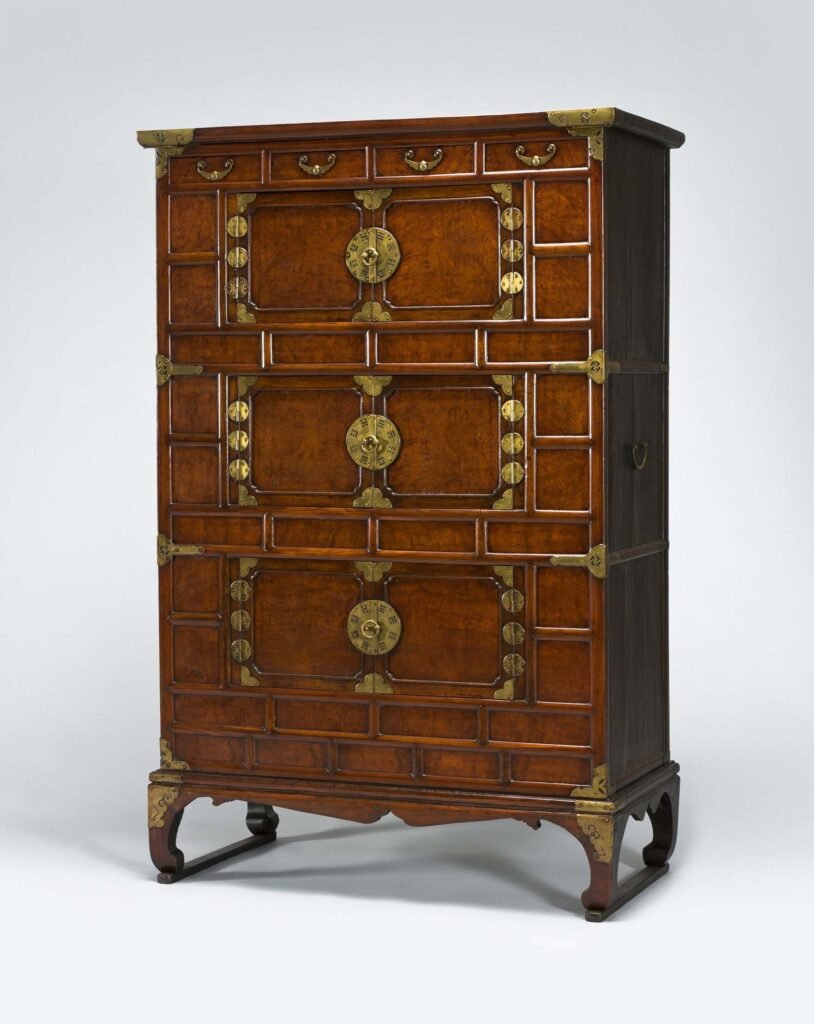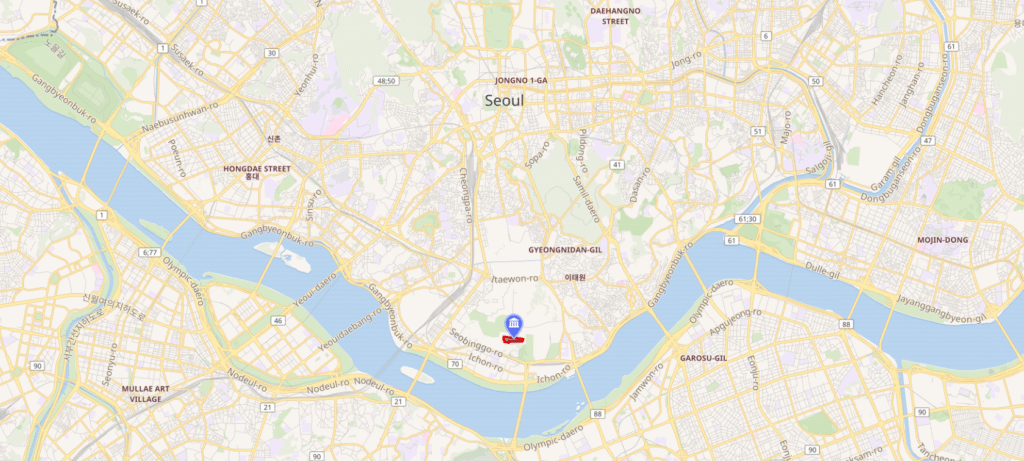
LINK: National Museum of Korea.
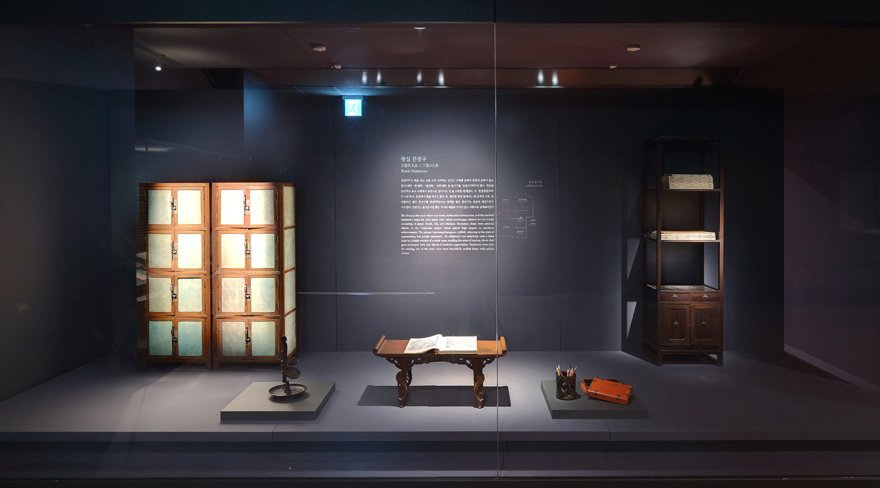
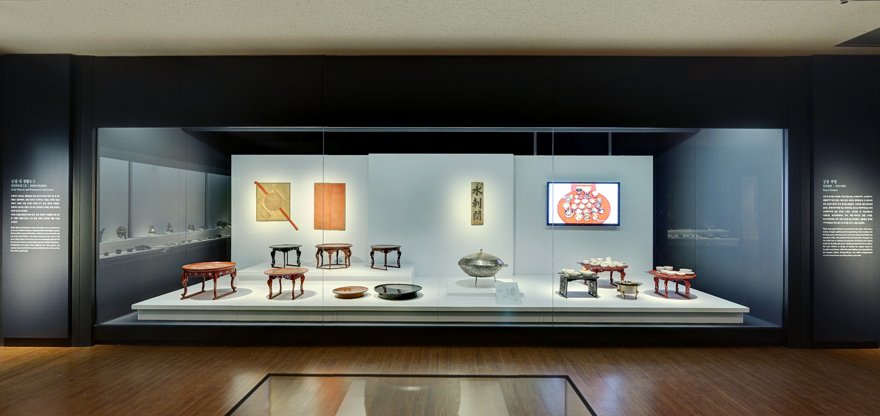



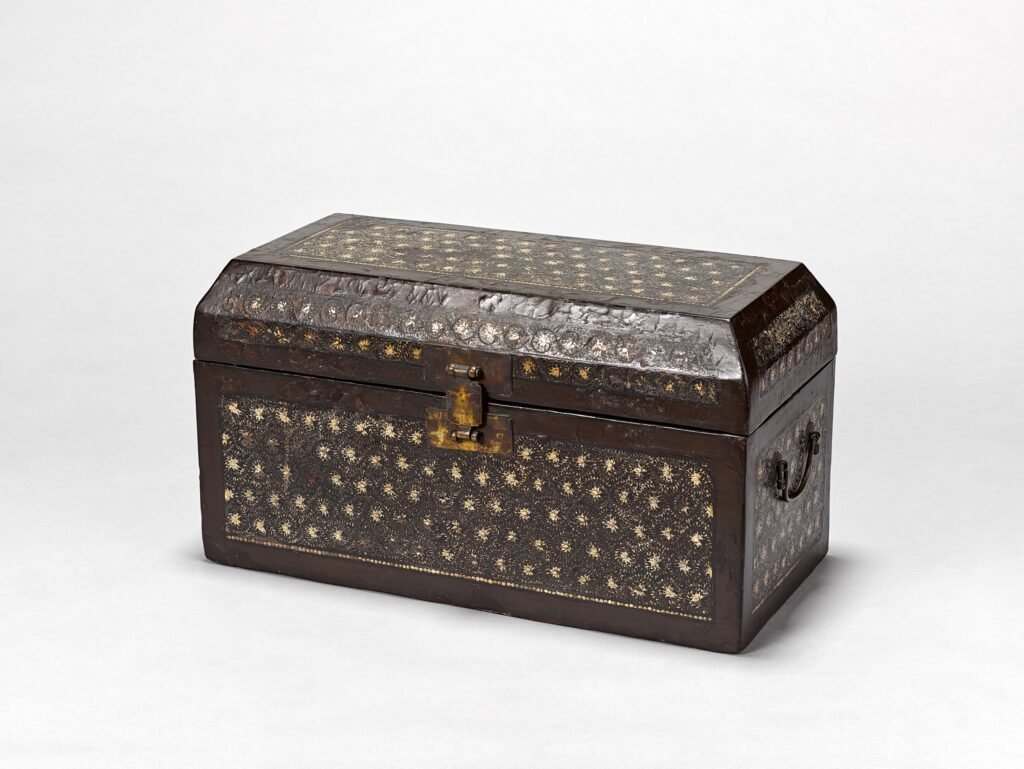
It is presumed to be a work of the late Goryeo Dynasty.
It is in the shape of a rectangular box with each corner of the upper part of the lid trimmed.
The main pattern is a peony pattern, and some have horse leaf patterns, tortoiseshell patterns, and yeonju patterns.

H. 2,7cm, Lid H. 1,8cm, W. 9,8cm, D. 7cm.
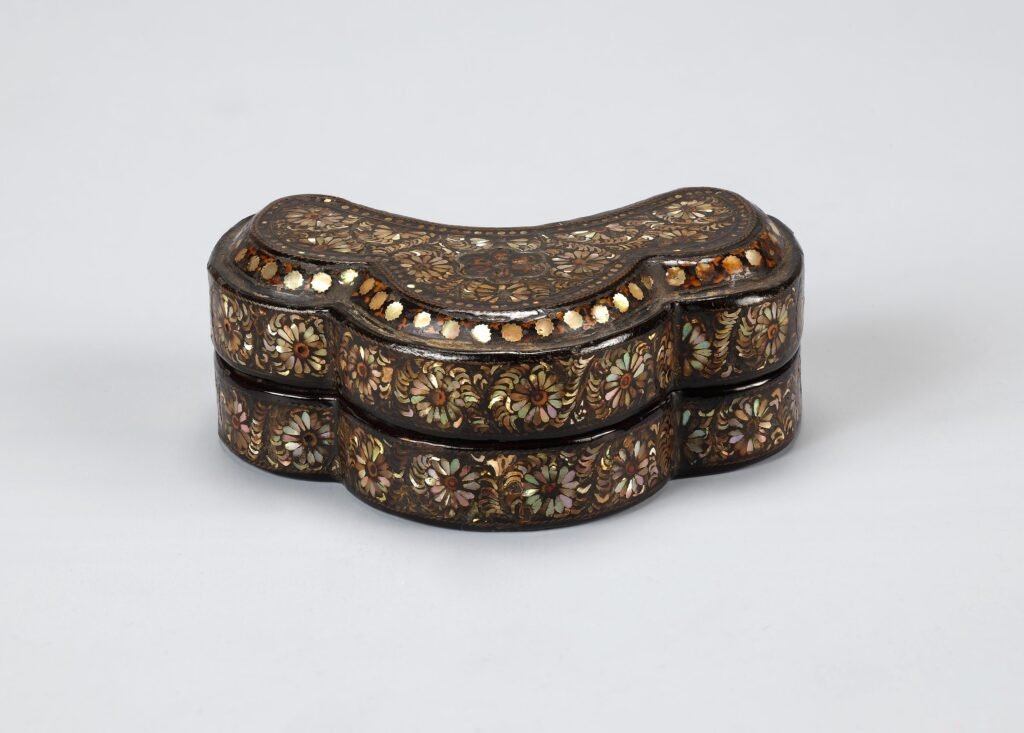

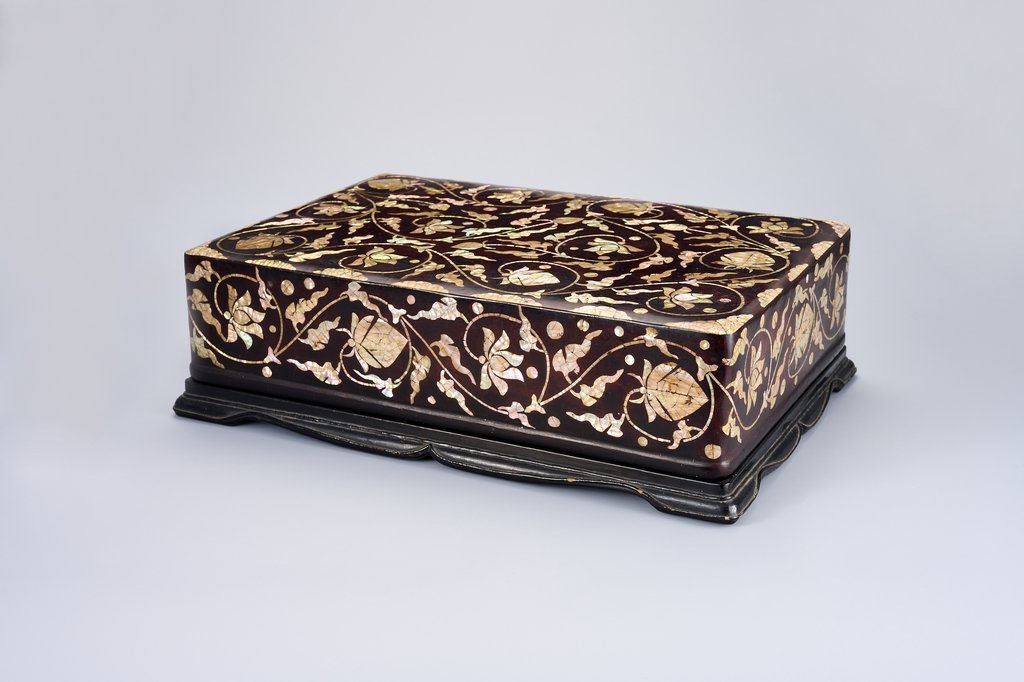
This box was acquired in an auction by Sotheby’s New York on September 22, 2022 and returned to Korea from early 2023. It was confirmed that the mother-of-pearl box was wrapped in fabric before painting to prevent the wood from being deformed by moisture.
This is a technique mainly used when making high-end lacquerware. Various shapes of lotuses are decorated with mother-of-pearl. This mother-of-pearl box is presumed to have been made in the 16th century, judging by the fact that it used the hammering method, in which the mother-of-pearl in a curved state was cut out according to the pattern and then hit with a hammer to make it touch the surface.

Dark stain on wood with mother-of-pearl inlay. Yellow brass fittings.
Decorated with trees , flowers, deers & birds motifs.
Joseon dynasty. 19th century.
H. 63cm, W. 74cm, D, 39cm.
The form of this bandaji is very unusual. Built with thin wood and decorated with mother-of-pearl, the chest stands on tall legs. The fittings are sparse but made of high-quality yellow brass. We believe it was owned by a high-ranking individual and was probably used to store documents and books.


H. 171,1cm, W. 113cm, D. 56cm.
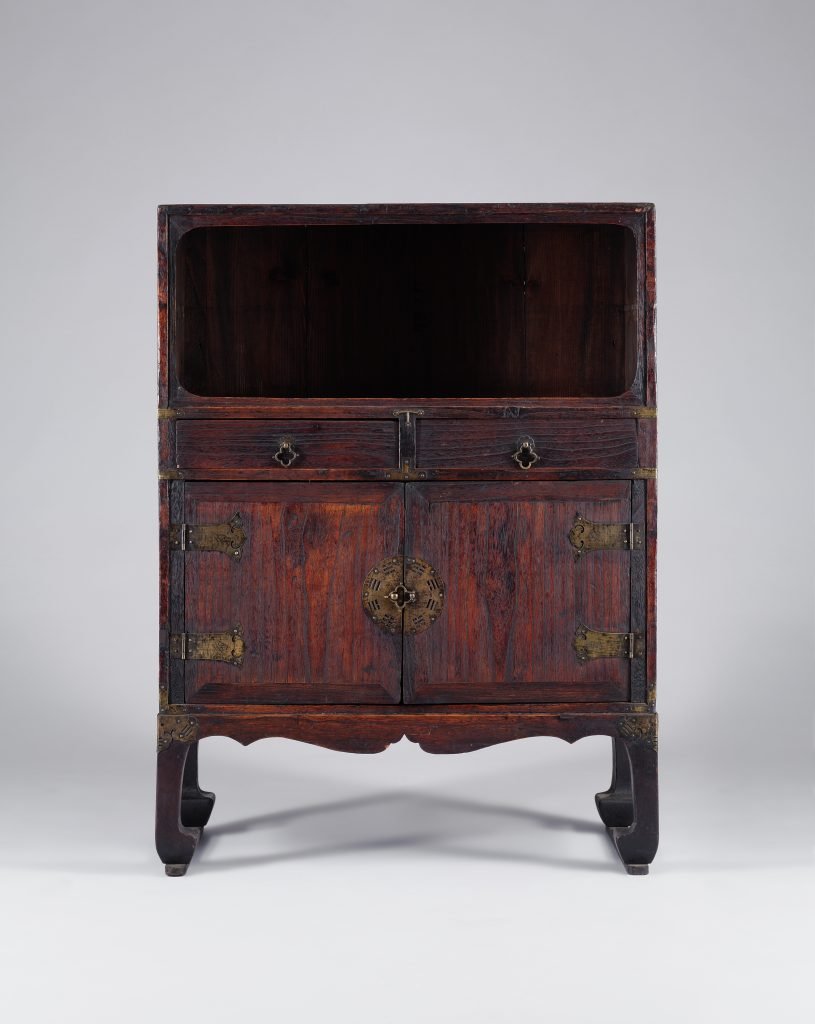
Paulownia wood. H. 93cm, W. 69cm, D. 39,8cm. This bookcase consists of an upper shelf whose front is open while its sides and back are closed in; a mid-shelf fitted with two drawers; and a lower shelf with a hinged door to make a cabinet. The legs of the case feature air holes shaped like the wings of a bat. At the center of the door planks is a circular padlock plate engraved with trigram designs. The door planks and the post are connected by swallow-shaped hinges.


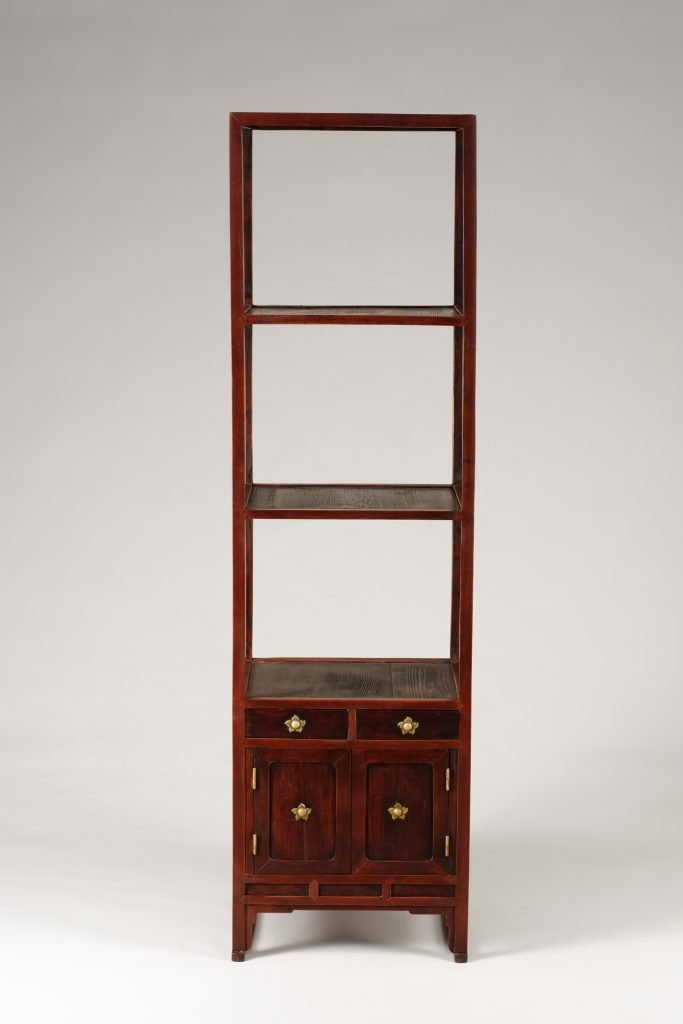
H. 132,8cm, L. 34cm, W. 36,4cm
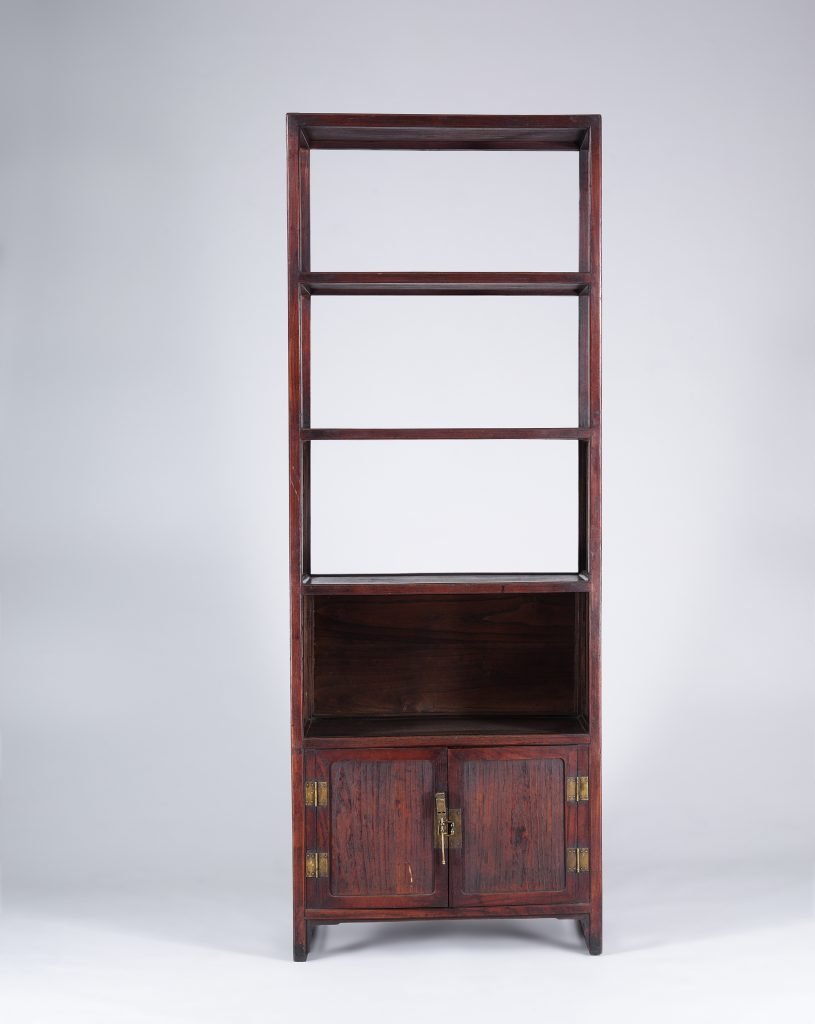
Paulownia wood. H. 178,5cm, W. 65,7cm, D. 31,8cm.
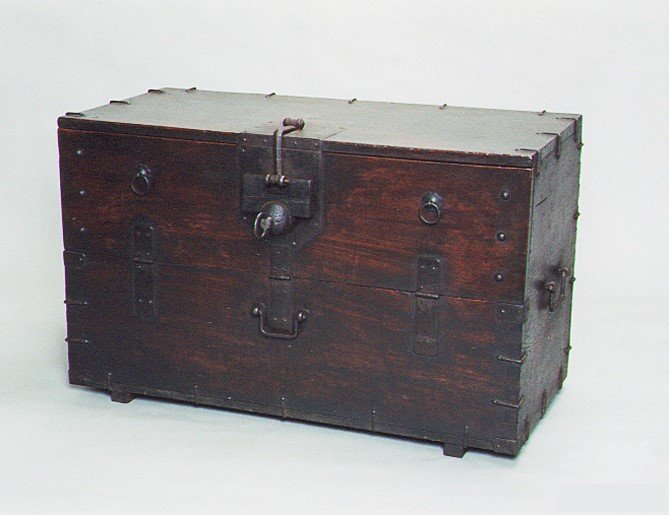

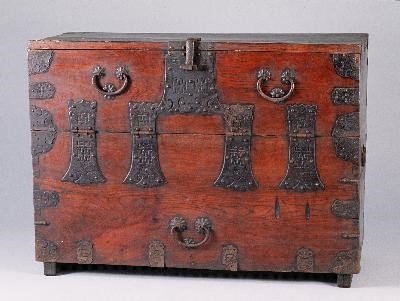
H. 72,2cm, W. 99cm, D. 46.cm.

H. 61,5cm, W. 89,2cm, D. 42,7cm.

H. 64cm, W. 90cm, D. 44cm.
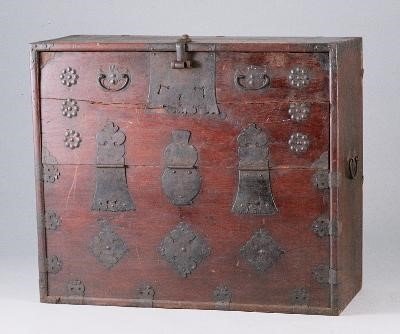
Early 20th century. H. 79cm, W. 93,5cm, D. 39cm.

H. 62cm, W. 81cm, D. 42cm.
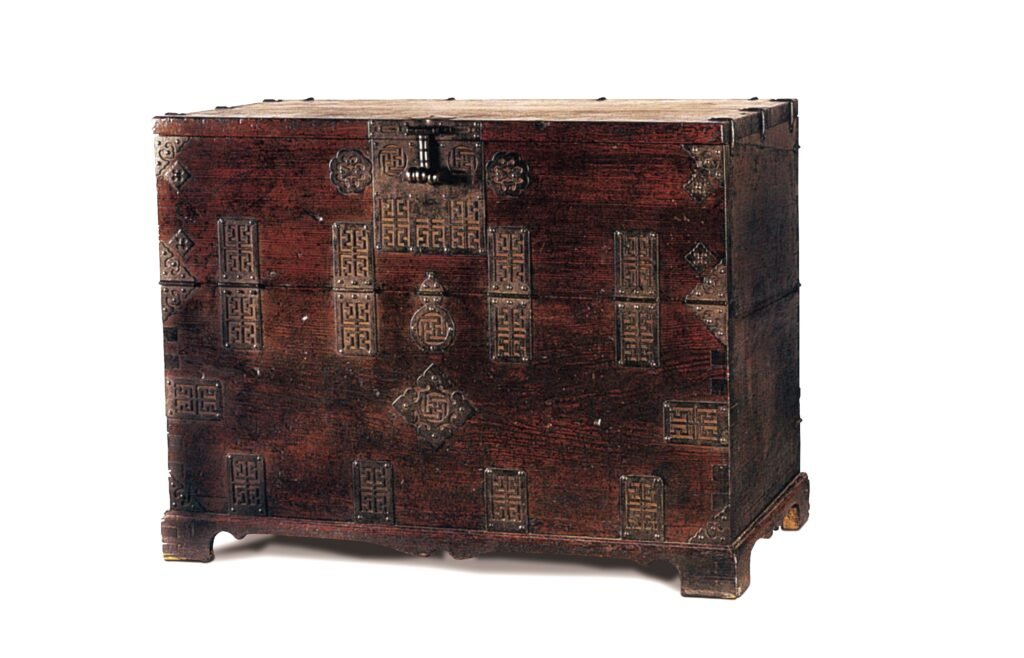
H. 65cm, W. 80,5cm, D. 42,1cm.
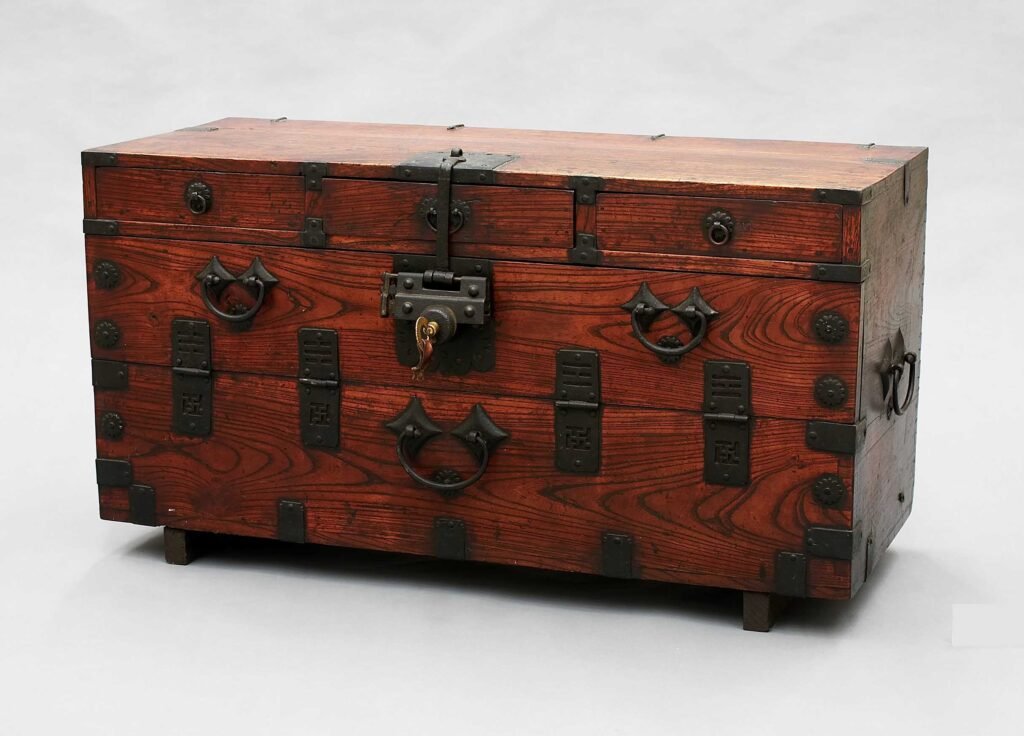

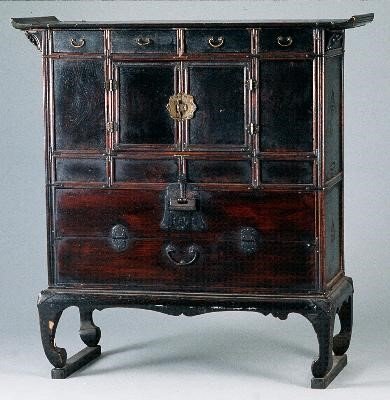
Mid 19th century. H. 102,8cm, W. 97cm, D. 38,2cm

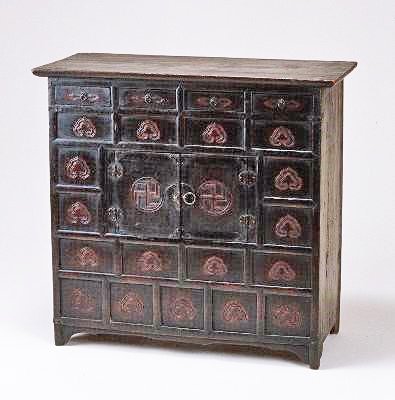
H. 96cm, W. 100,5cm, D. 45cm.

Japanese Colonial Period,
Pine wood. H. 160cm, W. 71,5cm, D. 44,3cm.
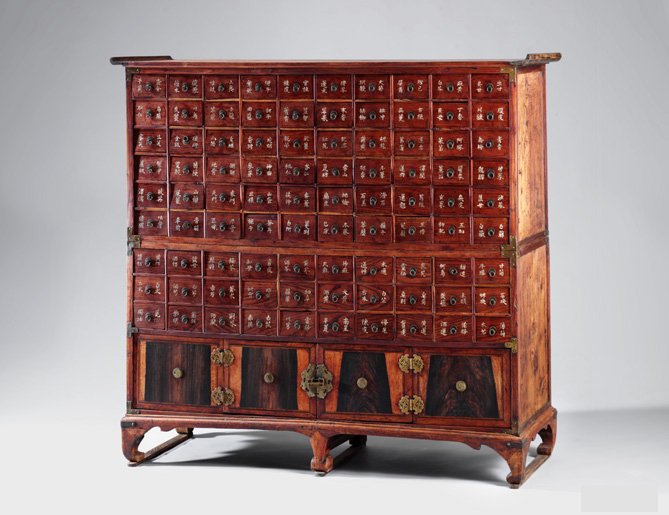
Japanese Colonial Period,
Persimmon wood. H. 121,5cm, W. 129,5cm, D. 35,5cm. This medicine chest has many drawers for containing different kinds of herbal medicines. The panels of the hinged doors at the bottom were made of persimmon wood. Their blackish color contrasts with the dark orange color of the other parts of the chest. An additional leg has been fitted in the middle of the supporting legs, a unique characteristic of furniture made in the late Joseon Period.
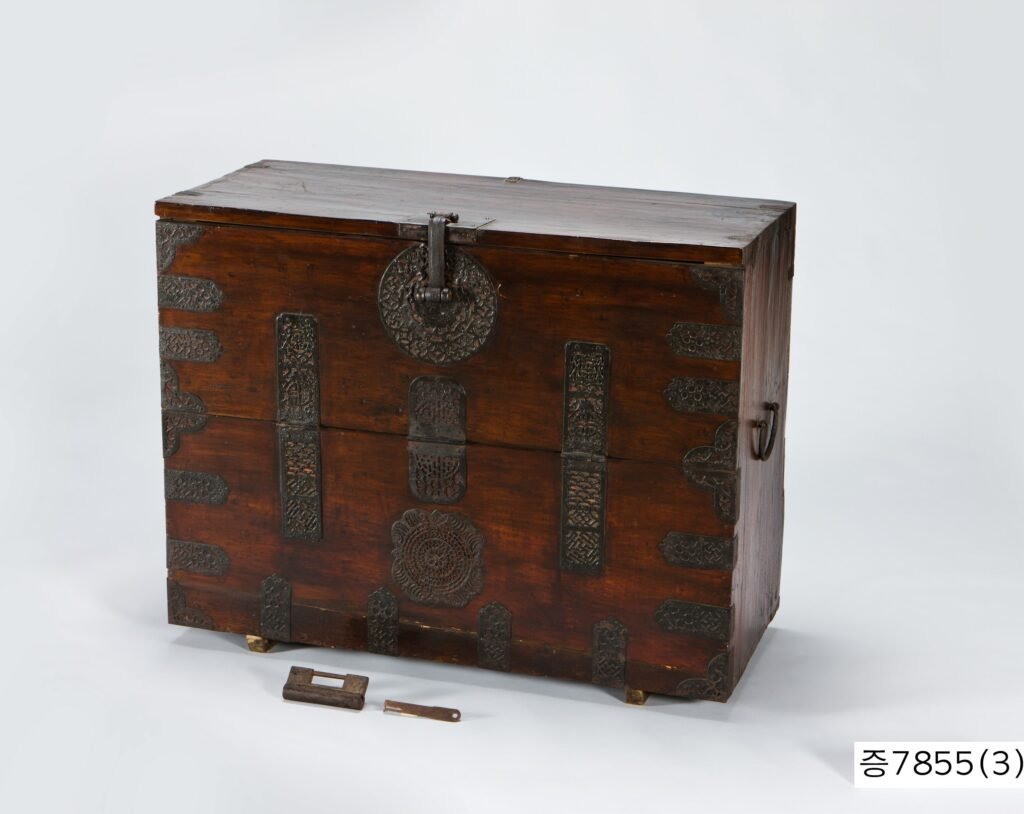
Elm & Pine wood. H. 71,5cm, W. 91,2cm, D. 42cm.

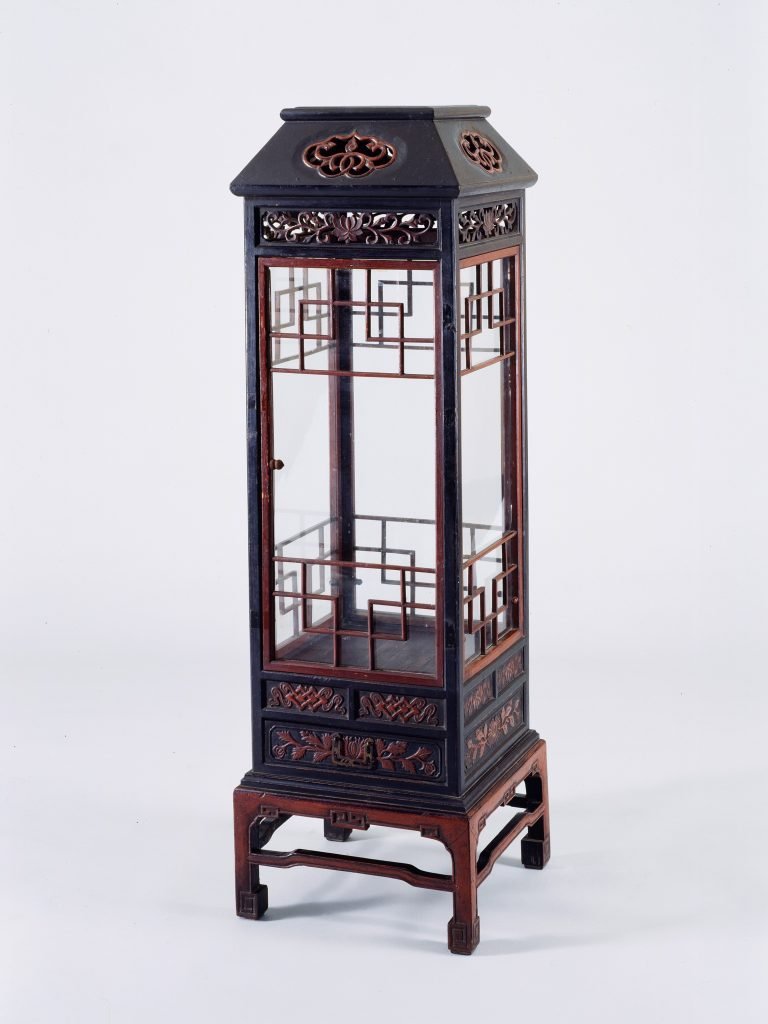
H. 106,4cm, W. 28,9cm, D. 28,9cm.

Wood – Bamboo
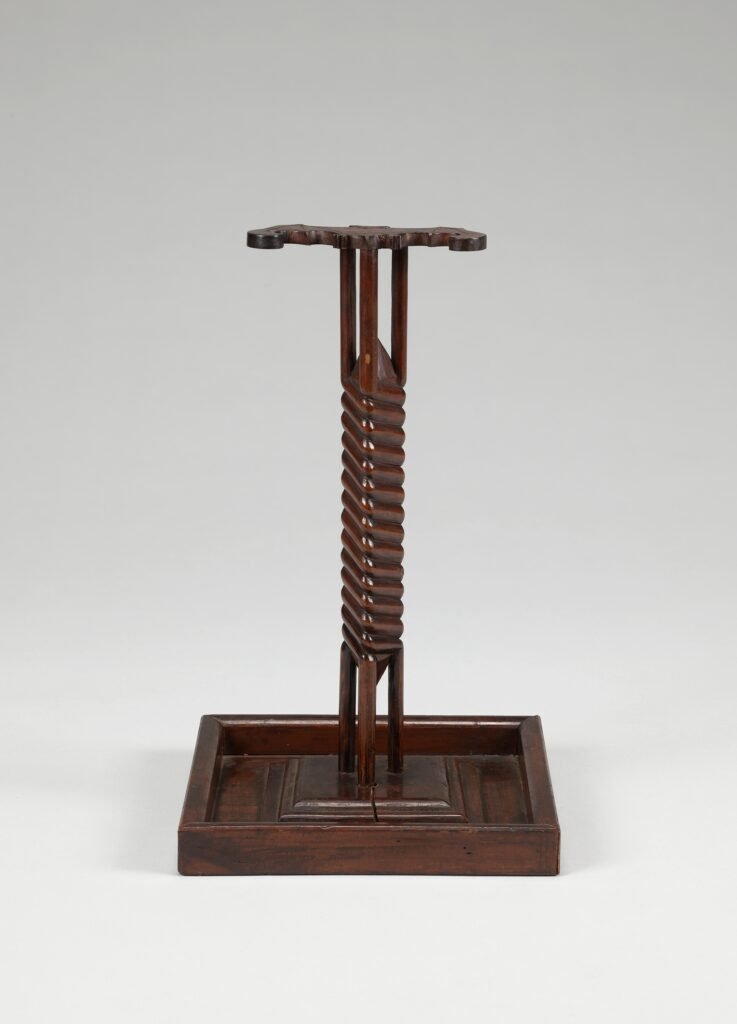

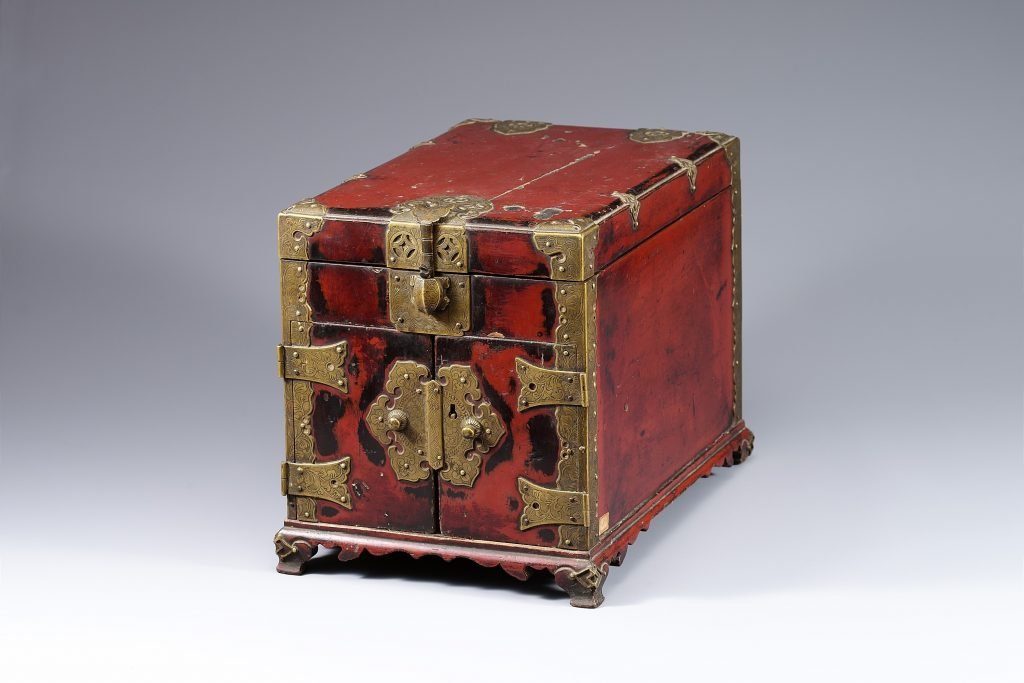
19th century. Gyeonggi province.
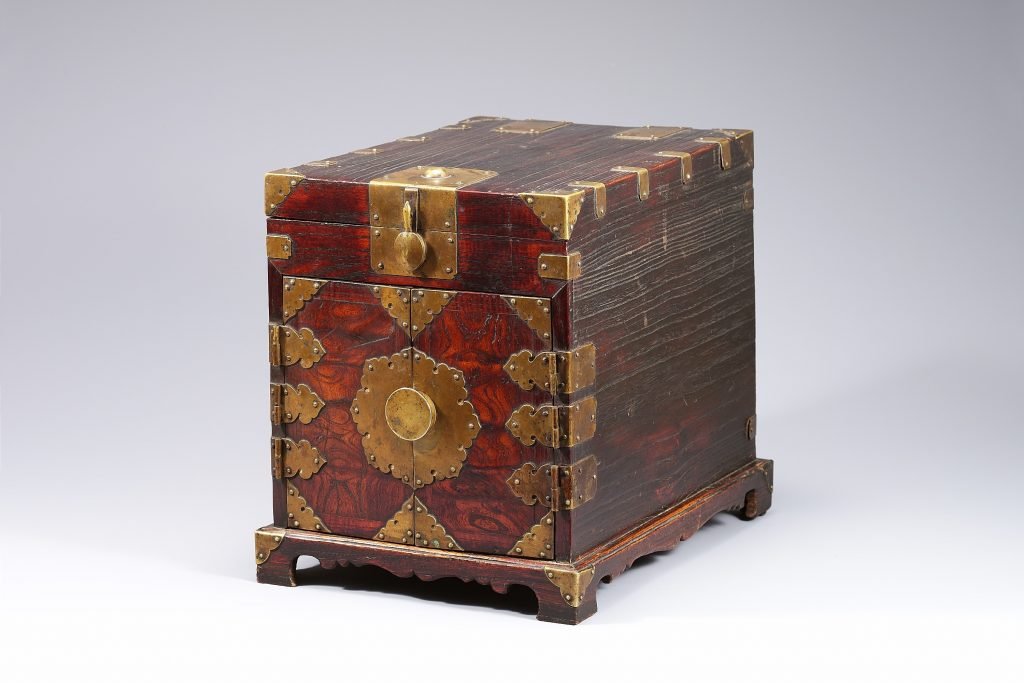
H. 29,7cm, W. 23,4cm, D. 32.5cm.
This beautiful box called “Pit-Chop” in Korean was used in the woman’s quarter to store small accessories such as combs, brushes, and cosmetic powder.
Beautiful woods have been used such as fine-grained zelkova on the front part enhanced by quality yellow brass fittings. Paulownia wood sides and top. This box stands on elegant legs. Origin: Probably Gyeonggi Do Province. Korea.

Late 19th century. H. 20cm, W. 19,6cm, D. 34,9cm.
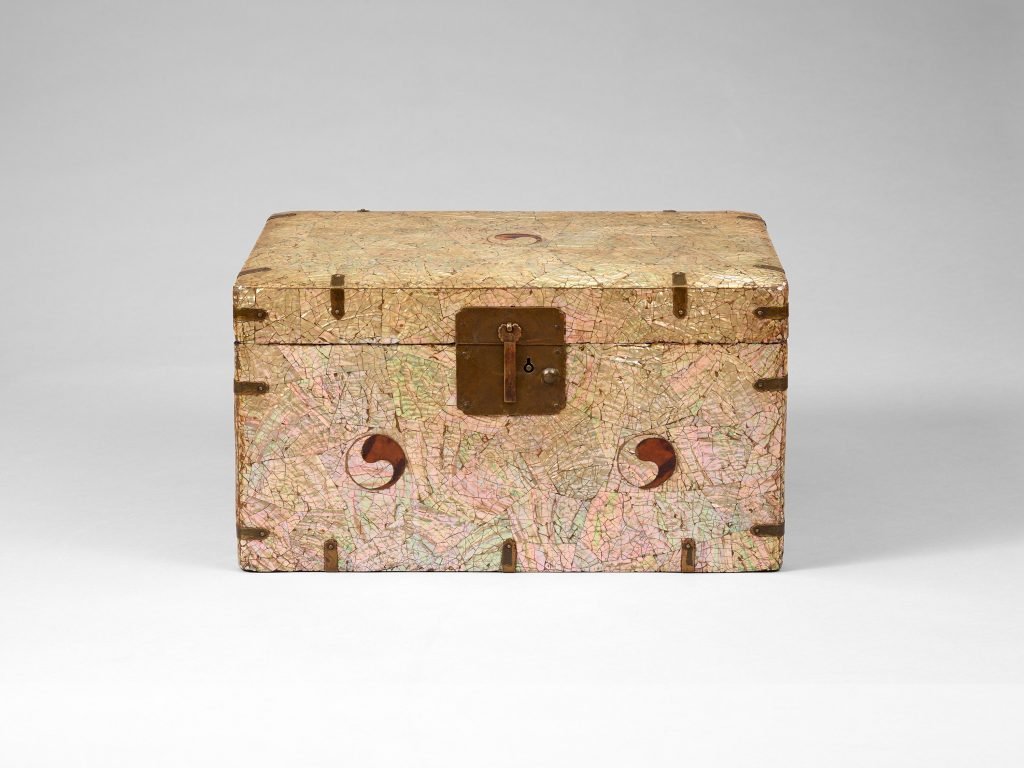
Traditionally, the patterns of Korean mother-of-pearl lacquerware were objects with specific shapes, and each had its own symbol and meaning.
The same was true for letter patterns and geometric patterns.
However, in the 19th century of the Joseon Dynasty, a unique method of decorating the entire surface with mother-of-pearl appeared without planning a specific pattern. The entire surface of the box with Taegeuk pattern is covered with mother-of-pearl, and the top of the lid and the front of the body are decorated with Taegeuk patterns made of mother-of-pearl and tortoiseshell to give emphasis.
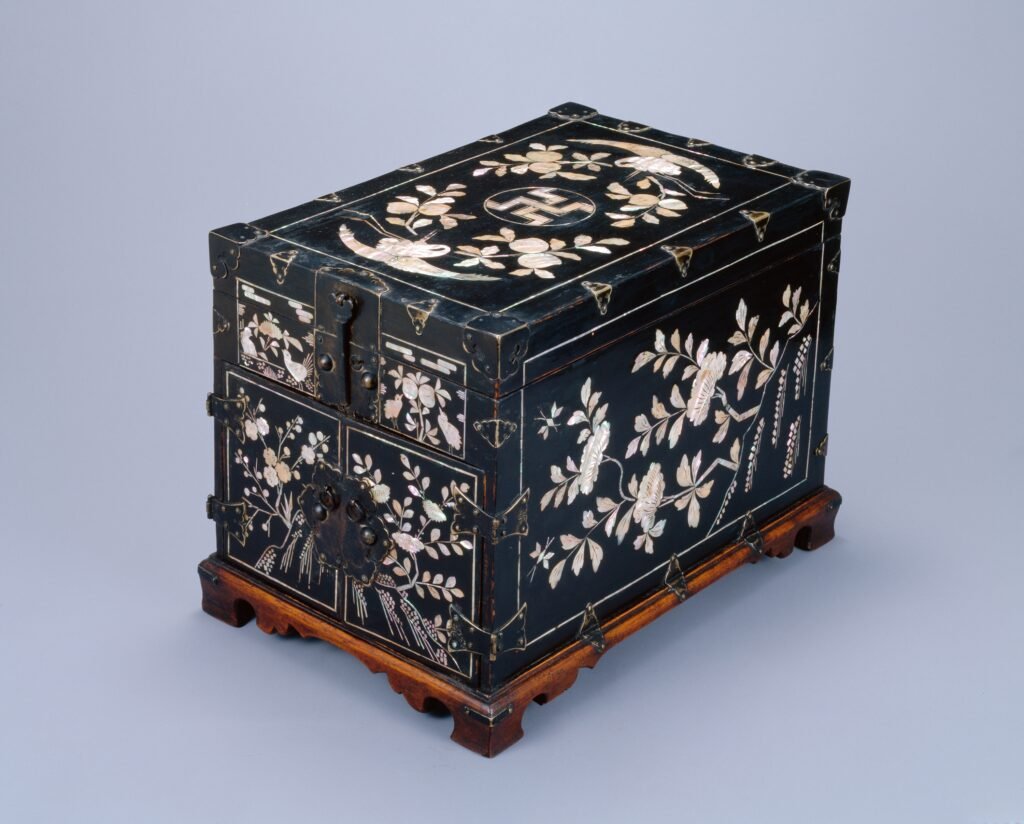
H. 26,1 cm, W. 35cm, D. 22,6 cm.
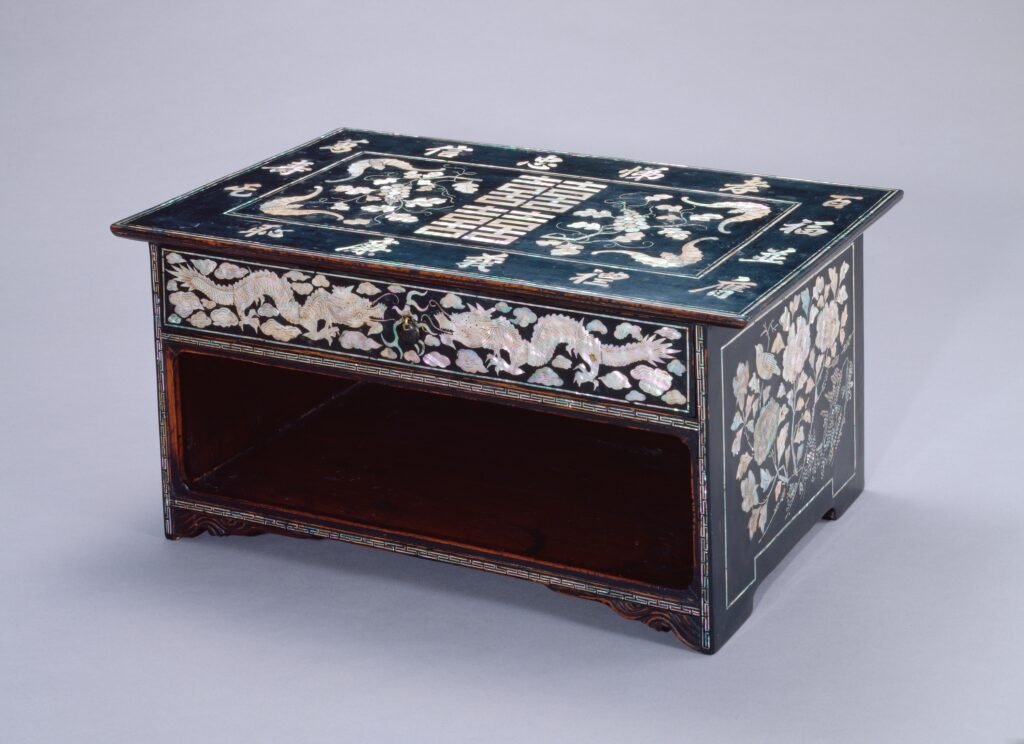

Original book chests are hard to find nowadays because they were produced in small quantities for an affluent class of the population. Small in size, the front part of this piece of furniture consisted of doors with sometimes a row of drawers on the upper part. The ends of the top panel could be lifted up so that the rolls placed on it would not fall off. They were also shallow (around 35cm) and raised on elegantly decorated legs.
Attached photo of a Korean two-level book chest.
Height 71cm, Width 96,5cm, Width 34.8cm.
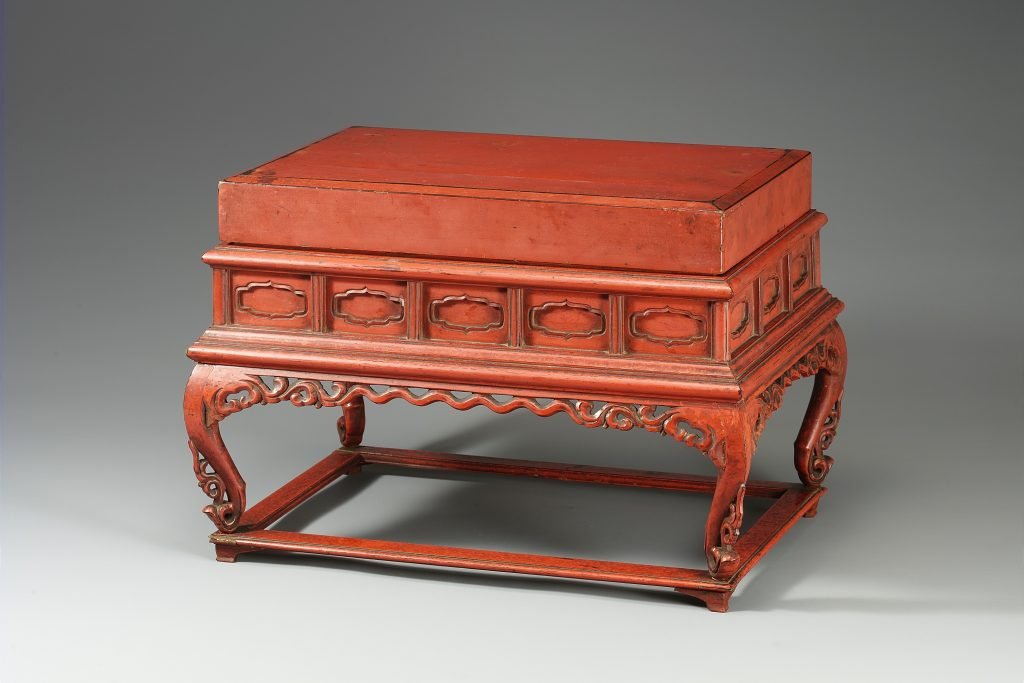
H. 27cm, W. 36cm, D. 23cm.
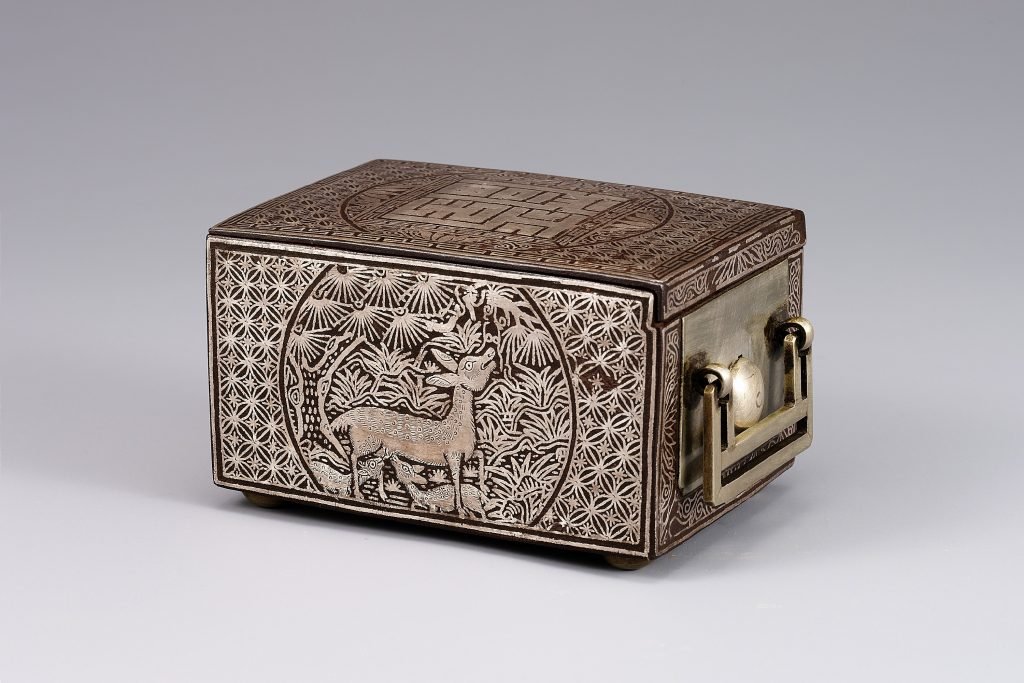
Joseon Dynasty. Iron, silver.
H. 6,7cm, W. 8cm, L. 11,2cm.
This box-shaped case was used to store tobacco leaves during the Joseon Period. It features the Ten Symbols of Longevity (i.e., deer, crane, and more) inlaid in silver. The Chinese character “壽,” which stands for longevity, and “福,” representing blessings, are inscribed in the middle of the lid.
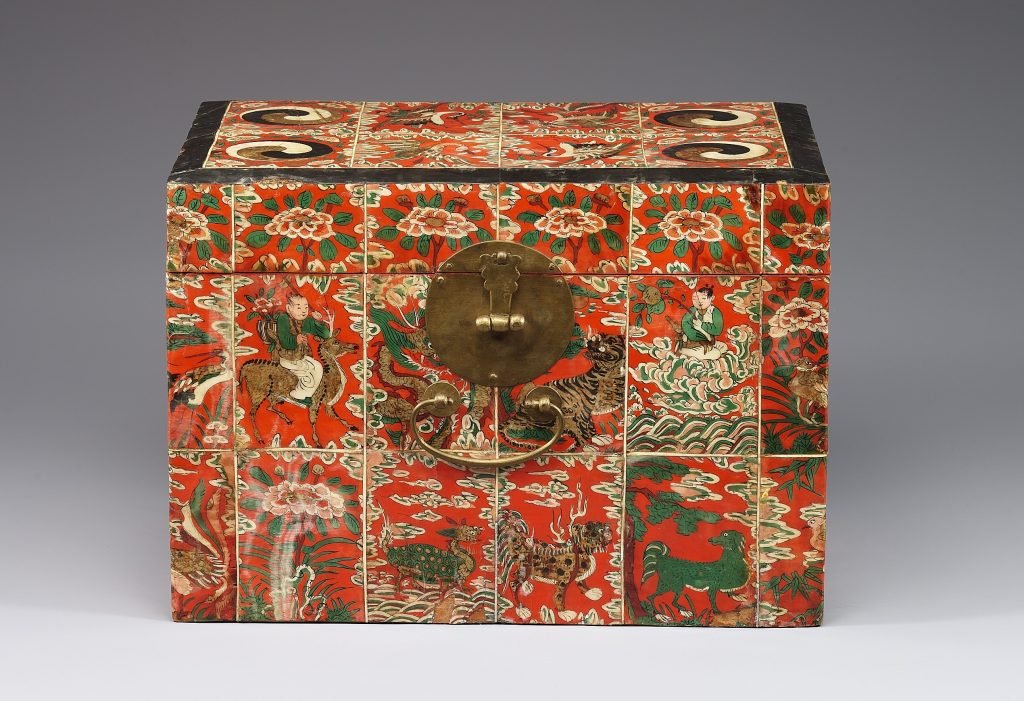
H. 24,3cm, 34,1×21,8cm. Hwagak (華角) refers to a unique type of craftwork made with ox horns that have been cut and flattened into thin, translucent sheets. One side of these sheets would be painted with patterns or images, and then the painted side was attached to a wooden surface as decoration. Since ox horns are usually rather small, dozens of them were required to fully decorate even a small wooden object. Thus, hwagak crafts are known to be very complicated and difficult to produce. However, because of their vibrant, colorful decorative effect, hwagak products were quite popular, especially among women. This box is decorated with an array of plants and animals, including peonies, cranes, tigers, deer, turtles, and carp, as well as images of the Immortal Child (童子), who can be seen riding some of the animals against the bright red backdrop. The theme of the Immortal Child sitting astride an animal comes from Taoism, and was a common trope of hwagak. The top of the lid has a black border, and there is a taegeuk (yin-yang symbol) in each of the four corners. Arch-shaped iron handles are attached to the front and back of the box.
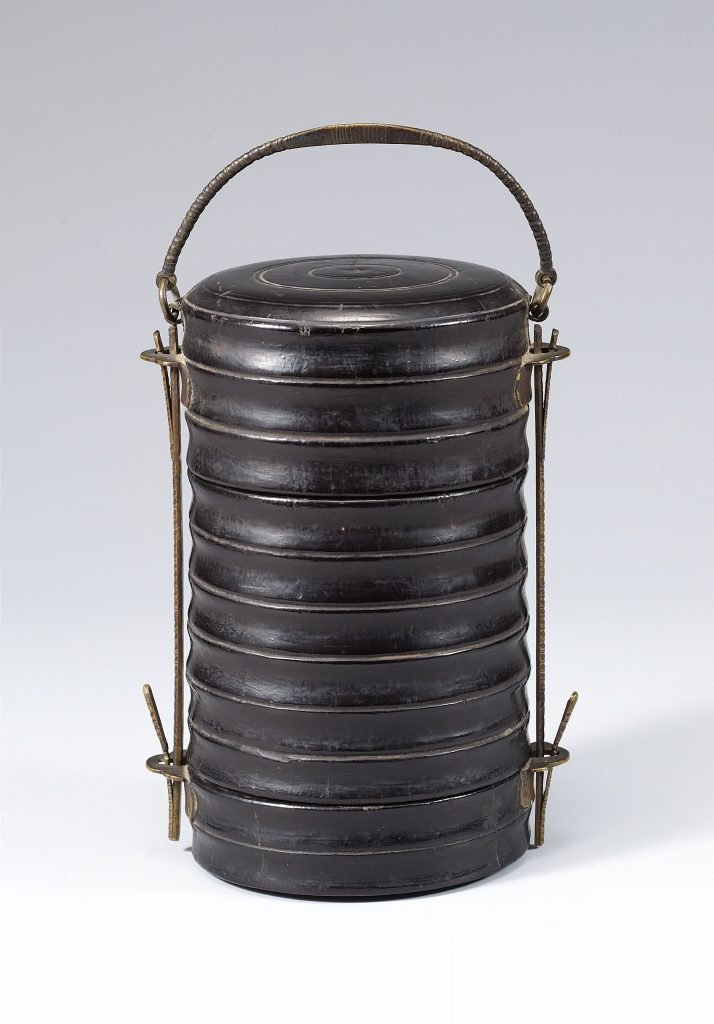
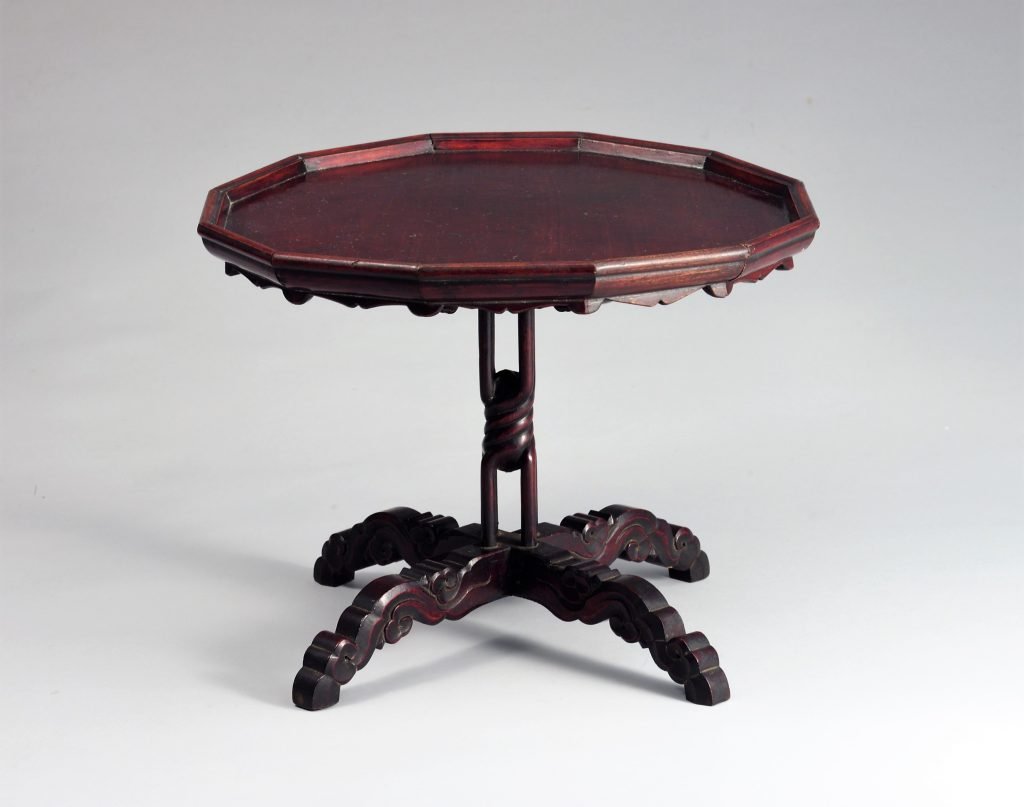
H. 26,5cm, D. 36,4cm.
This small dining table is decorated with carved cloud and scroll designs on its four legs and twelve-sided top. It is supported by a column shaped like four strings twisted together.

Joseon dynasty. H. 18,7cm, L. 28cm, W. 17,9cm.
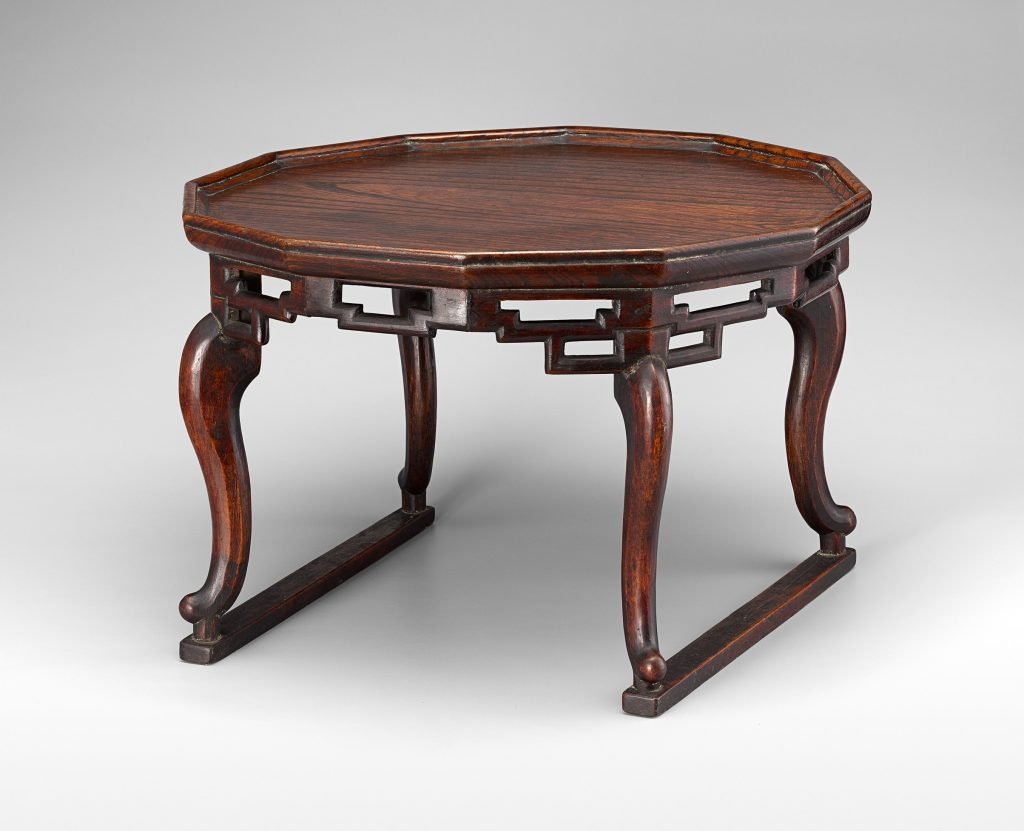
H. 28,7cm, D. 43cm.
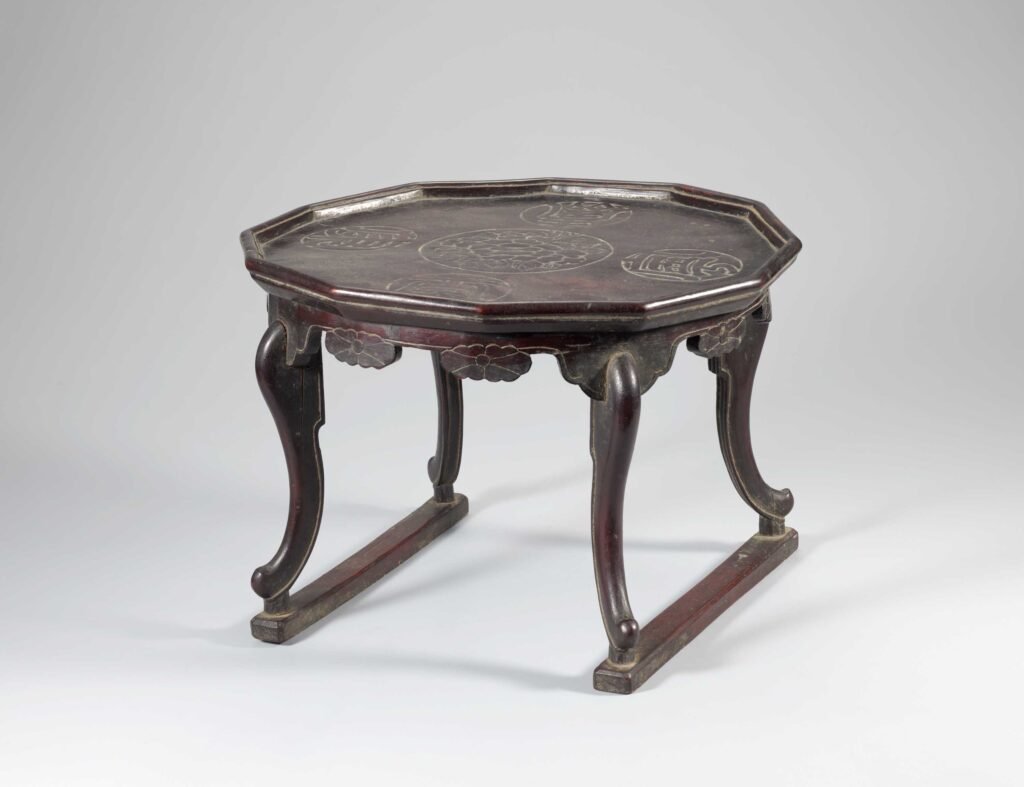
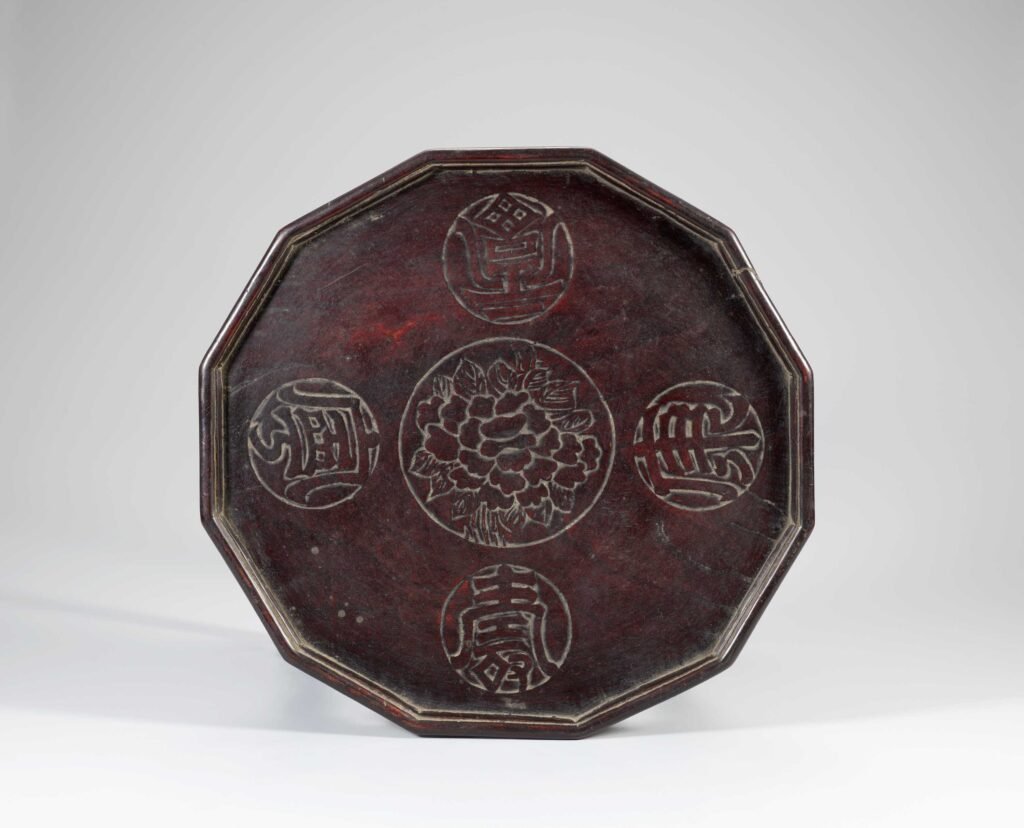
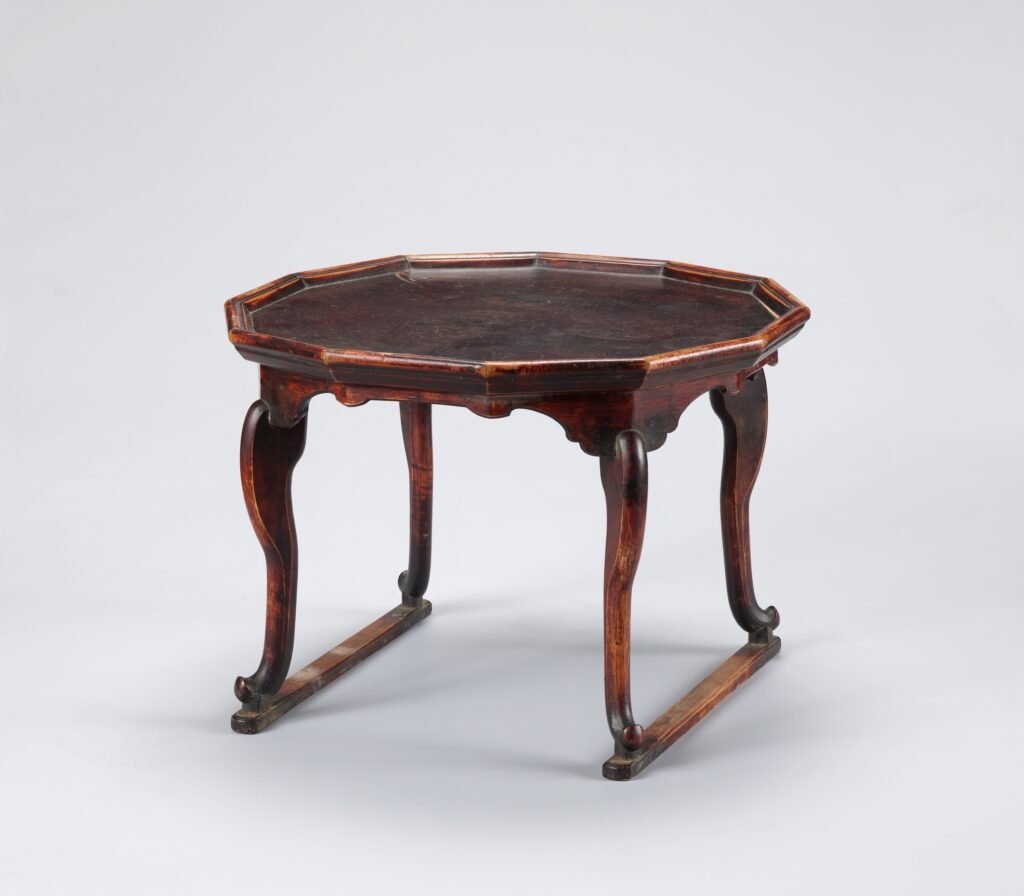
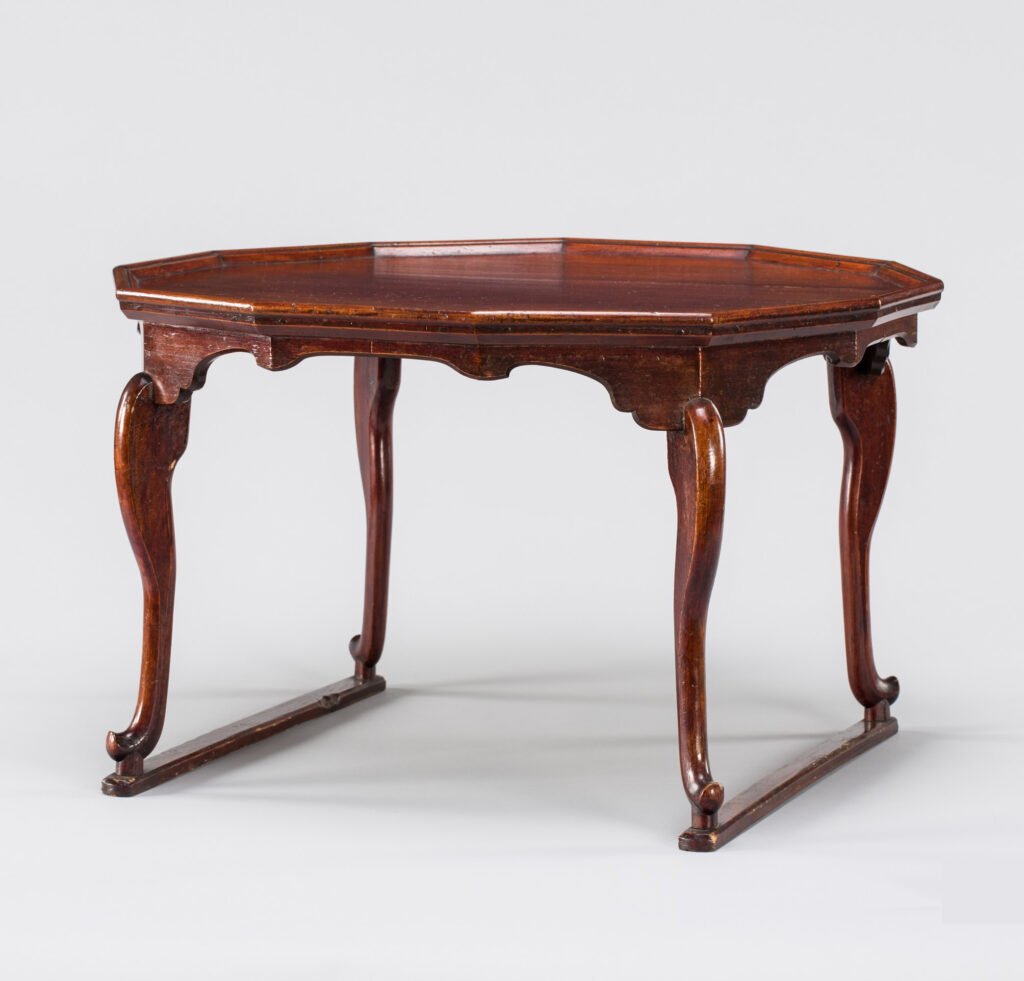
Height 42,5cm, overall diameter: 69,3cm.

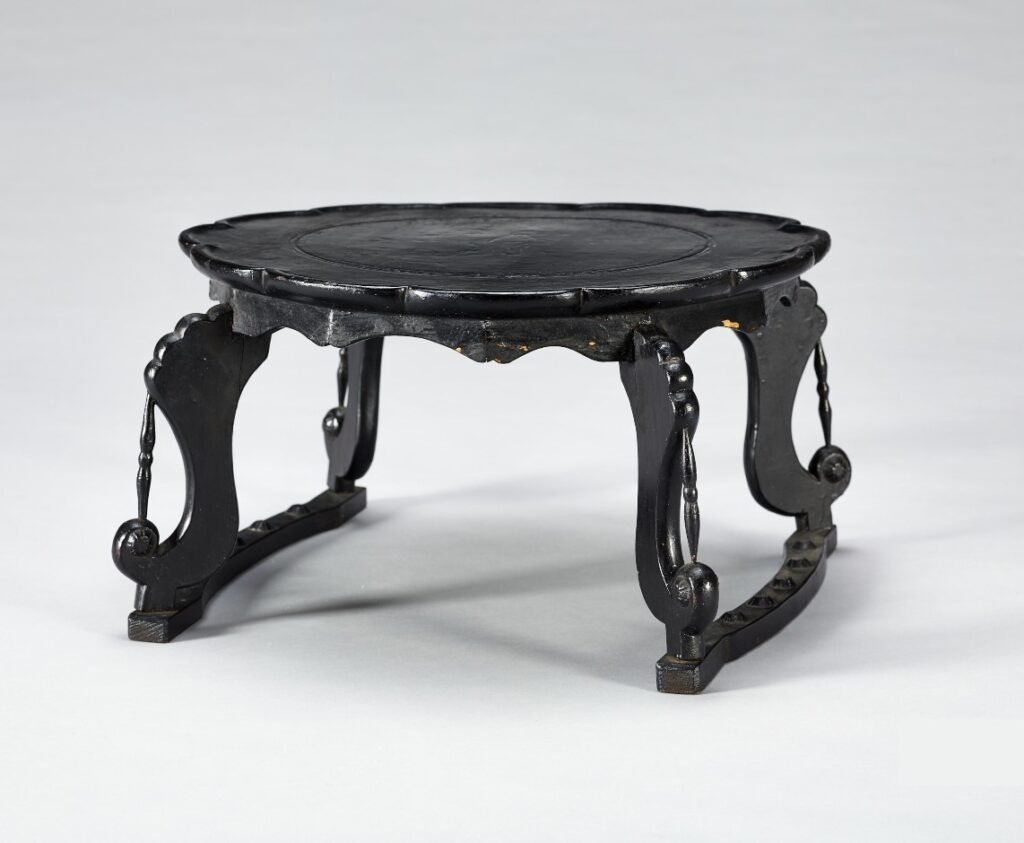
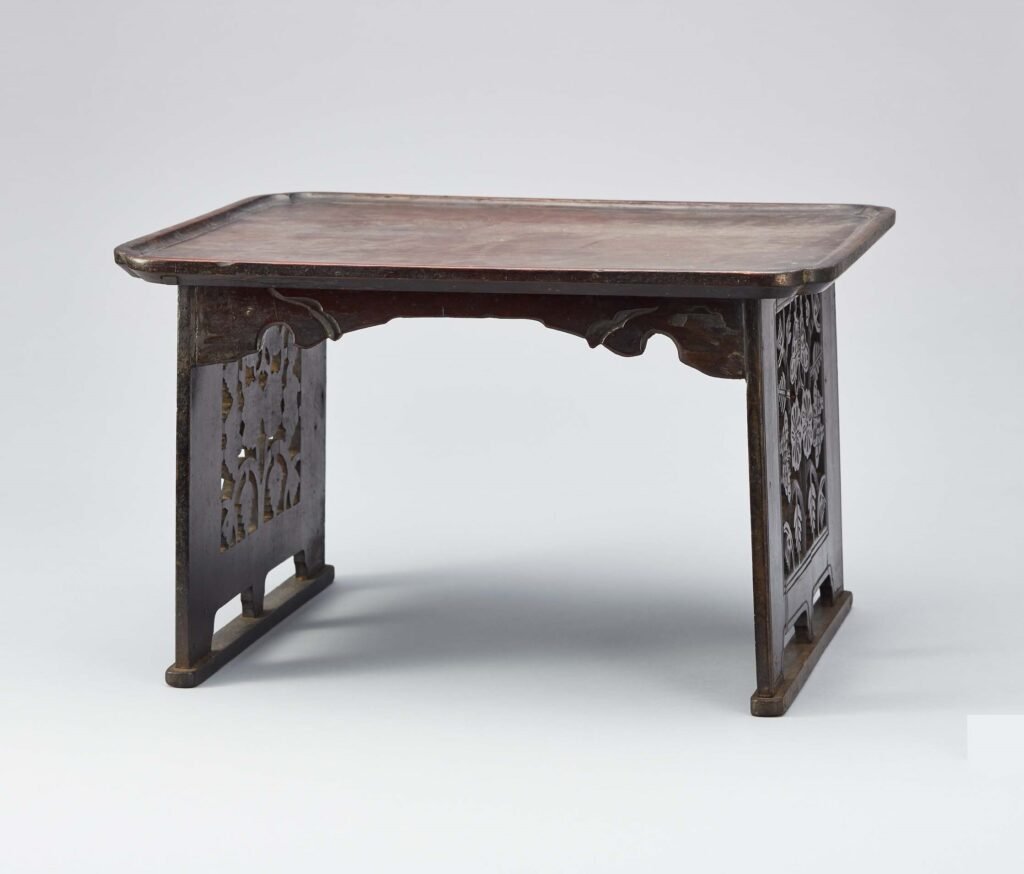
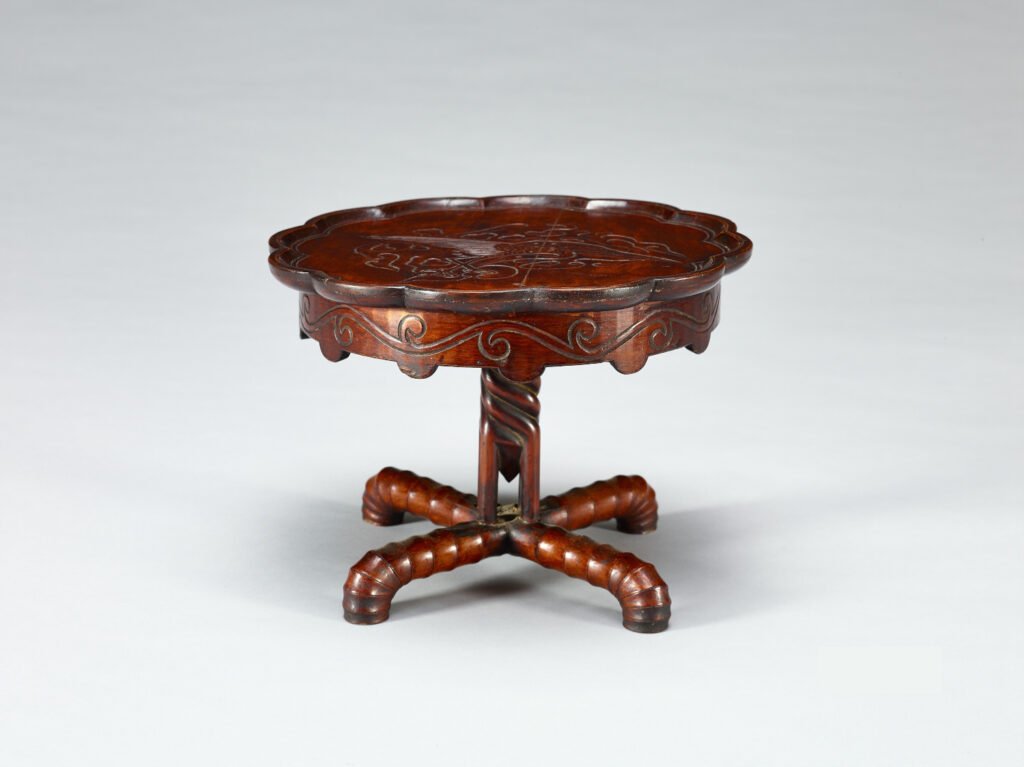
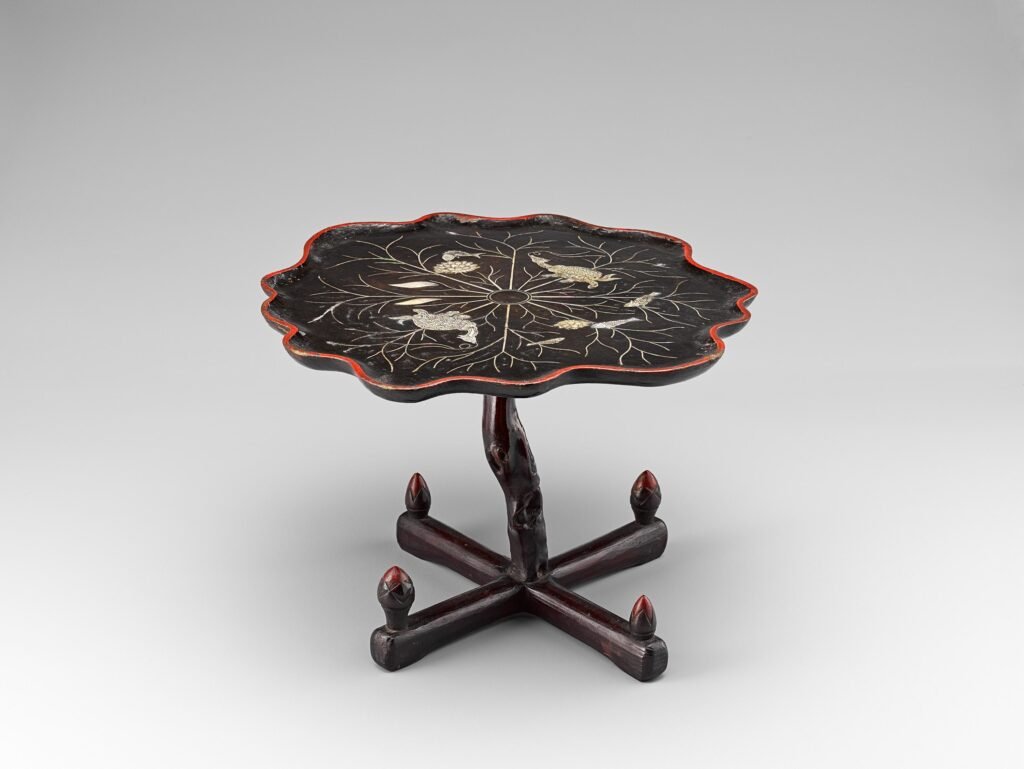
Mother-of-pearl inlay. Lacquer.
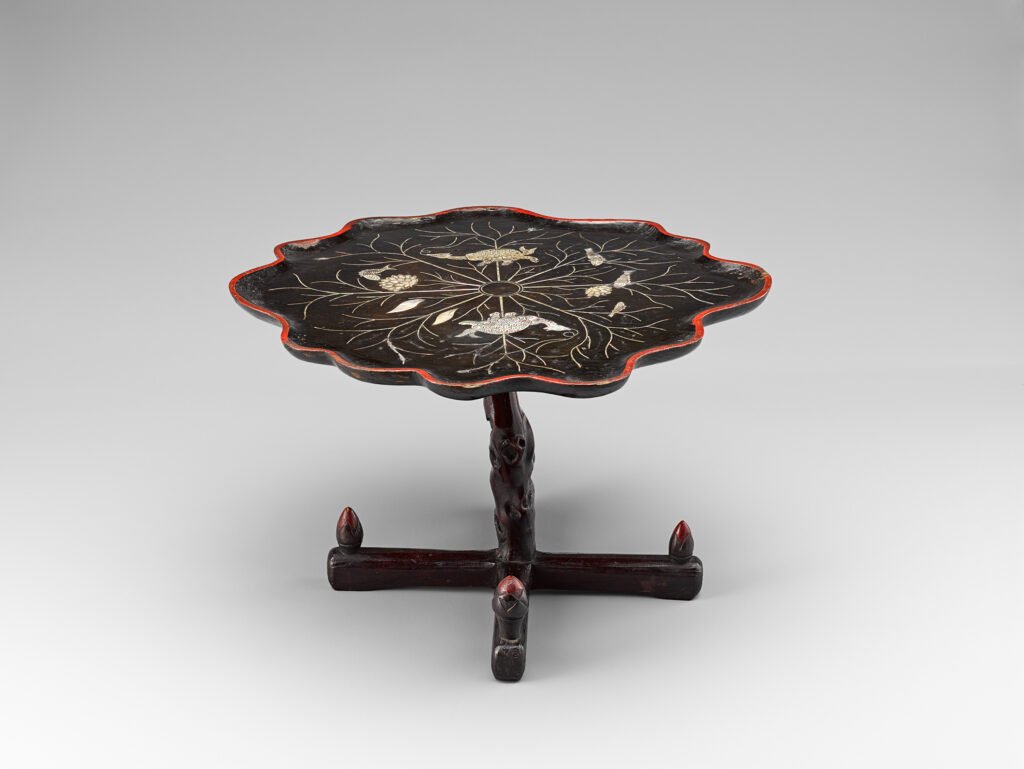

H. 29,4cm, W. 48,8cm, D. 32,4cm.

H. 13cm, D. 48,3cm
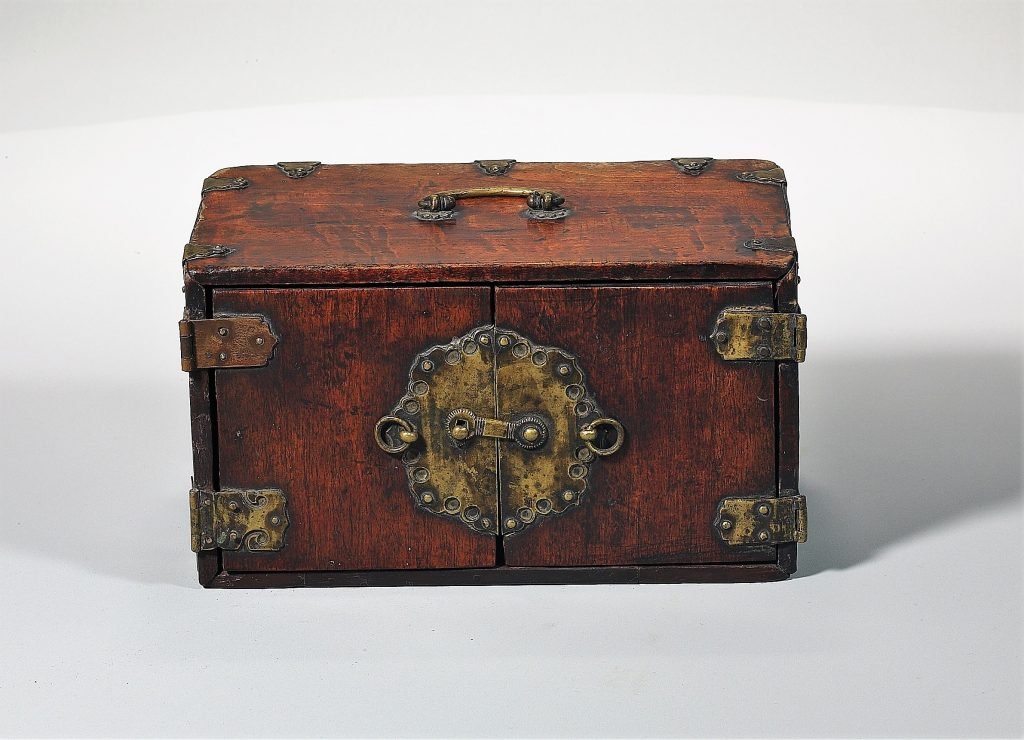

H. 11,2cm, L. 48,3cm, W. 10,7cm.
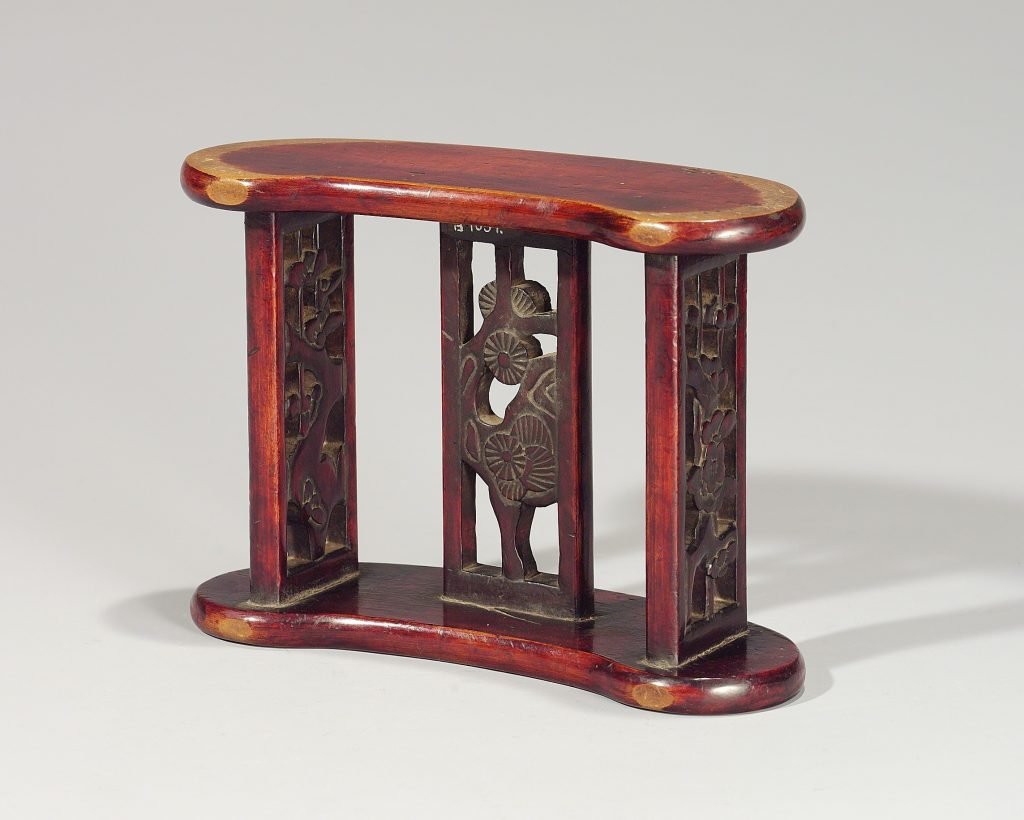
H. 13,2cm, L. 6,5cm, W. 20,5cm.
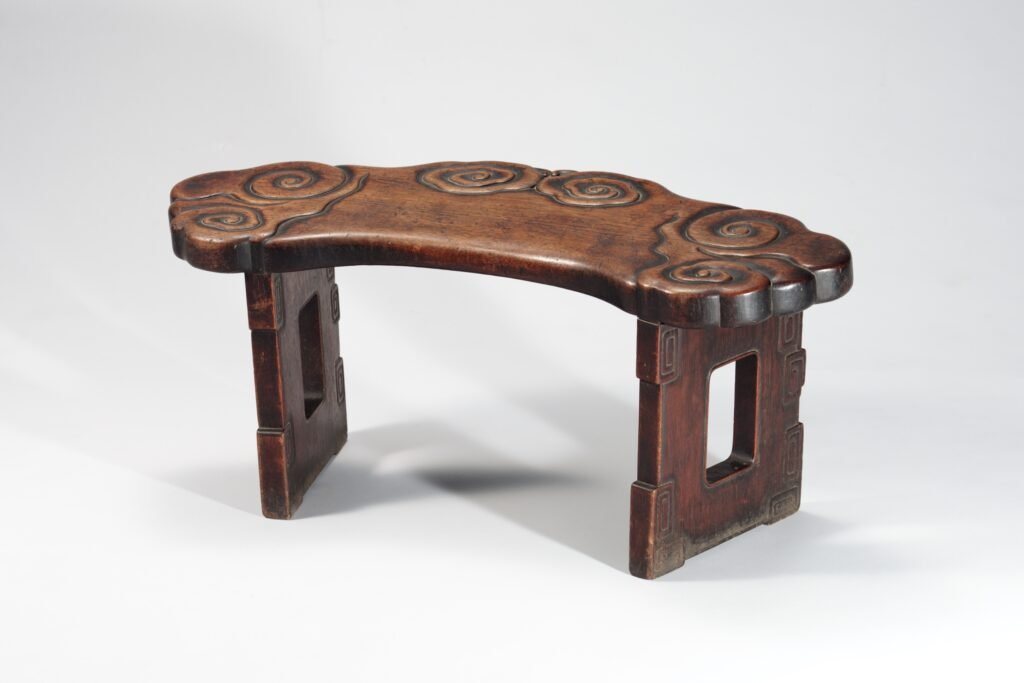

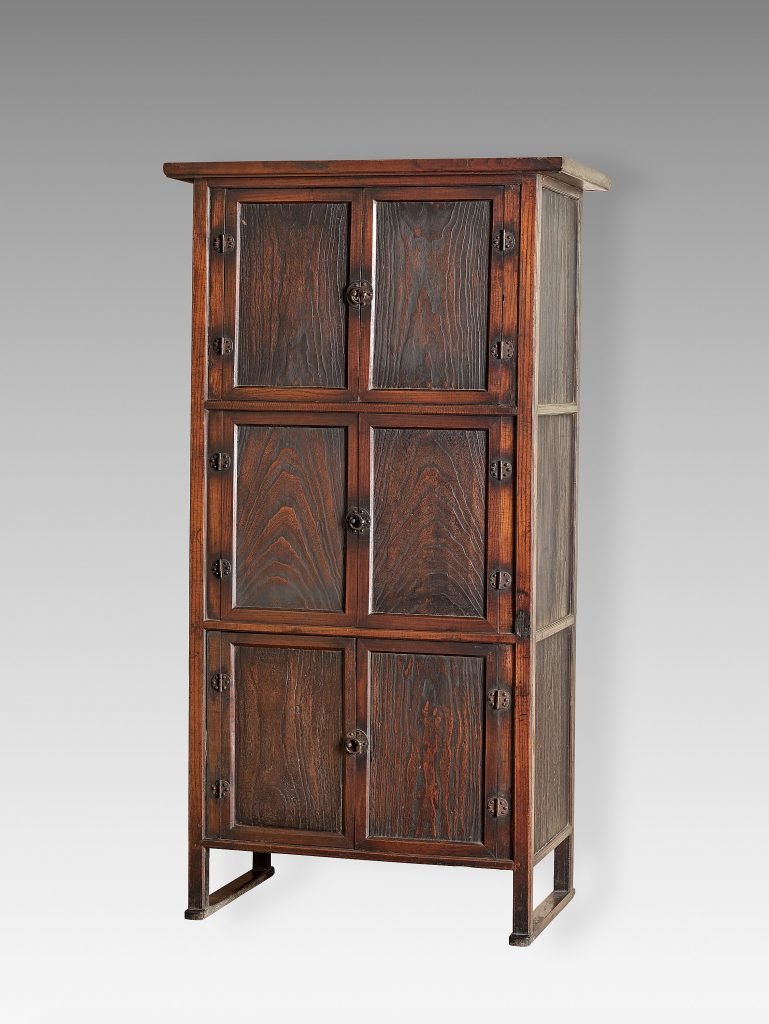
Paulownia wood. H. 133cm. During the Joseon Dynasty, bookcases were essential pieces of furniture for a sarangbang, the special room where the male head of the household would reside, study, and receive male guests. The most prestigious households had separate libraries in which to keep their books, but it was still practical and proper to have a bookcase in the sarangbang for those books that were used most frequently. This particular three-tiered bookcase exudes a simple, austere beauty, exemplifying the design standards of the Joseon era. The doors are made from the wood of the odong tree, which was seared with an iron and then scrubbed with bundles of rice straw. This process, called the nakdong method (烙桐法), removes the soft fibers from the board, leaving only the firm, hard grain of the wood. The technique, which revealed the pristine beauty of the natural wood grain, was primarily used for sarangbang furniture. Although such furniture is obviously manmade, it retains such natural beauty that we can almost feel the breath of the wood. As a central feature of a sarangbang, this type of furniture matches the dignity and nobility of any scholar.
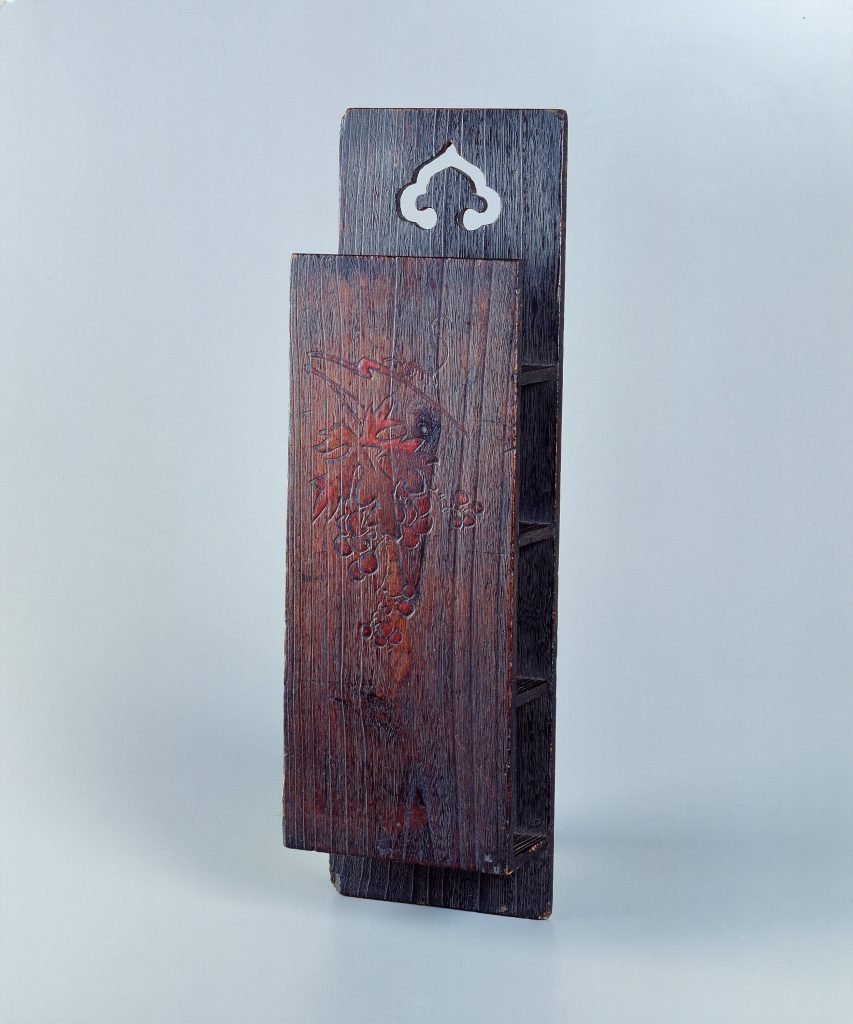
Paulownia wood. Joseon Dynasty.
H. 95cm, L. 10,2cm, W. 28,3cm

H. 12.5cm, W. 20cm.
Hwagak refers to a Korean traditional decorative technique whereby ox-horn was flattened into paper-thin half-transparent plates, after which patterns were drawn inside the plates with mineral dye, and then the plates were attached to items made with wood or bamboo. To make this brush container, ox-horn plates were adjusted to fit the size of the container’s faces, and then attached to them. The front and back of the container feature drawings of a pine tree, a magpie, a tiger, bamboo and a crane, while the two sides exhibit a chrysanthemum, a peach, a pine tree and a crane.
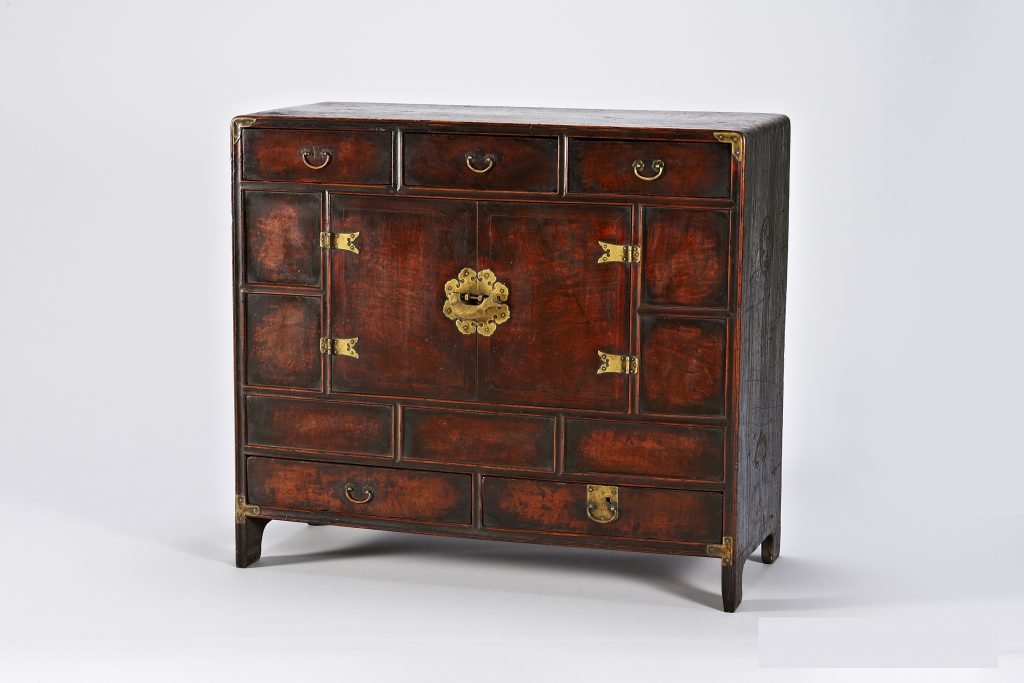
Could also be used as a document chest. Joseon dynasty.
H. 77,2cm, W. 87,3cm, D. 37cm.
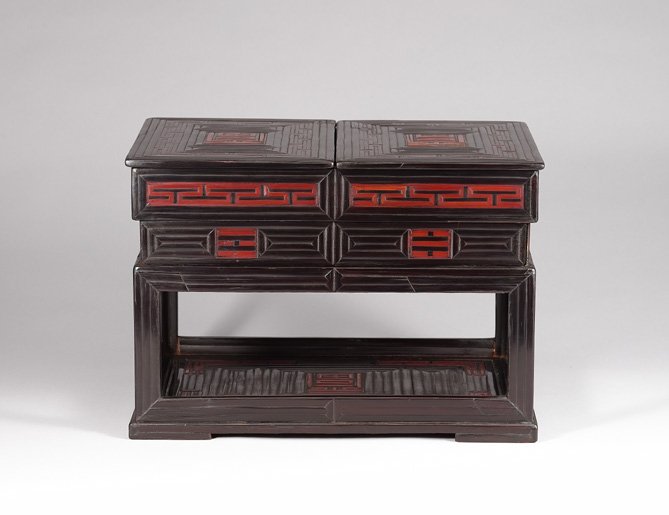
H. 28,2cm, W. 43.3cm, D. 27,2cm.
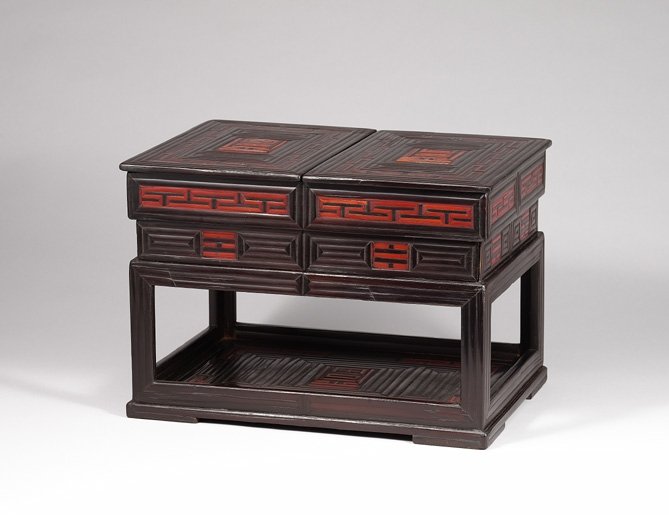
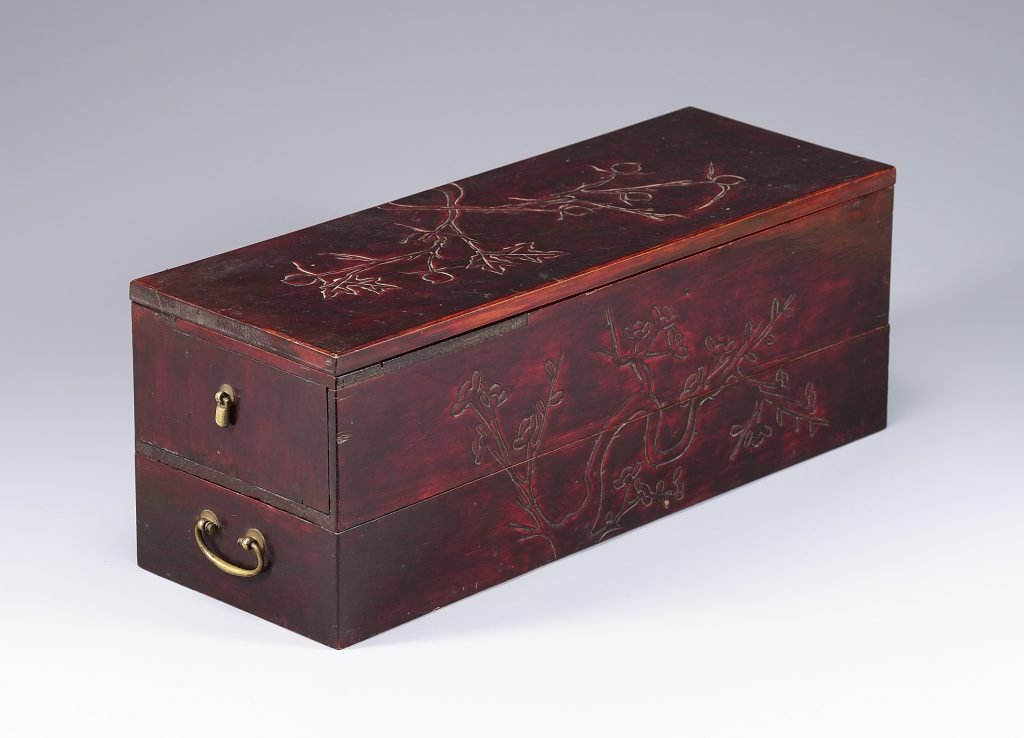
Joseon Dynasty.

H. 5cm, W. 18,1cm, D. 29,3cm.
This wooden box was used for storing documents. Steel pieces were used to fix the corners of this box. The shapes of the lid hinges and the lock accessory are unique.
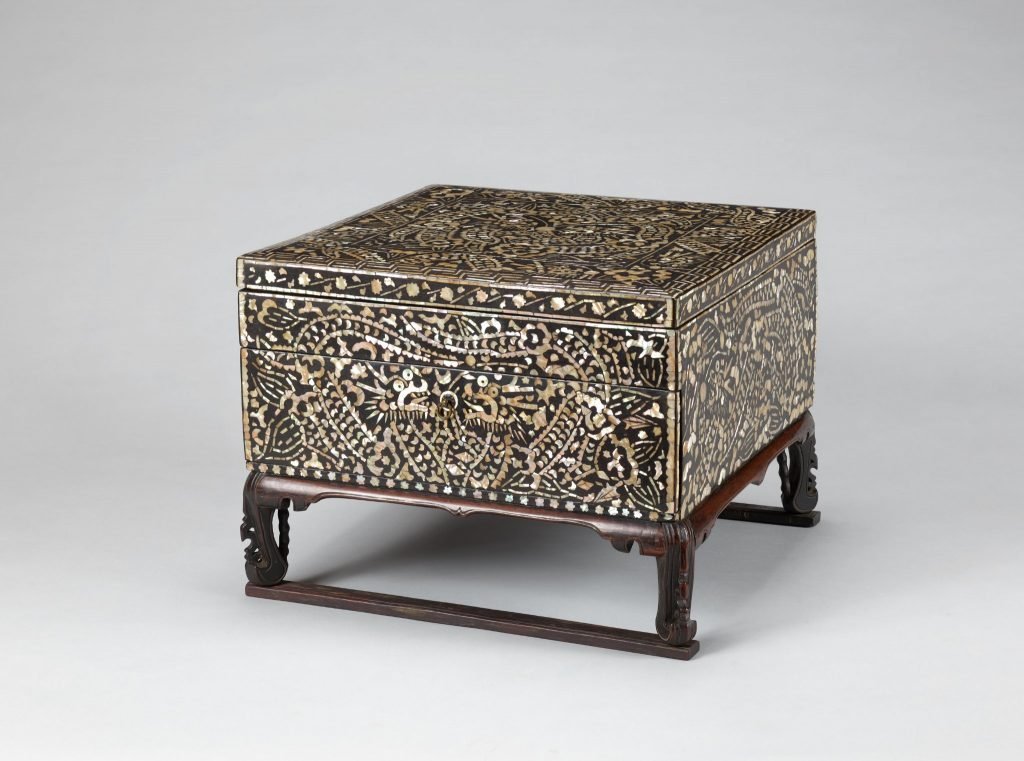
Joseon Dynasty, wood and mother-of-pearl inlay.
19th century.
H. 32,7cm, L. 42,4cm, W. 42cm.
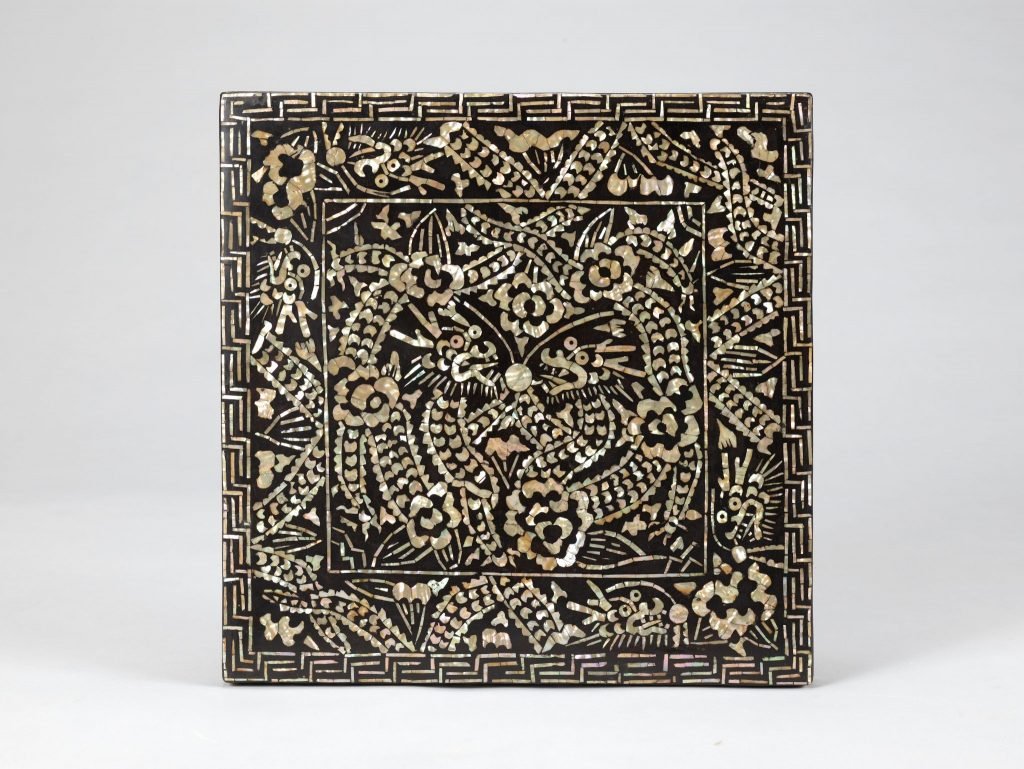
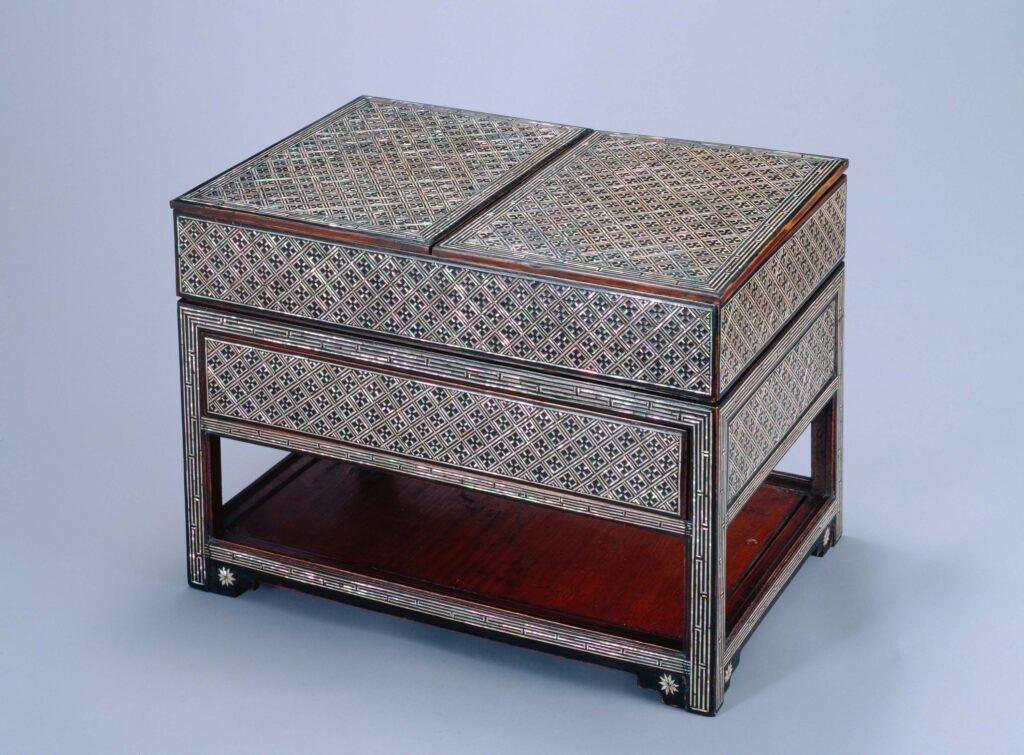
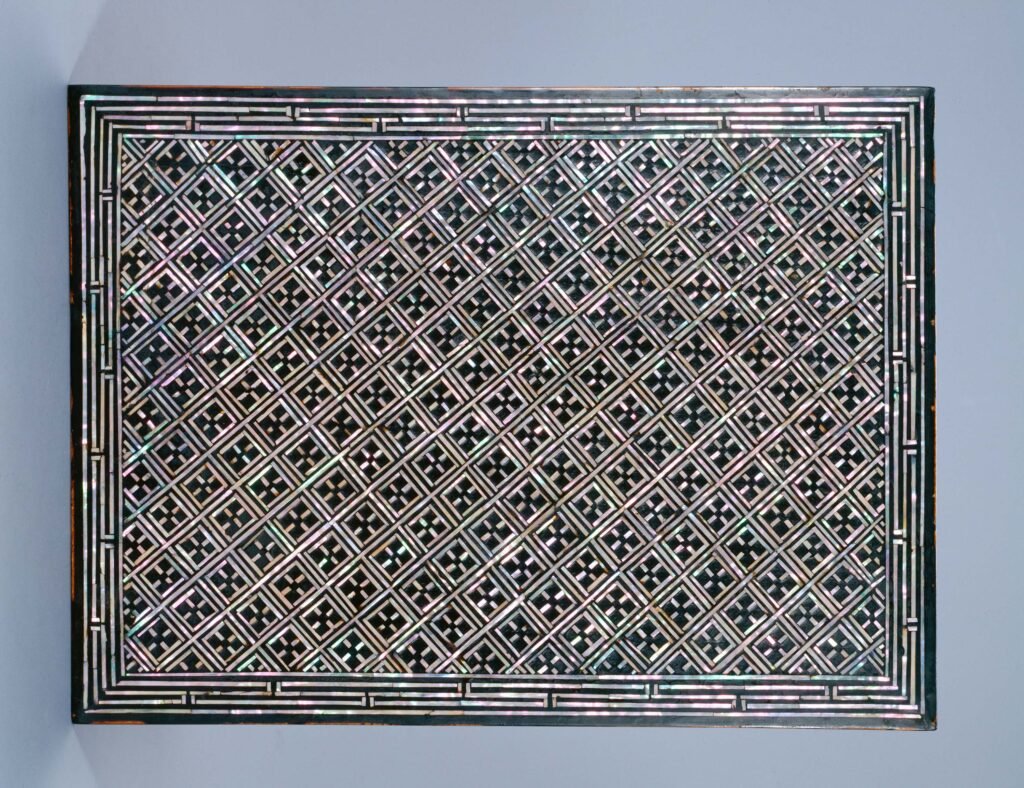

Wood and lacquer.
H. 24,7cm, D. 32cm.
This table is called a gaedari soban or gujokban, literally meaning ‘a dog-legged dining table’ in Korean, as its legs resemble those of a dog. The center of the top is decorated with the Chinese character “bok” (福, good fortune) inlaid with mother-of-pearl. The character is surrounded by auspicious designs, such as cranes and peaches, encircled with a stripe of a saw tooth design.
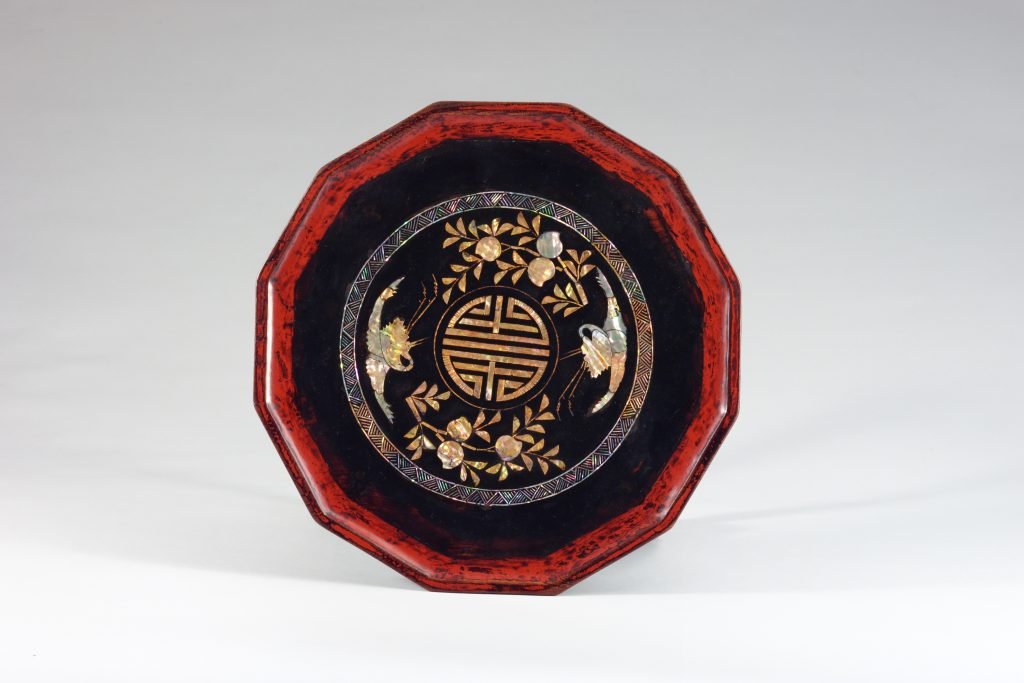

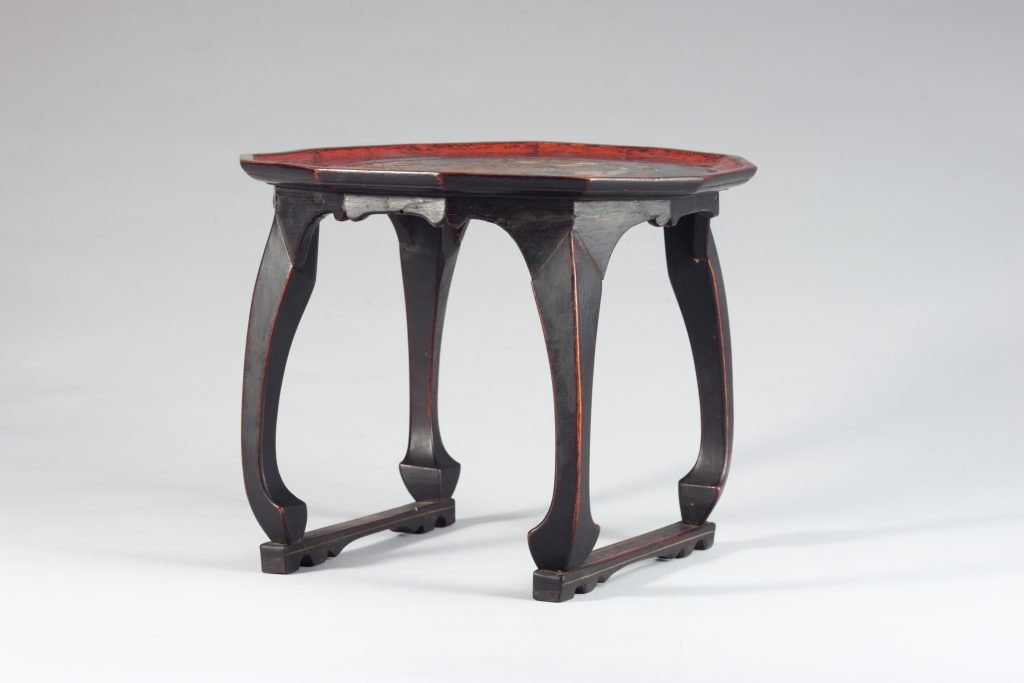
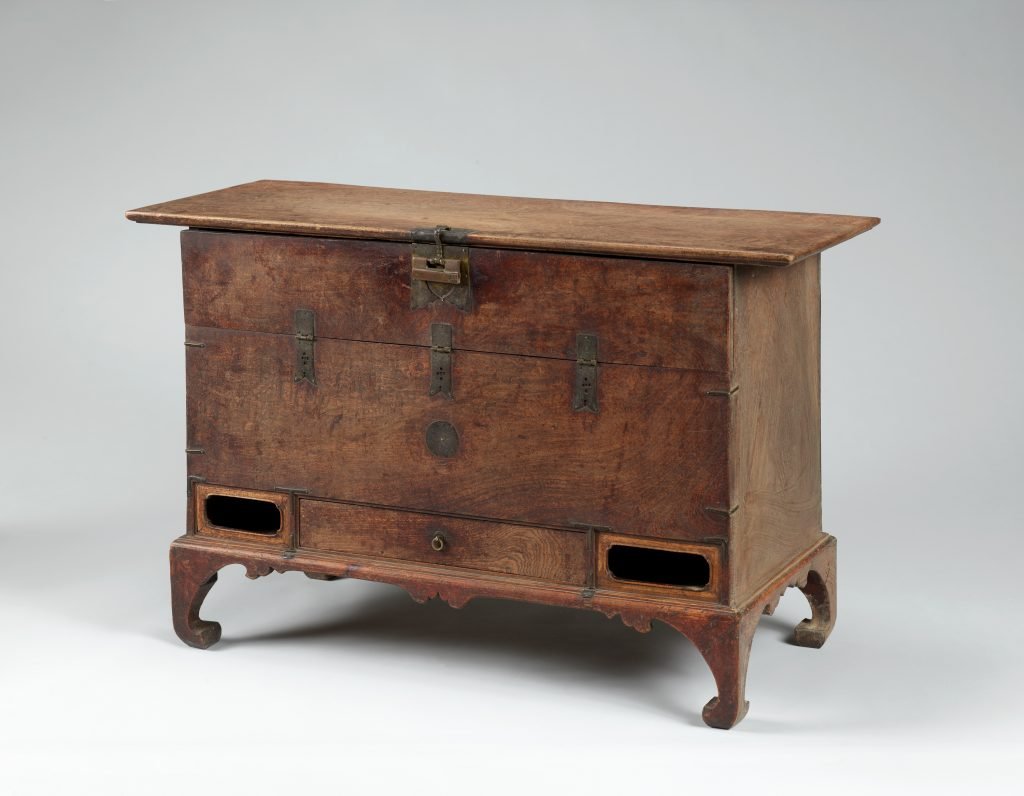
Dated from the Japanese occupation.
H. 62,5cm, W. 100cm, D. 38cm.

Bone, Horn and Shell – Lacquerware inlaid with mother-of-pearl.
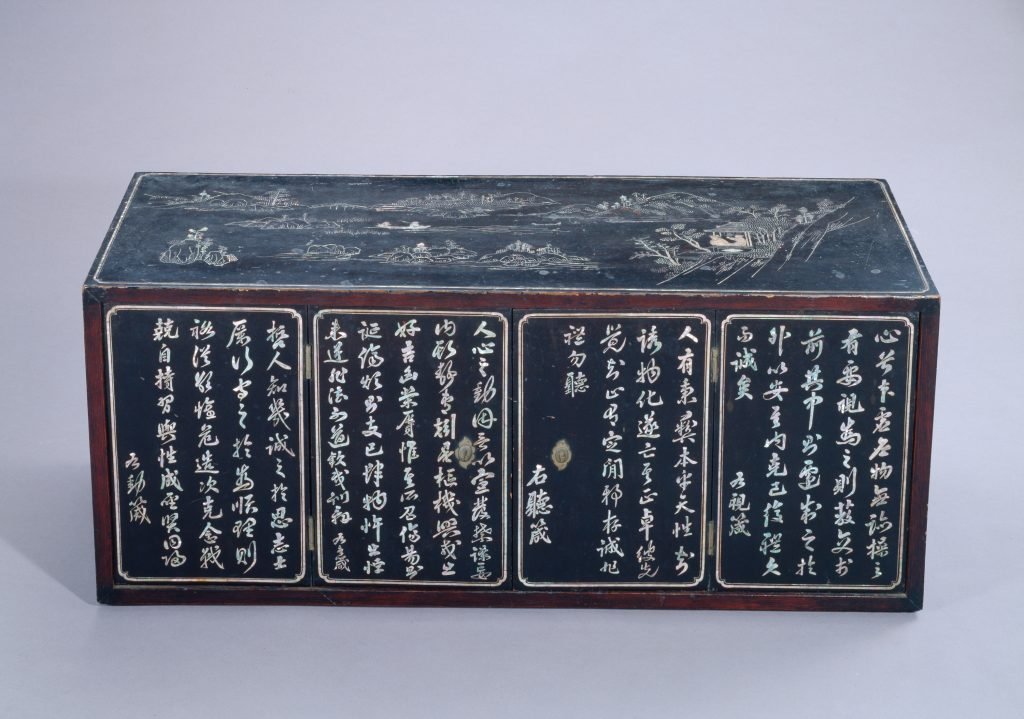
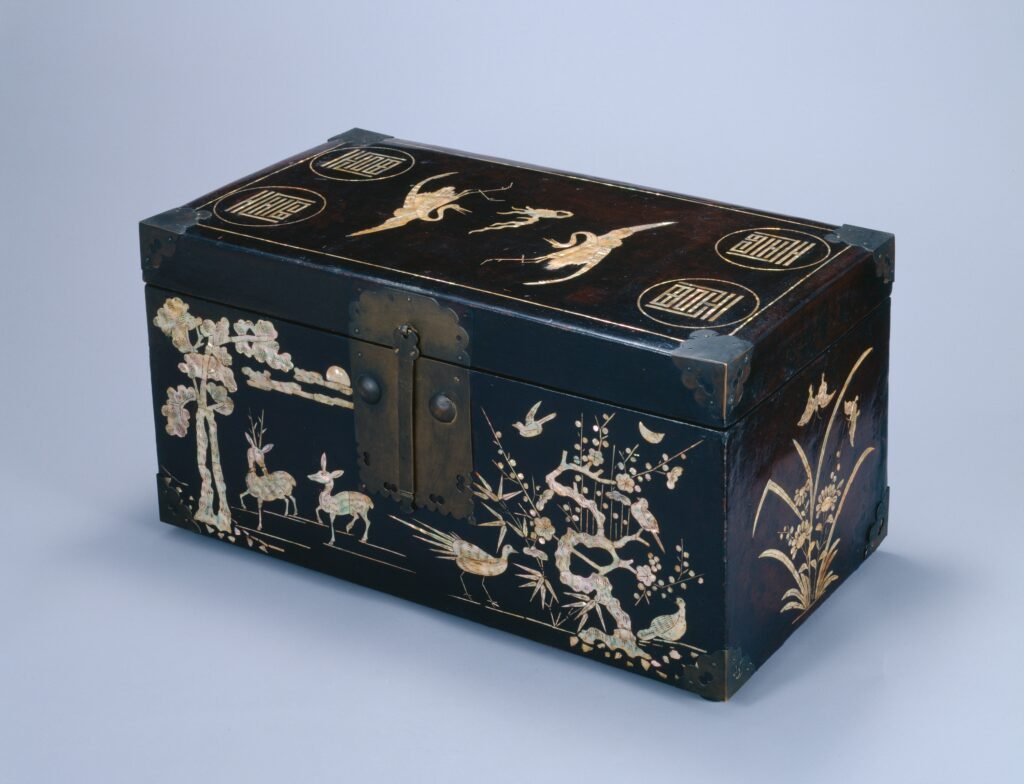
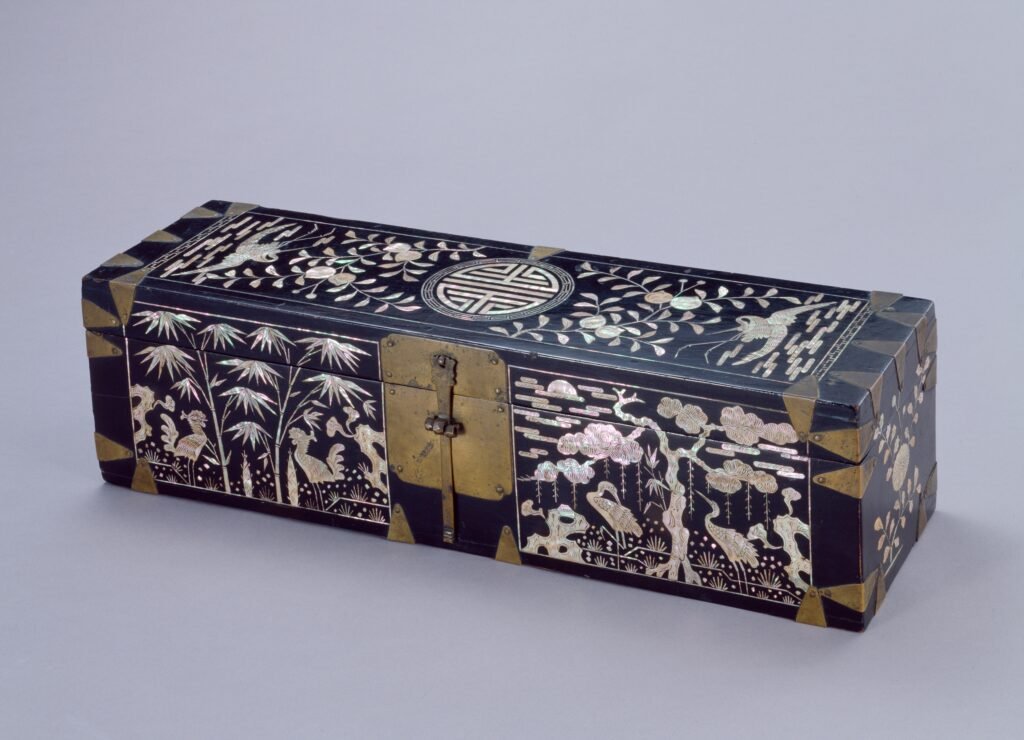

H. 15,8cm, W. 50cm, D. 15,8cm
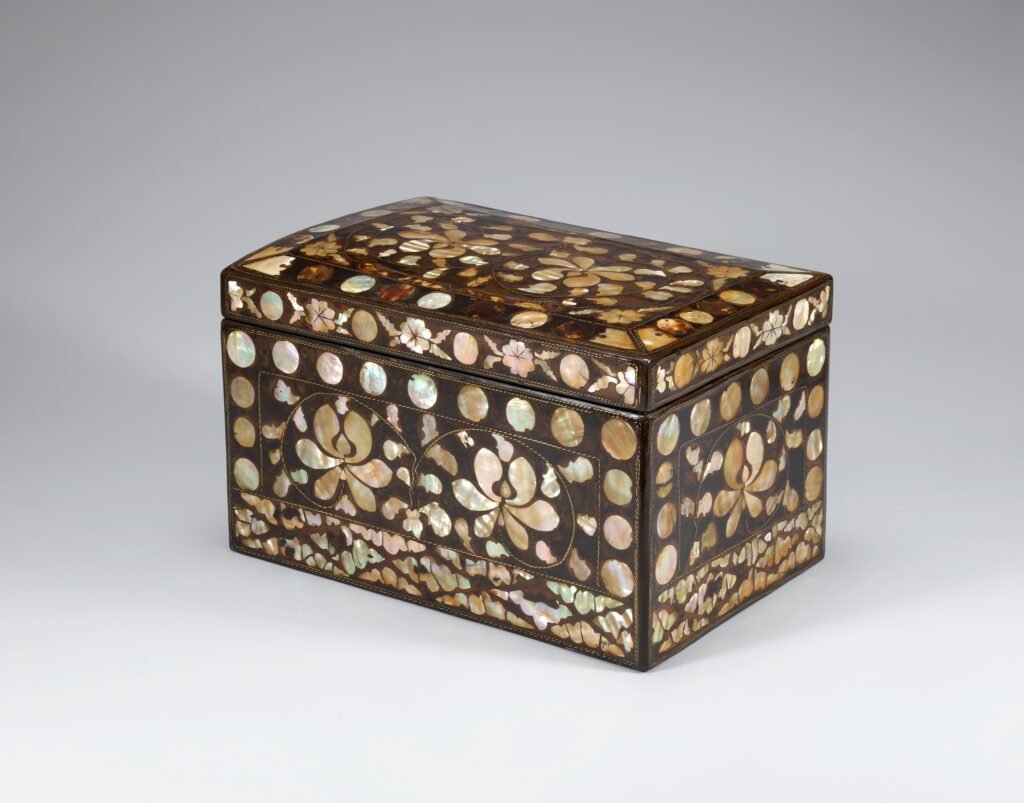
H. 19,4cm, W. 32,1cm, D. 20,9cm

H. 10cm, W. 27,5cm, D. 27,5cm
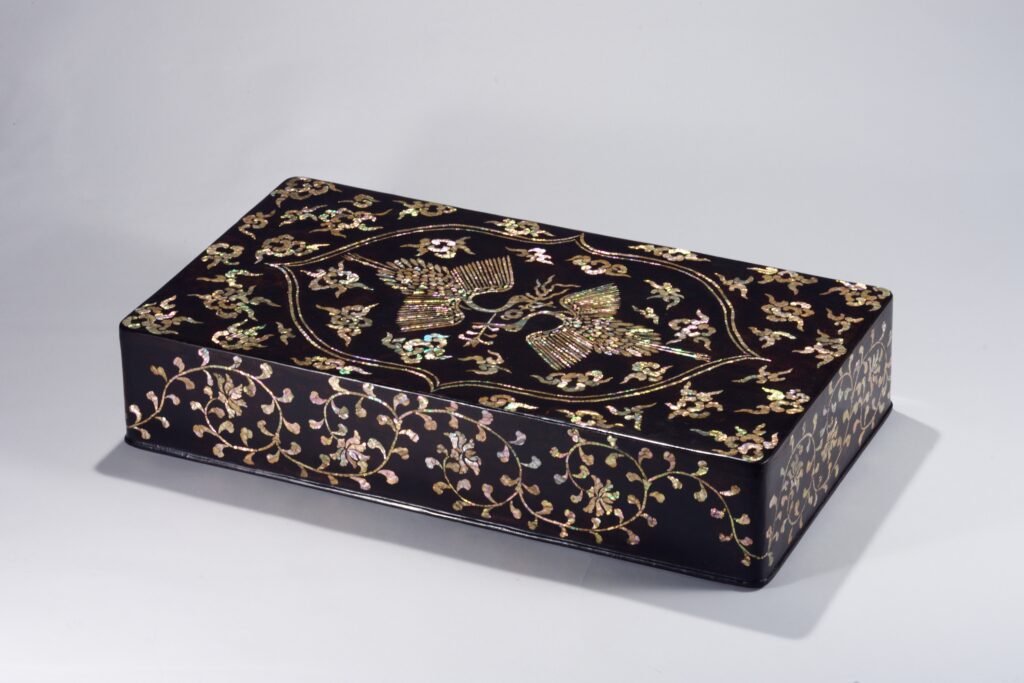
19th century.
H. 16,1cm, W. 81,8cm, D. 45,1cm.
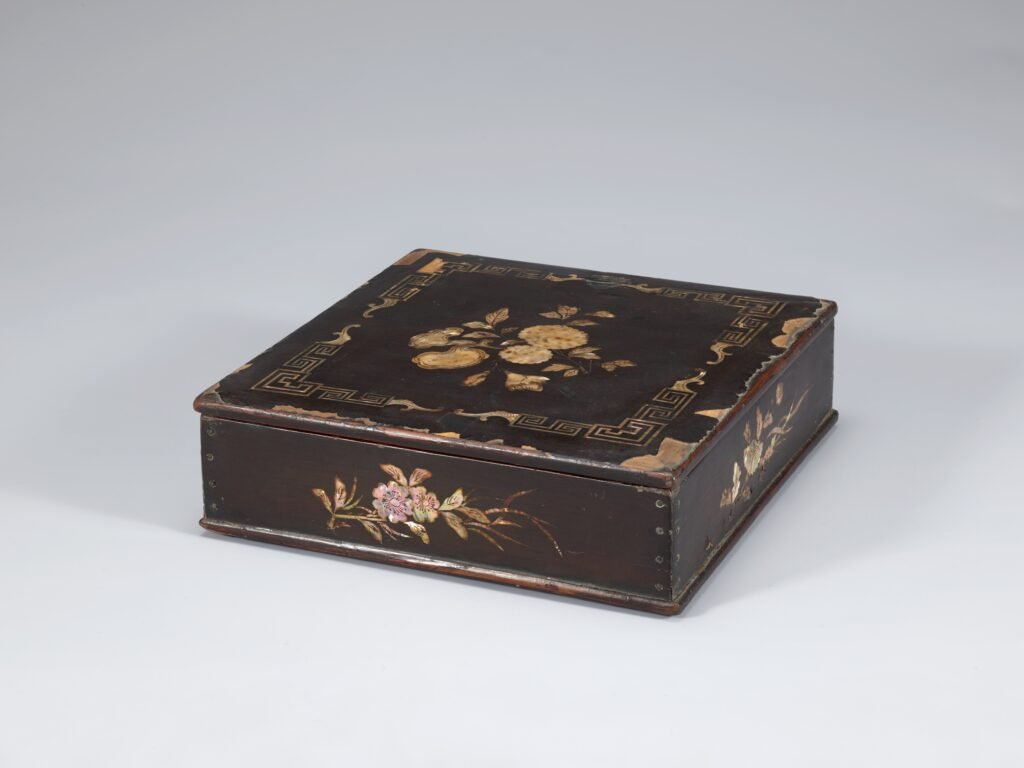
H. 5,5cm, W. 18,5cm, D. 18,5cm.
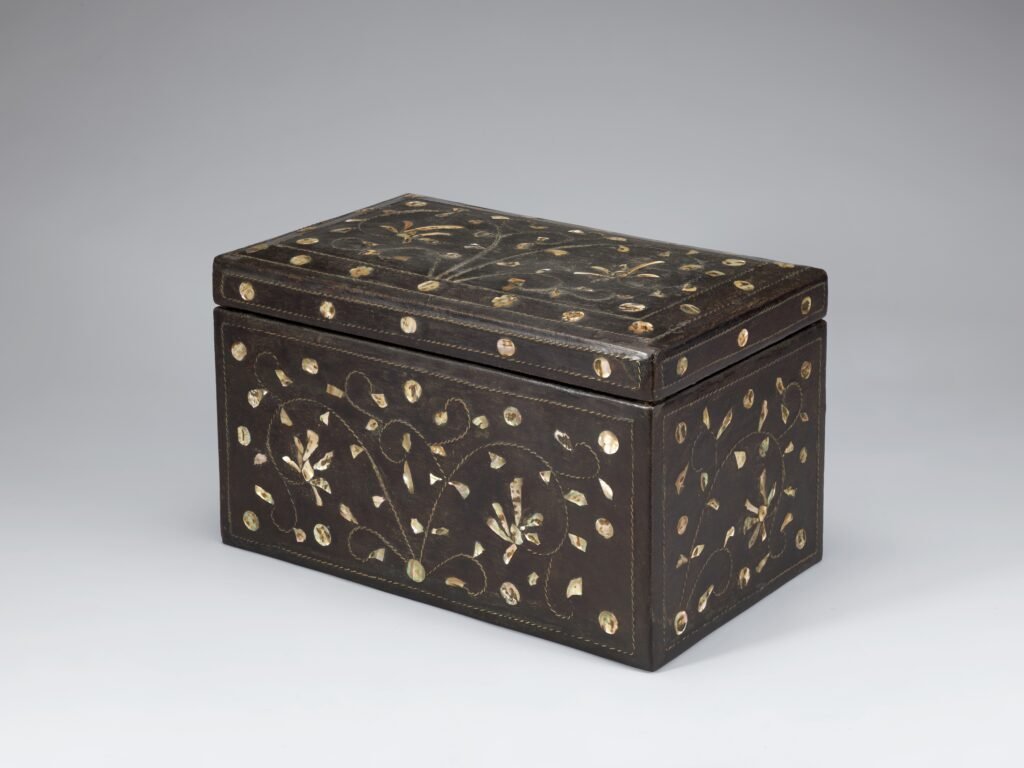
H. 20,3cm, W. 51,2cm, D. 19,7cm.
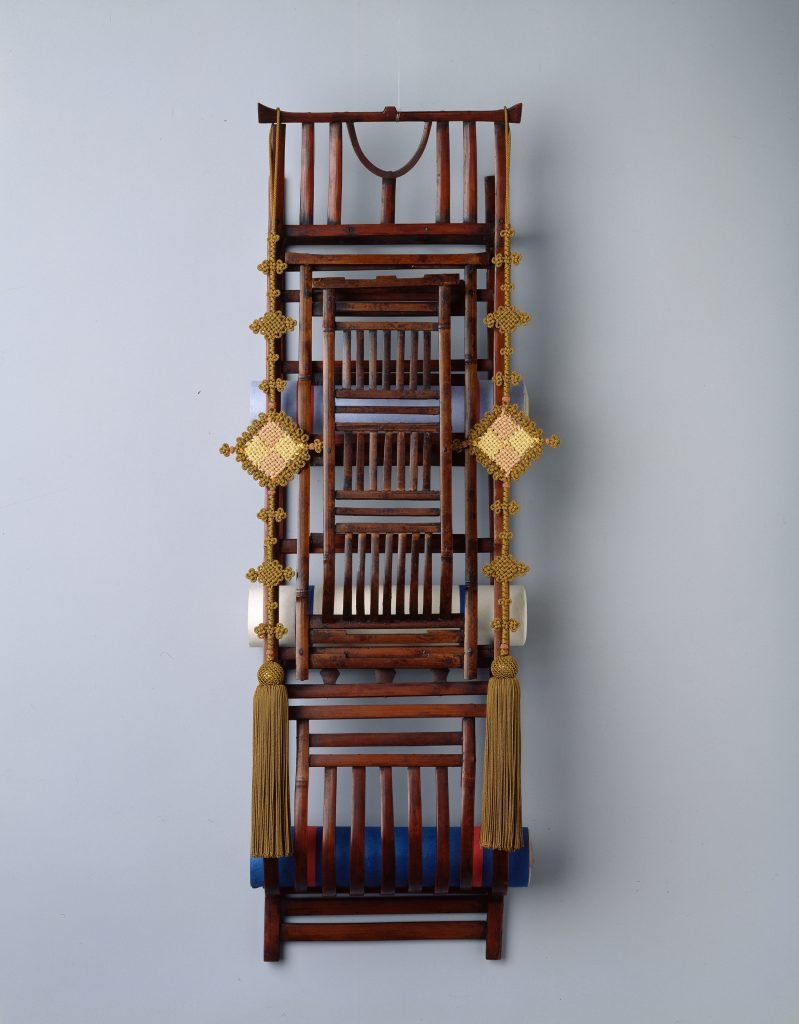
77,7cm high, 22,4cm wide, 22.0cm wide, 11,2cm long
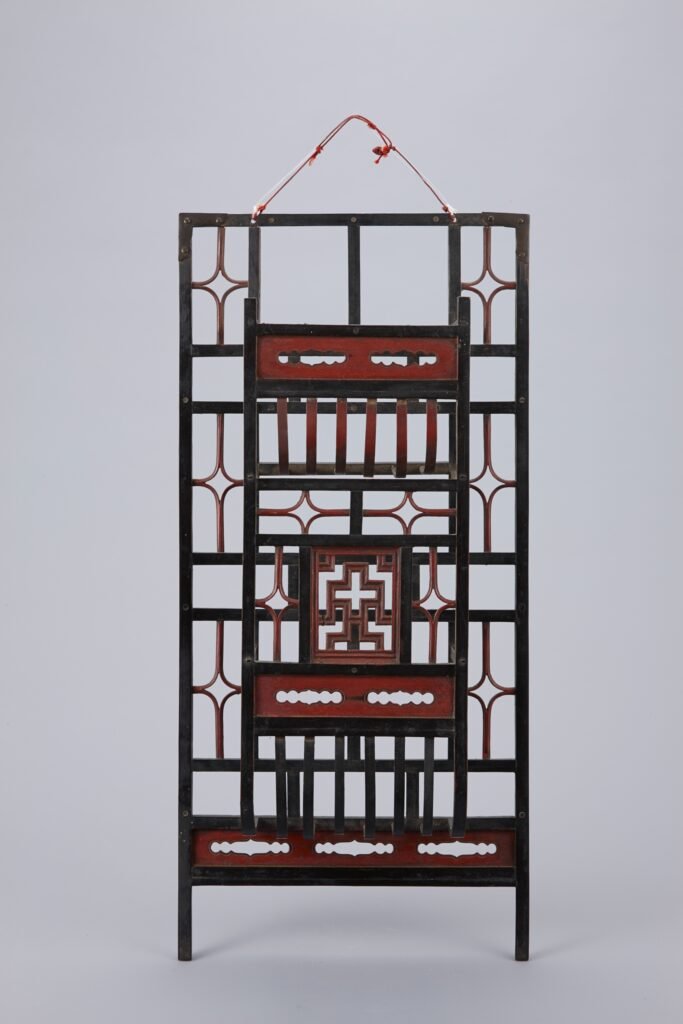
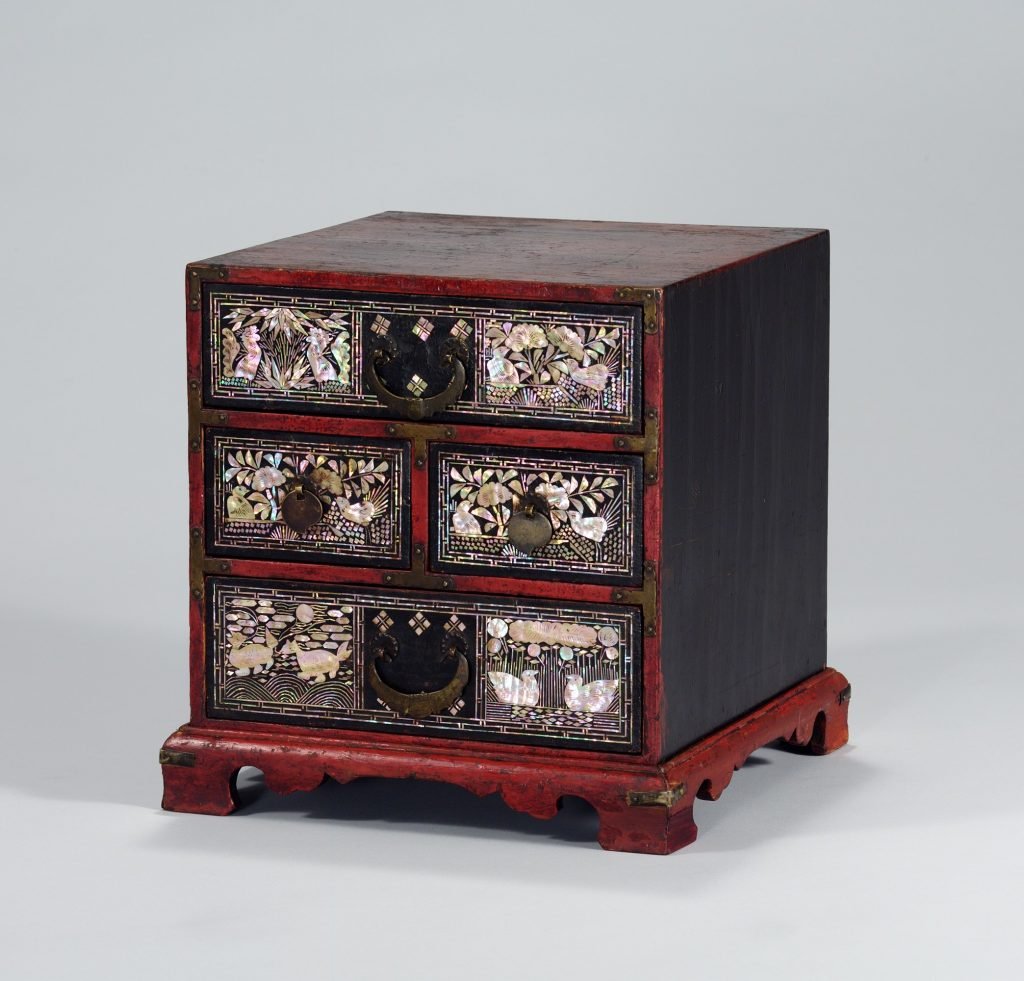
Mother-of-pearl comb box,
Width 27,1cm, Length 25,6cm, Height 27,1cm.
A comb is a piece of furniture for women, and is a container for storing cosmetic tools such as combs, hair ornaments, and mirrors, and a toebalnang (退髮囊), an oil paper that collects hair that falls out when combing.
It is characterized by having many drawers because of the function of storing small tools separately. This comb consists of three drawers and is painted red as a whole.
The front side of the drawer is decorated with mother-of-pearl using the mother-of-pearl technique, befitting female furniture.
The patterns of mandarin ducks and peonies seen here symbolize conjugal love, fertility, prosperity, and prosperity, and it is clear at a glance that the comb was a prop for women.
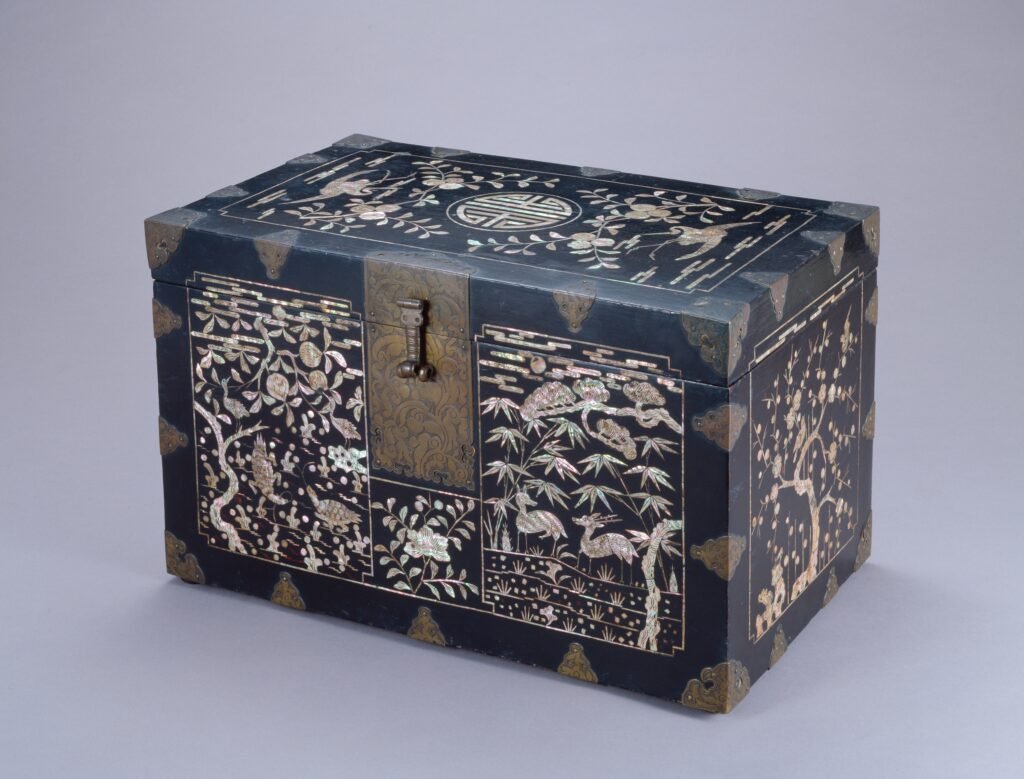
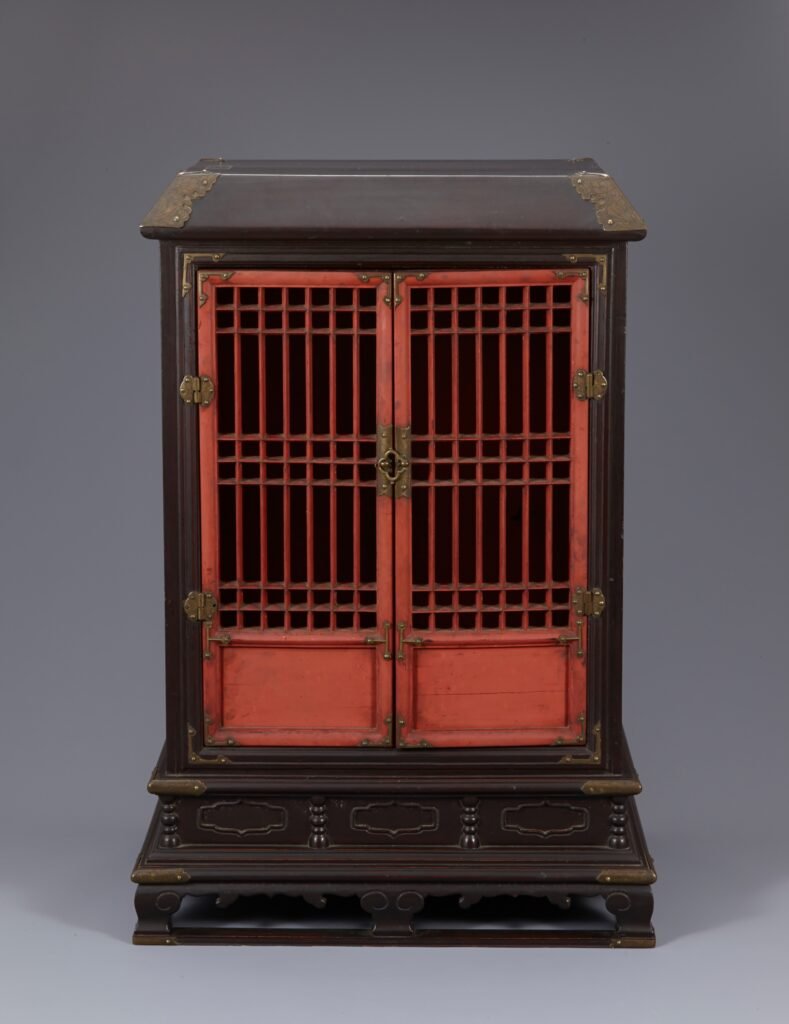
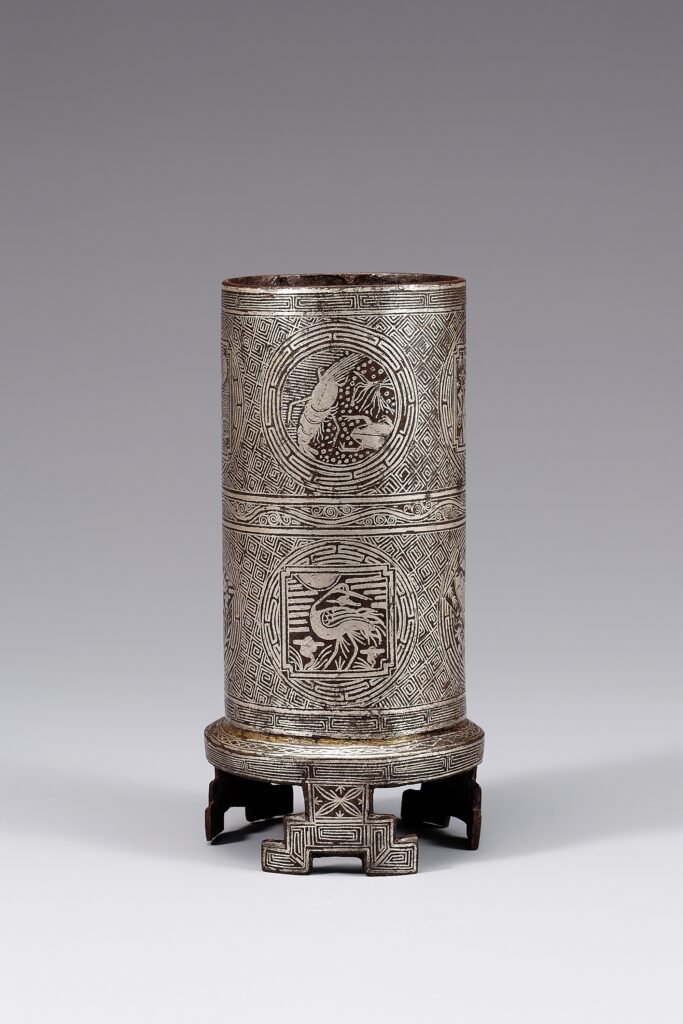
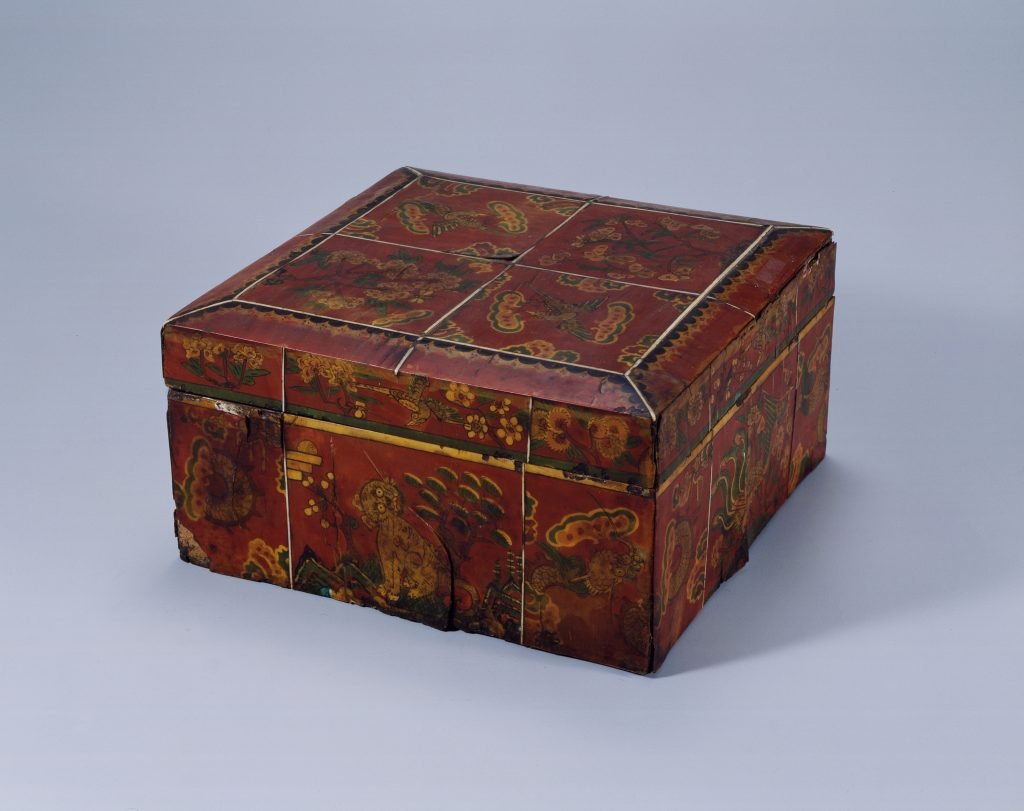
H. 13,2cm, L. 24,3cm, D. 24,3cm.
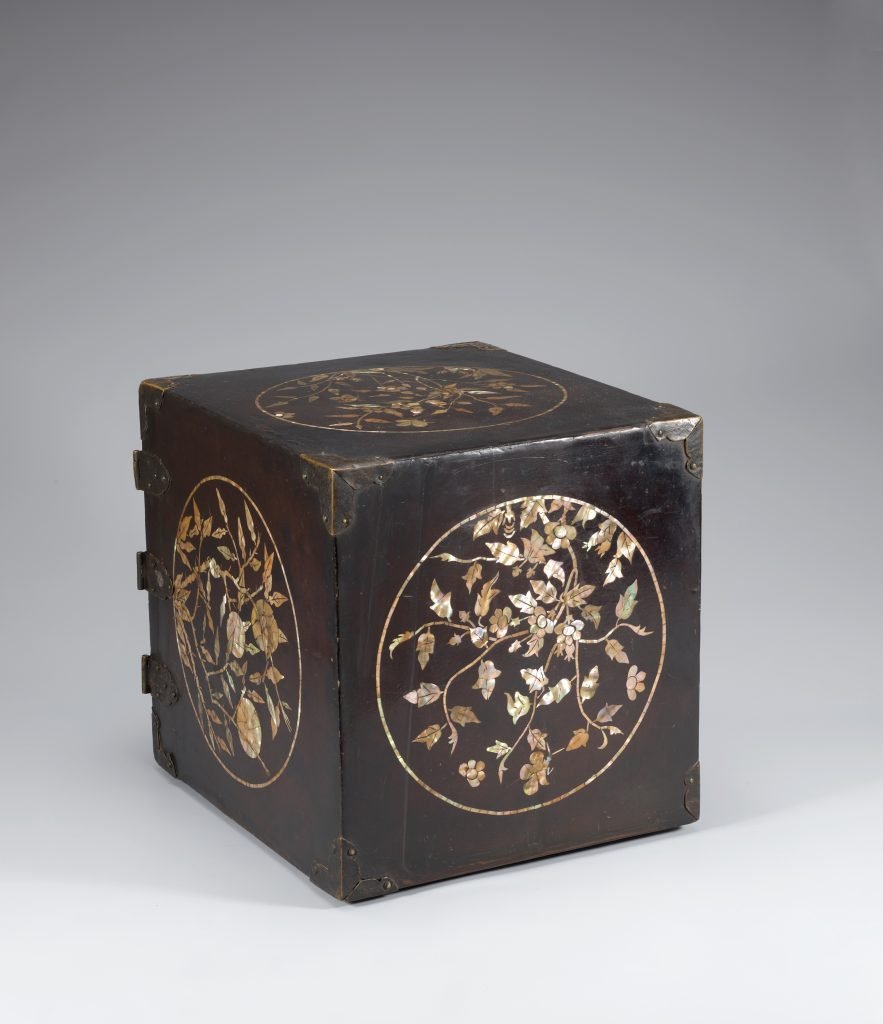
H. 31,9cm, L. 33,7cm, W. 29,6cm.
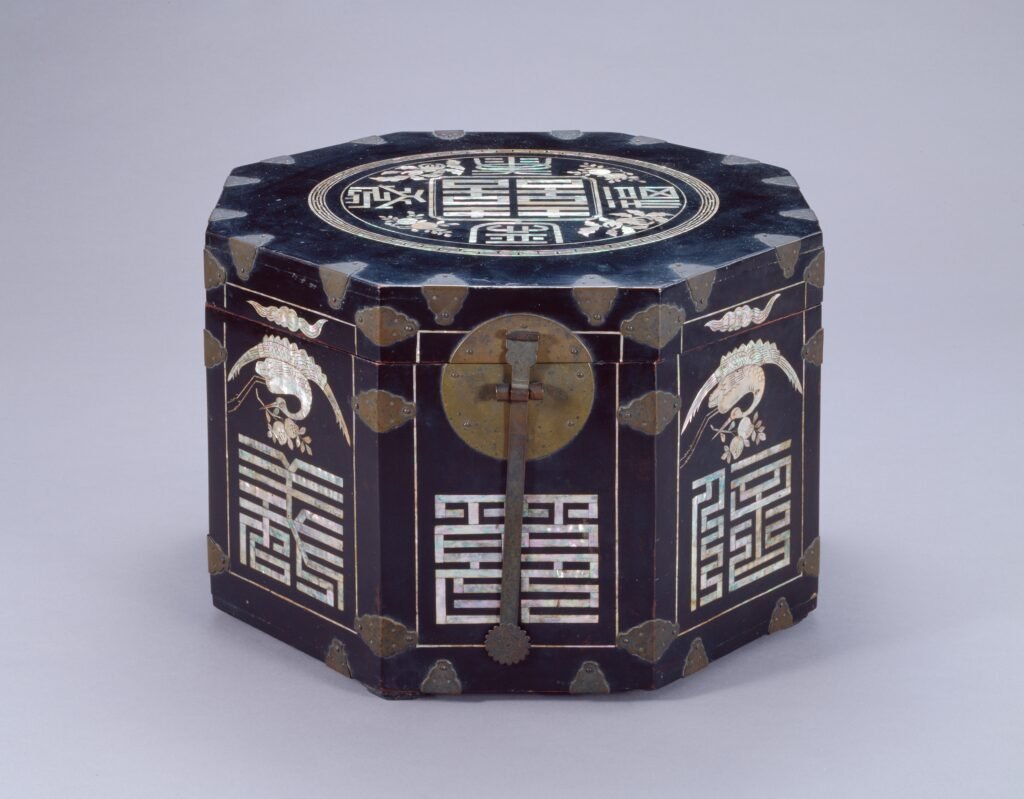
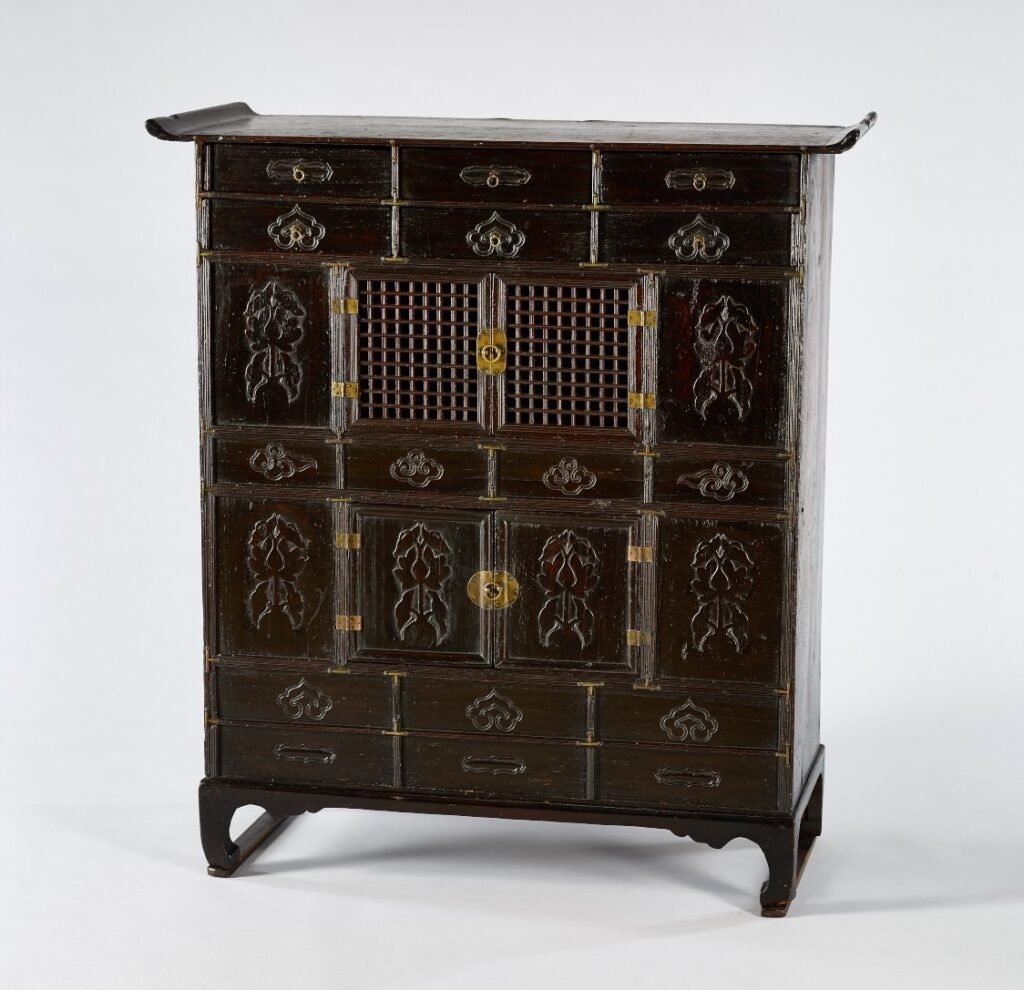
H. 112,5cm, W. 89cm, D. 42,5cm.

H. 123,3cm, W. 97,3cm, D. 45,8cm.


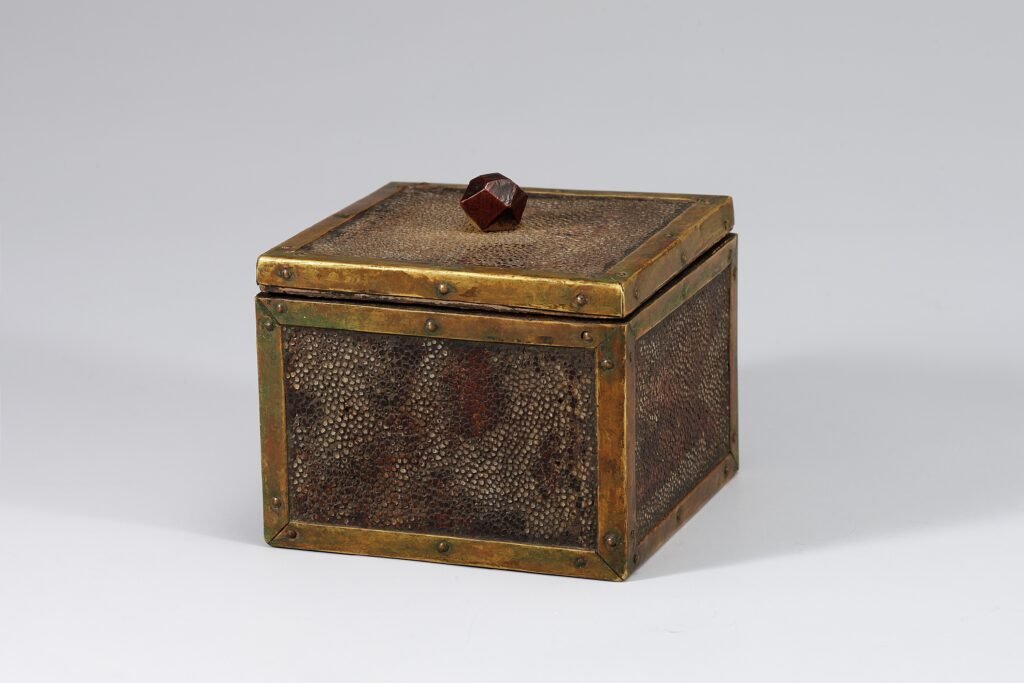
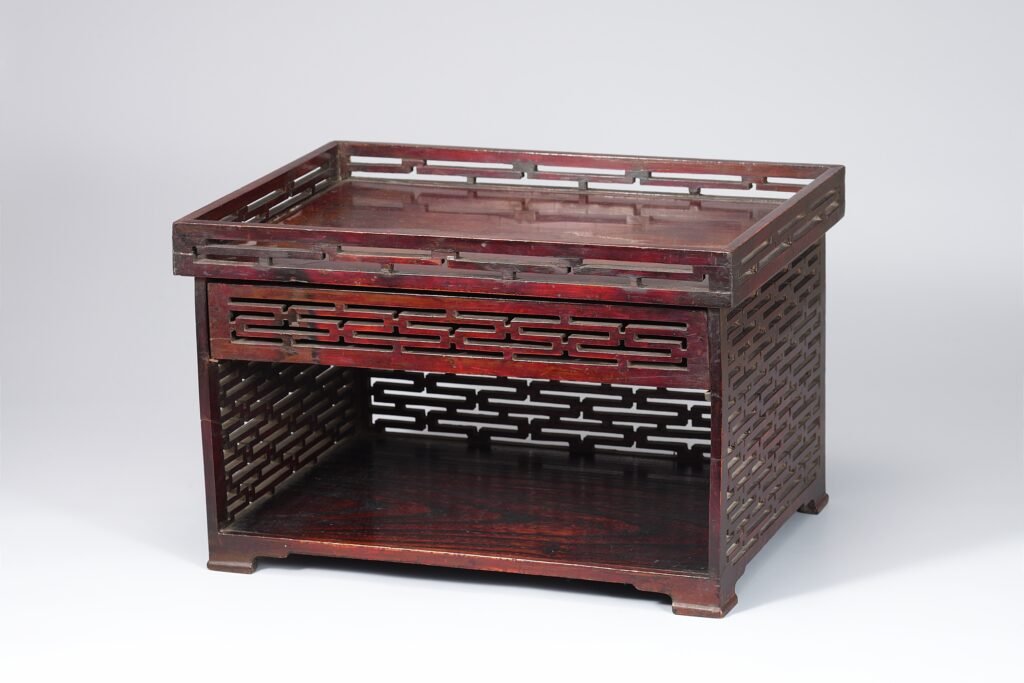
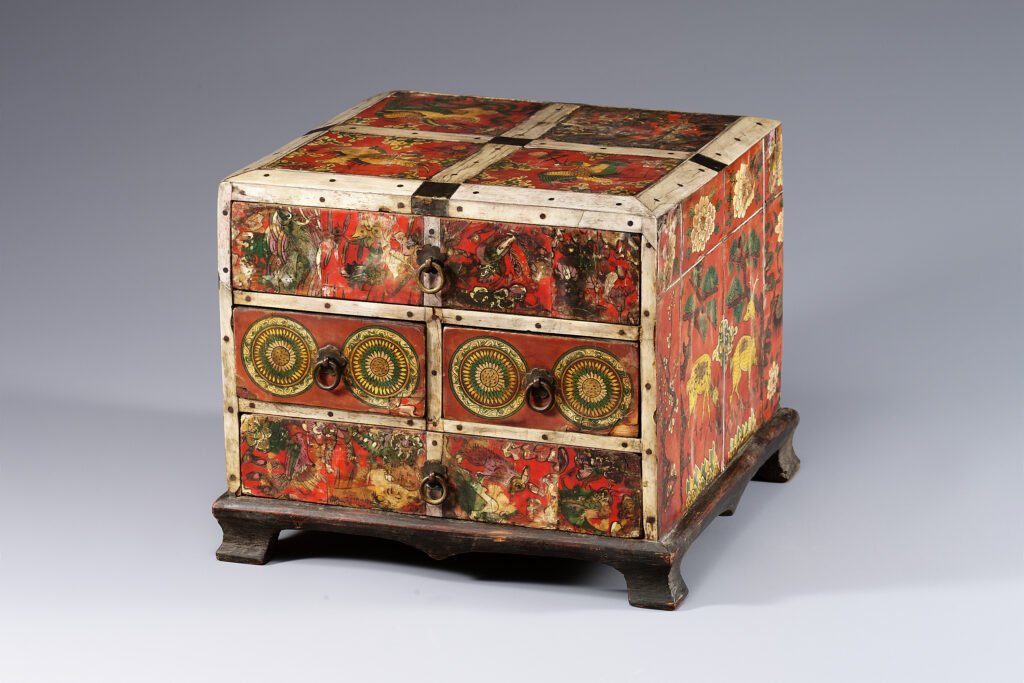
A box for storing tools necessary for combing or decorating combed hair.
This comb box has long drawers at the top and bottom and two drawers in the middle.
The top of the lid divided into a checkerboard pattern and around the drawers are decorated with bands made of white bull horns driven with bamboo nails.
The side and back sides are also divided using thin white horns, with flower patterns on the top and phoenix, flowers, deer, pine trees, cranes, plum blossoms, and various flowers symbolizing longevity on the bottom.
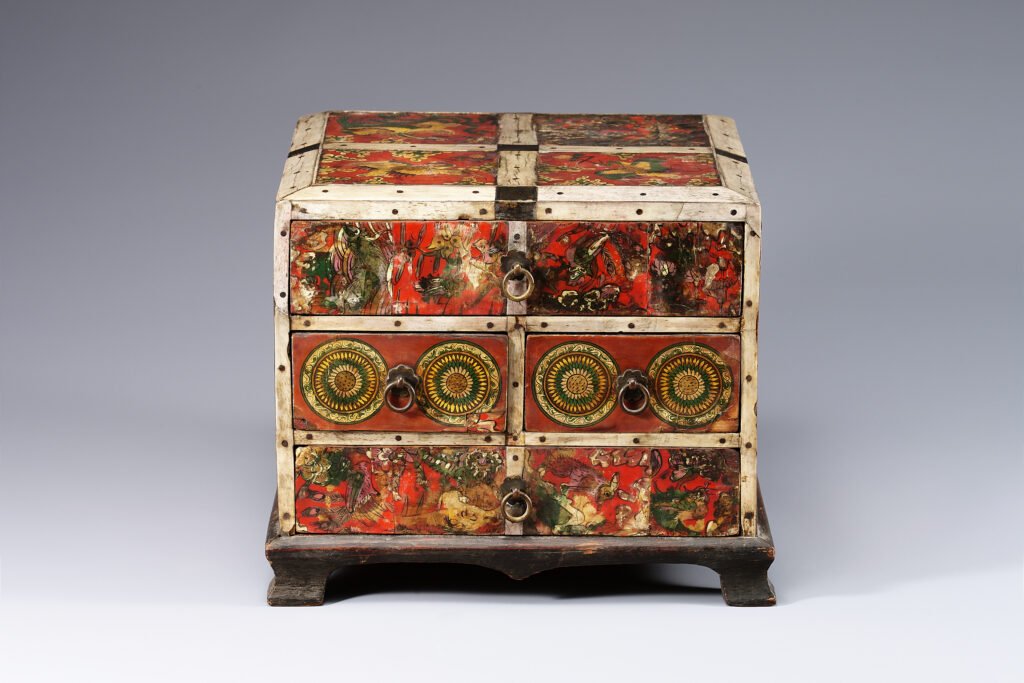
Although the production process is complex and difficult, it is widely used in women’s products because of its colorful and strong decorative properties.
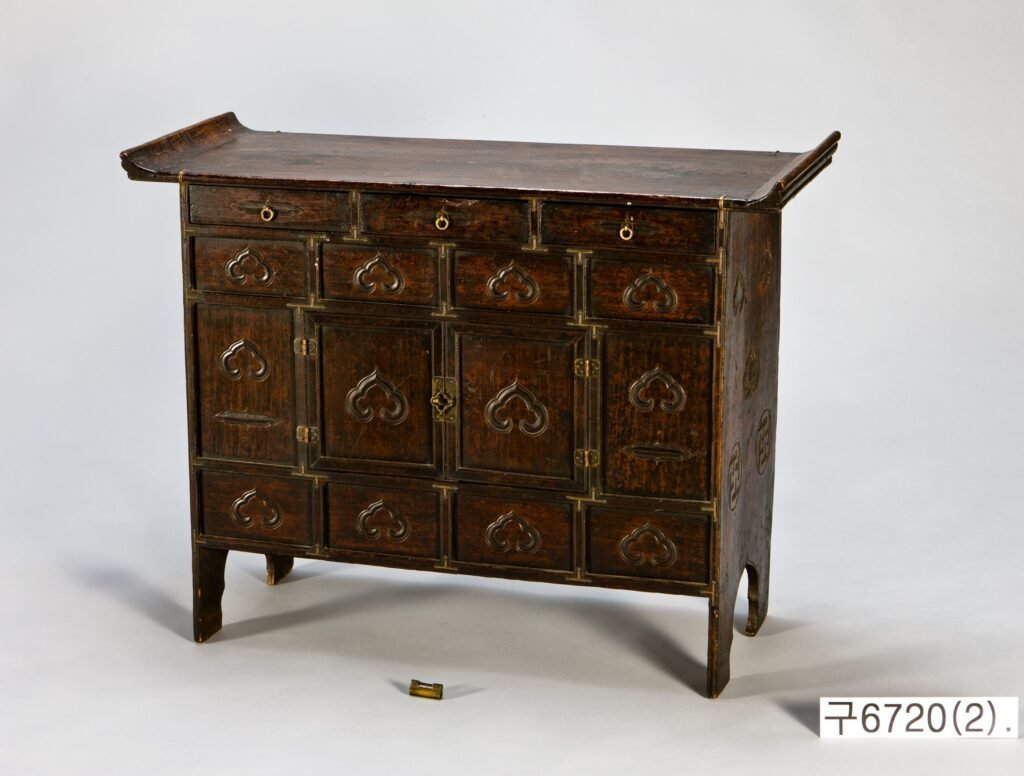
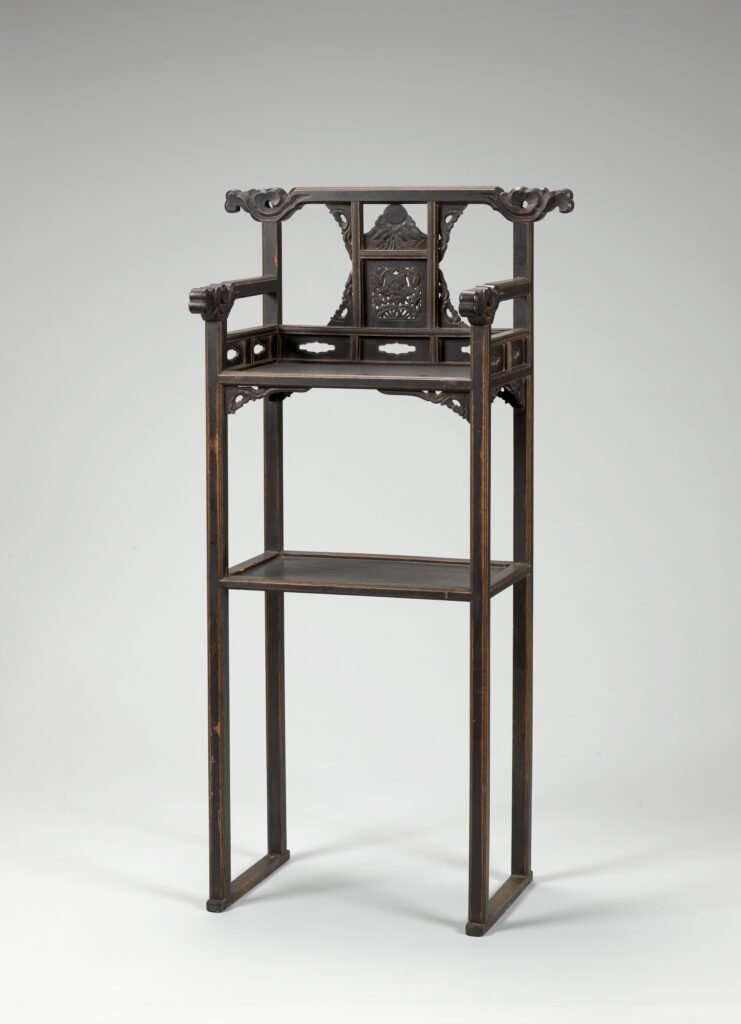
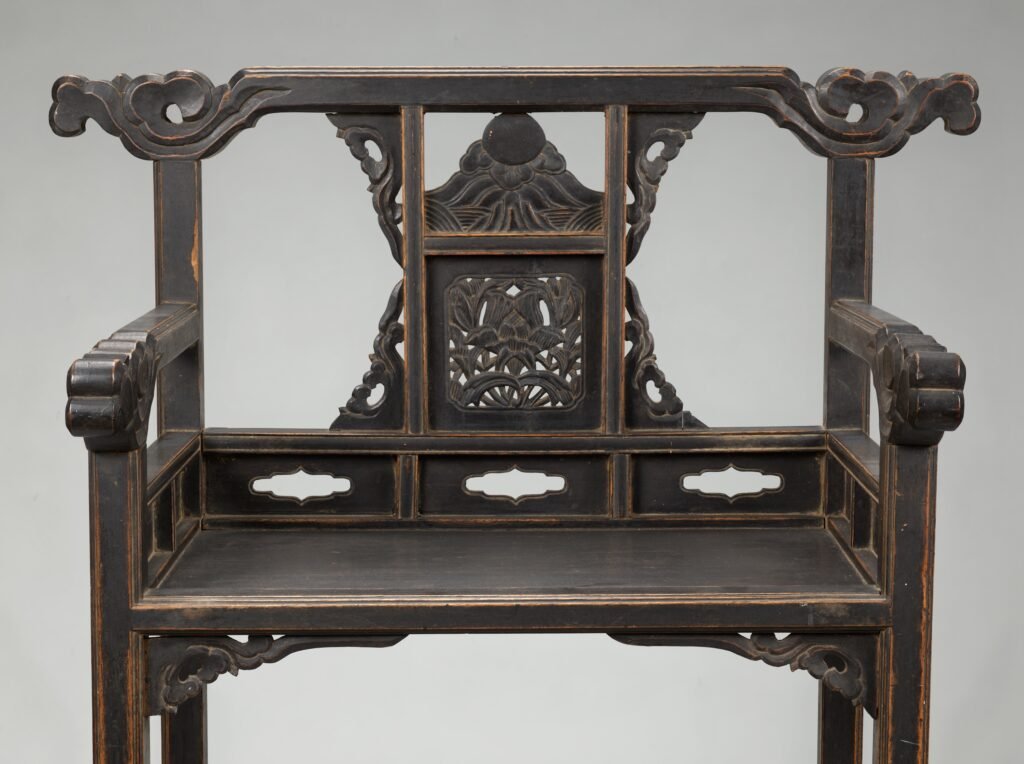
H. 123,5cm, 63,2cm x 37,3cm.
Called gyoui in Korean, this kind of chair was used to place the mortuary tablet at a ritual of sacrificial offering or a funeral. This black lacquered chair is inscribed with mountains, clouds, and a rising sun on its top rail and has openwork grass and flower designs on its lower part. Each corner of the back support of the chair has been made to look like scrolling vines. Each side and the rear part of the rack where the mortuary tablet used to be placed are adorned with two and three holes resembling elephant eyes.

H. 90,5cm, W. 96cm, D. 28cm.
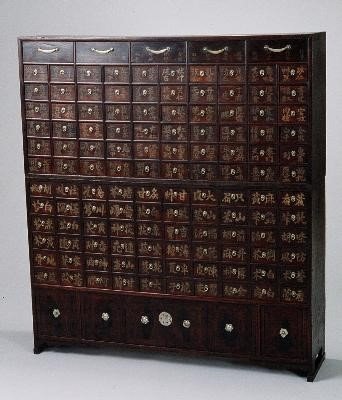
H. 137,8cm, W. 123cm, D. 28,6cm.
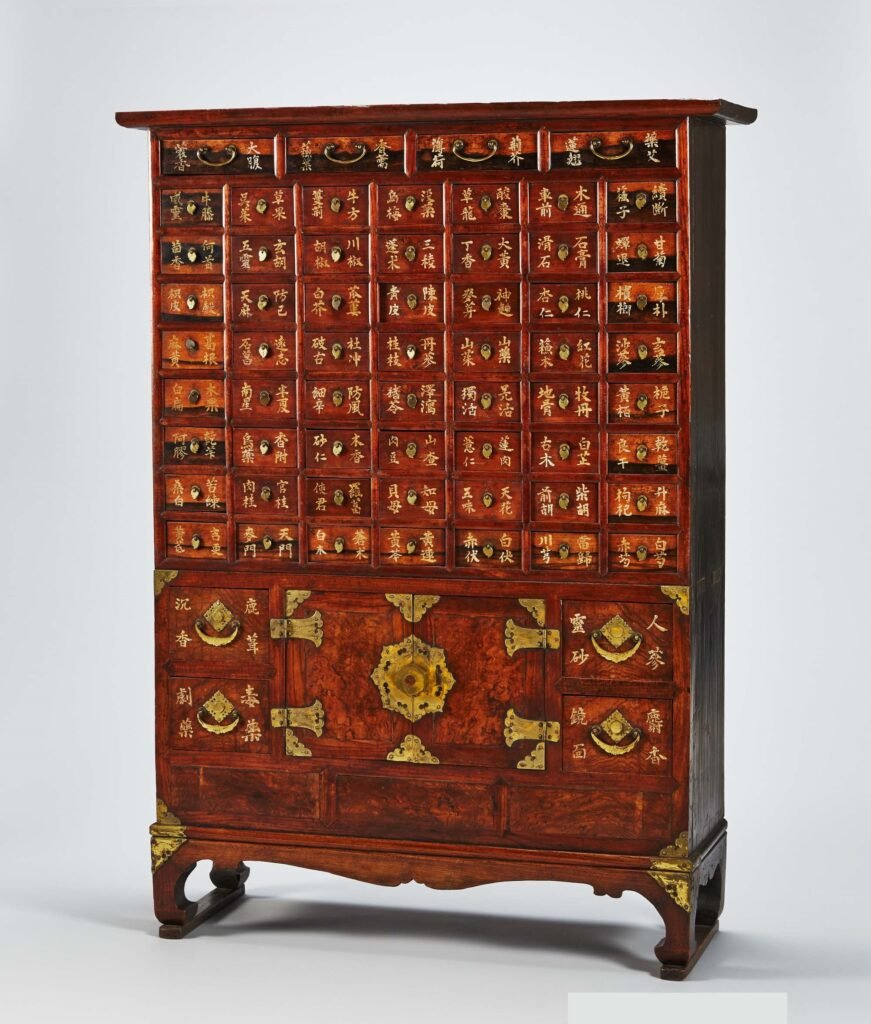
H. 125,7cm, W. 90cm, D. 27,5cm.
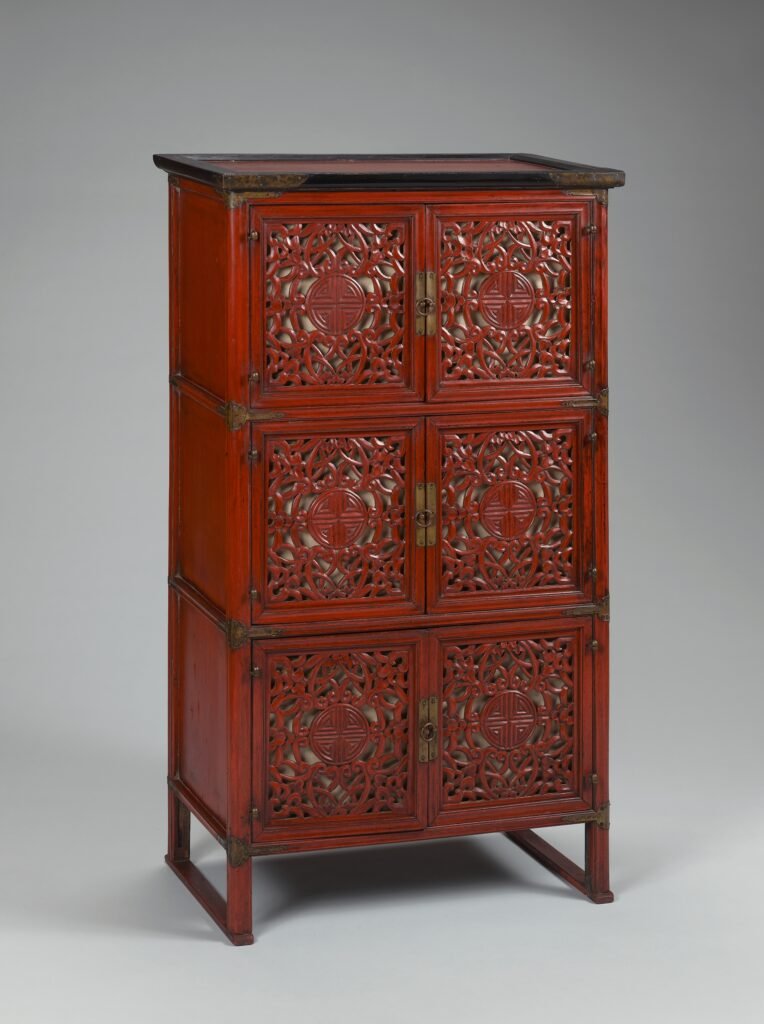
H. 114,5cm, W. 64,3cm, D. 37,3cm. (Photos left & right).
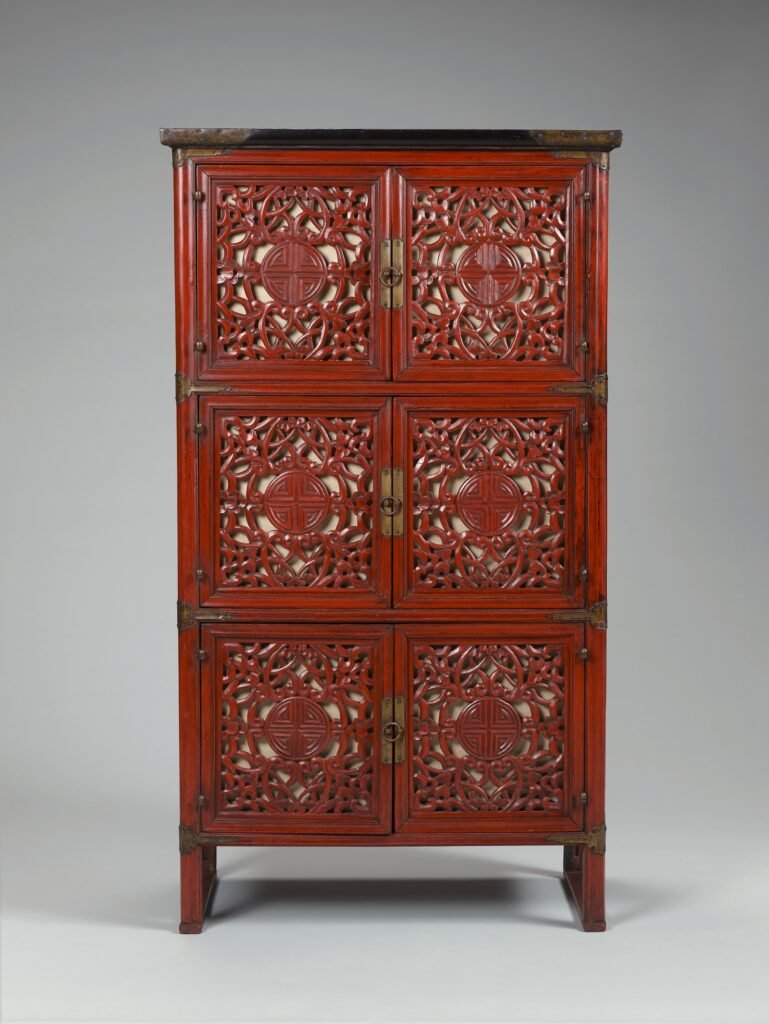
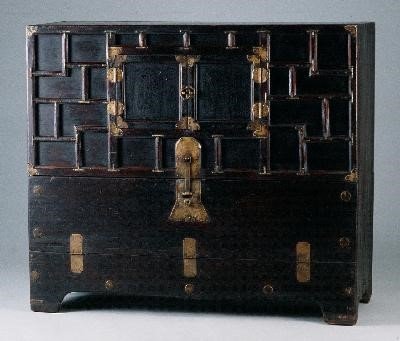
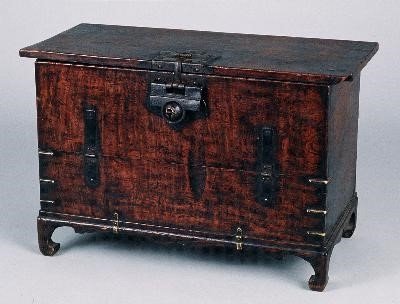
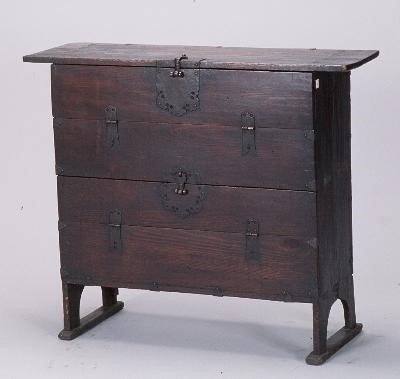


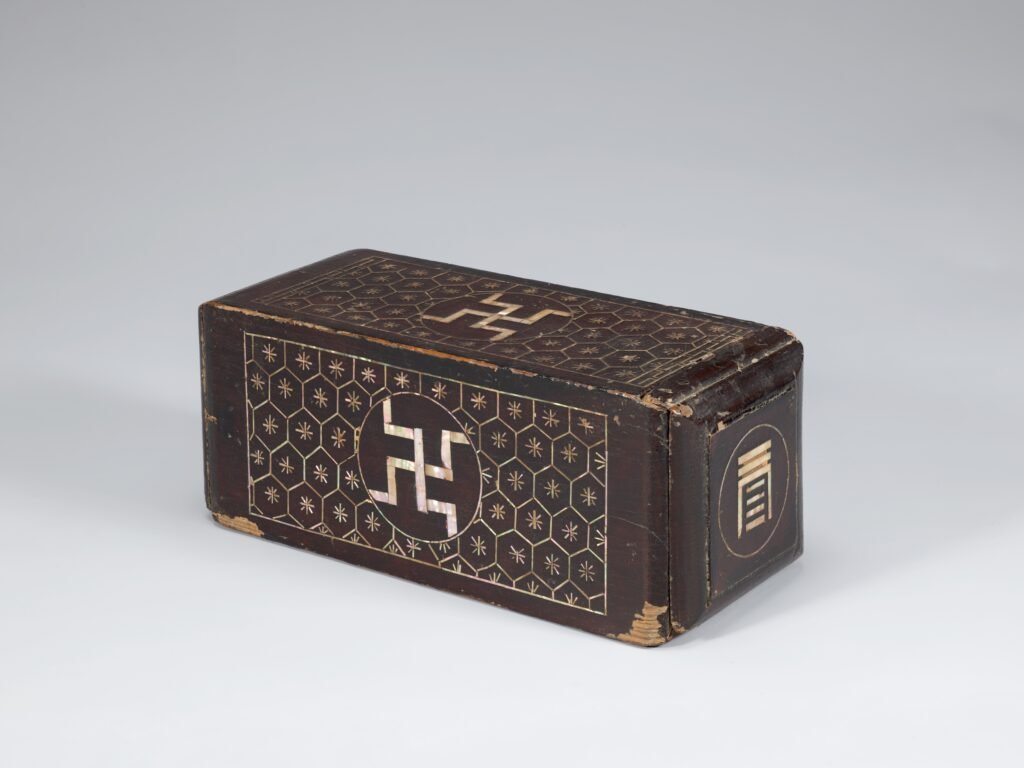


H. 164,5cm, W. 103,5cm, D. 42,8cm.
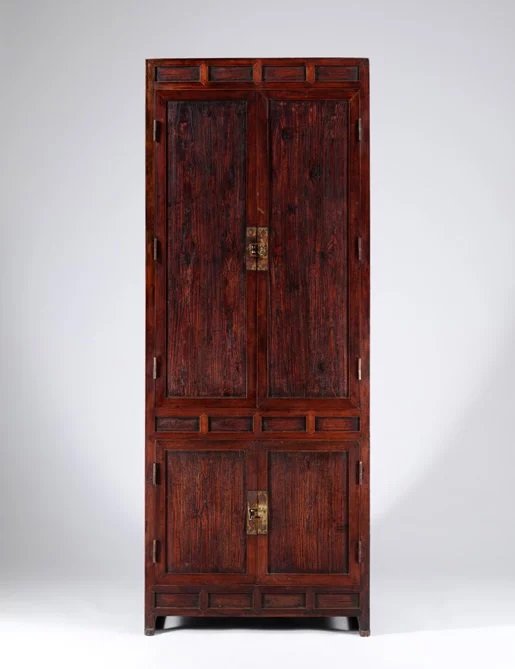
Paulownia wood. H. 181,7cm, W. 71cm, D. 45,7cm. This wardrobe is equipped with a clothes rack and has a thin body that makes it look higher than it actually is. The bottom space is for hats and other small articles. Made of empress wood, it is marked by a natural esthetic sensibility and simplicity.
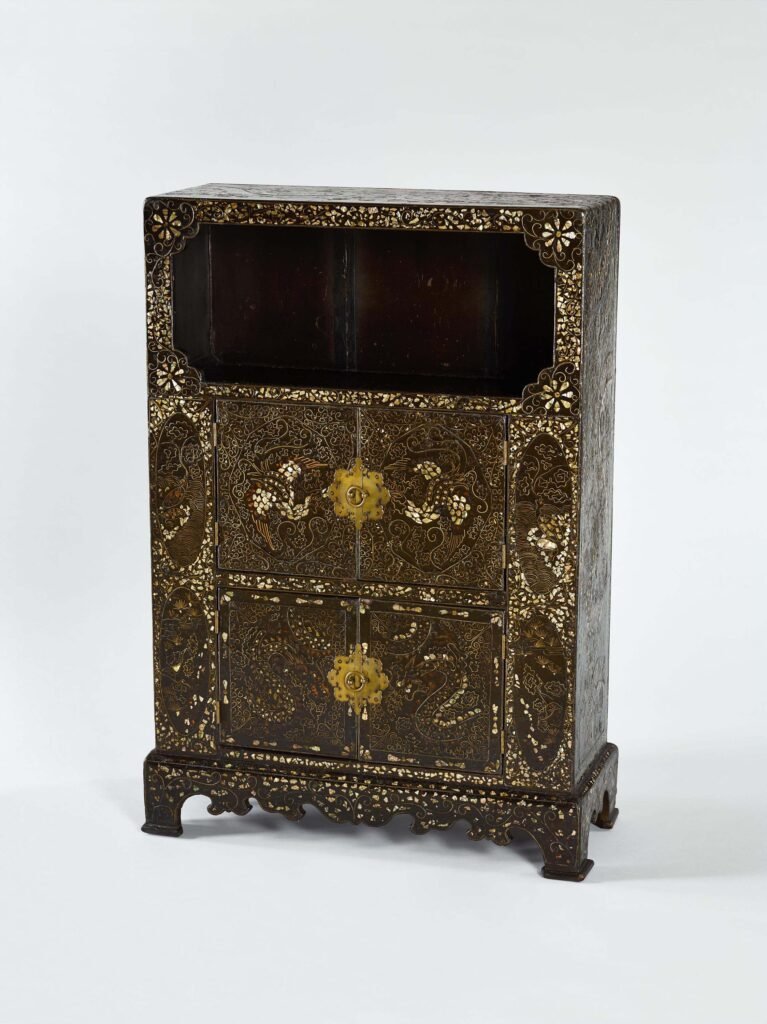

Yellow brass fittings.



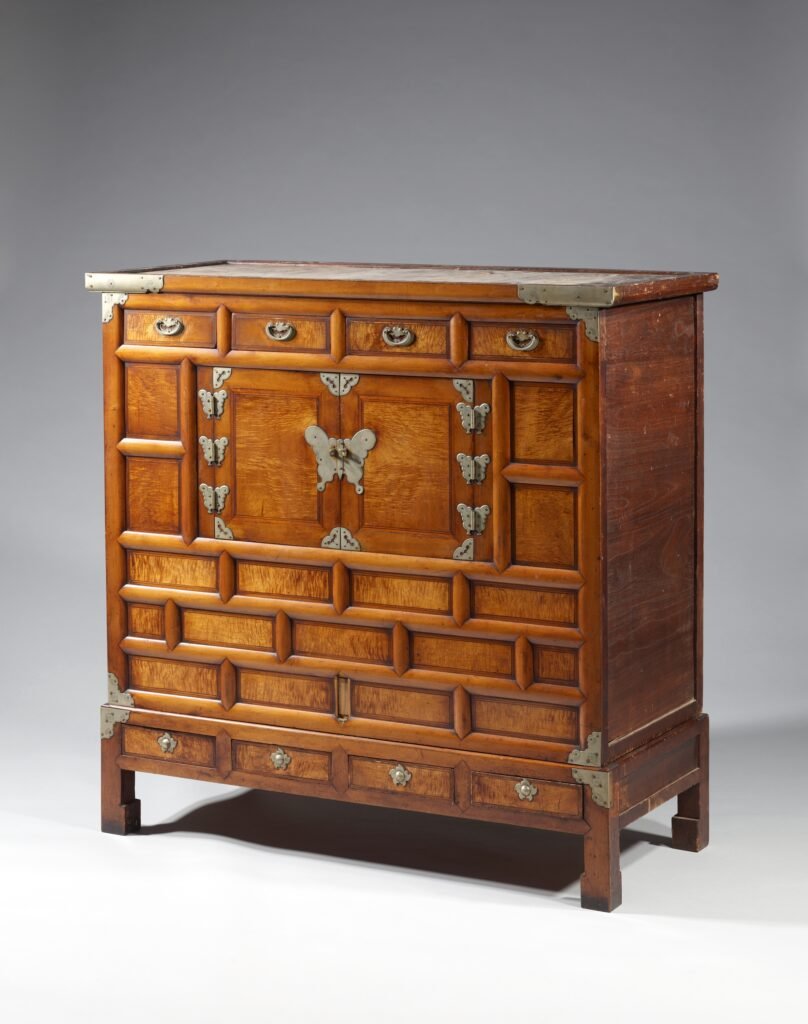
H. 106,2cm, W. 108cm, D. 46,7cm.

H. 87,5cm, W. 121cm, D. 39cm.
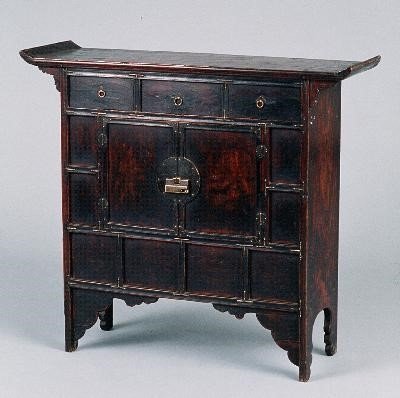
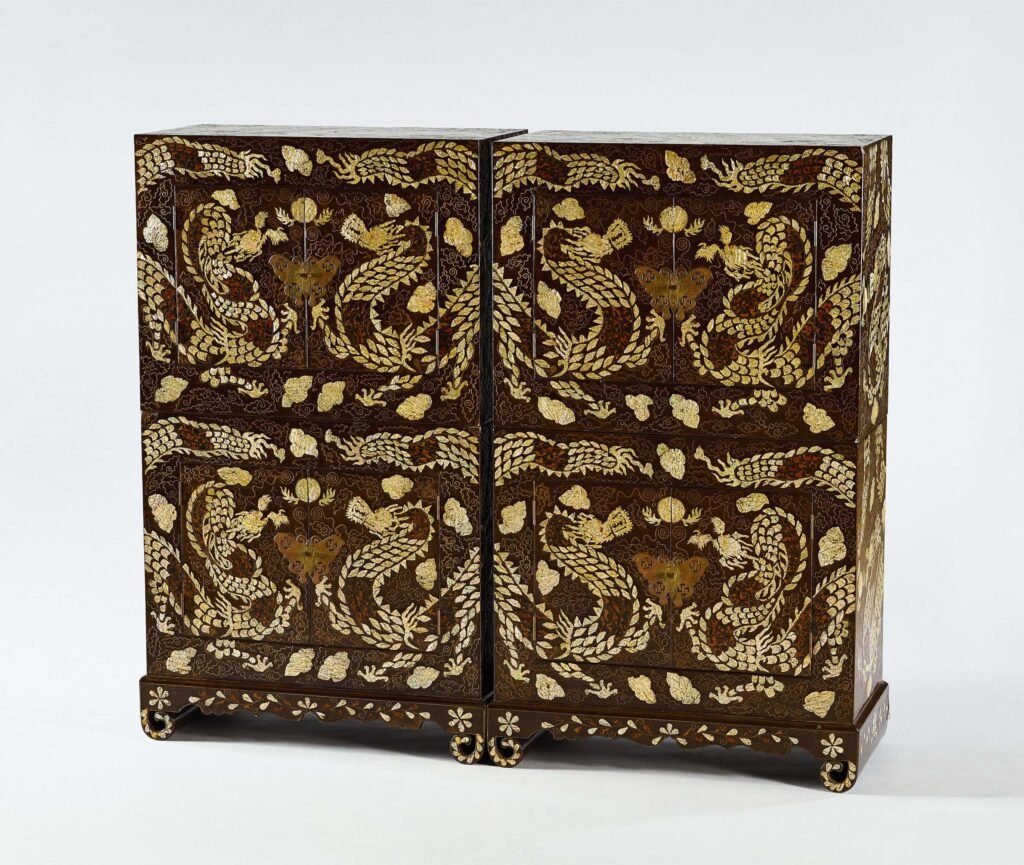
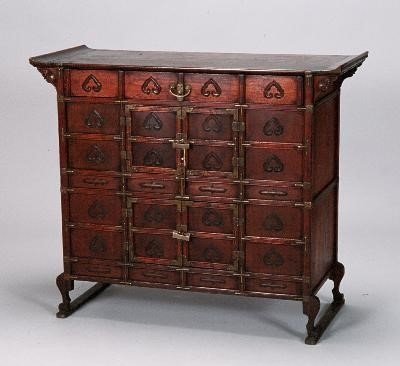
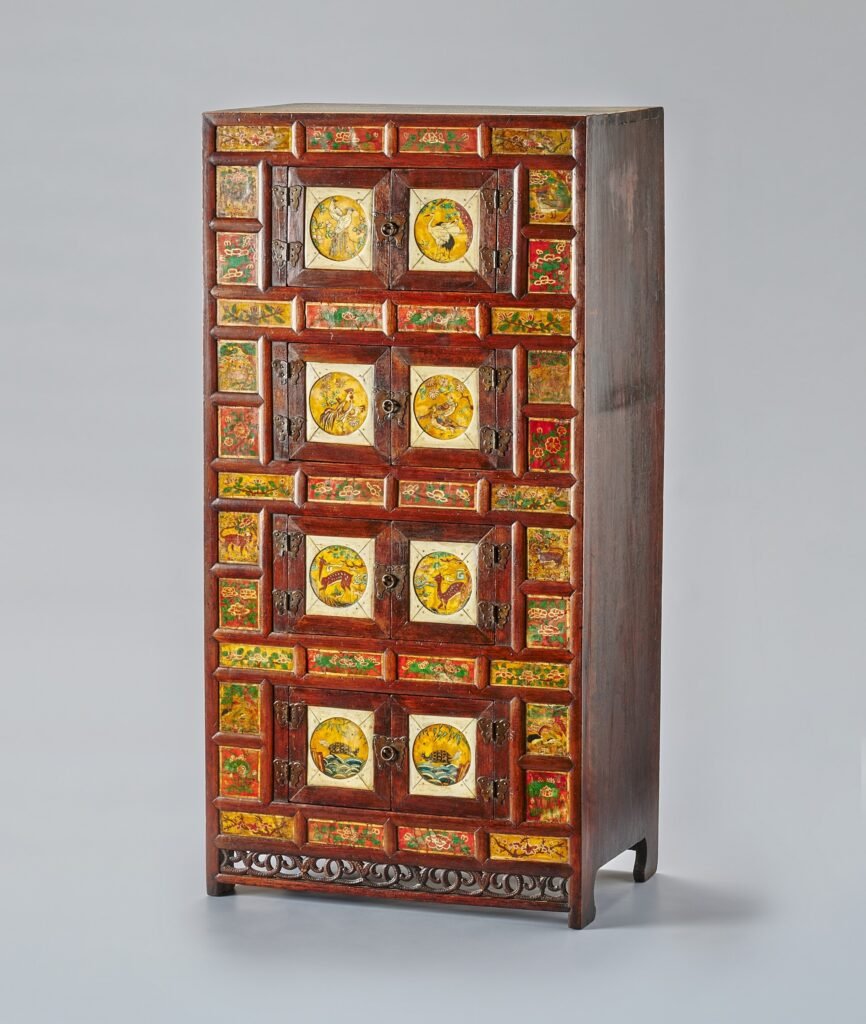

H. 33,7cm, W. 63,3cm, D. 34,2cm.
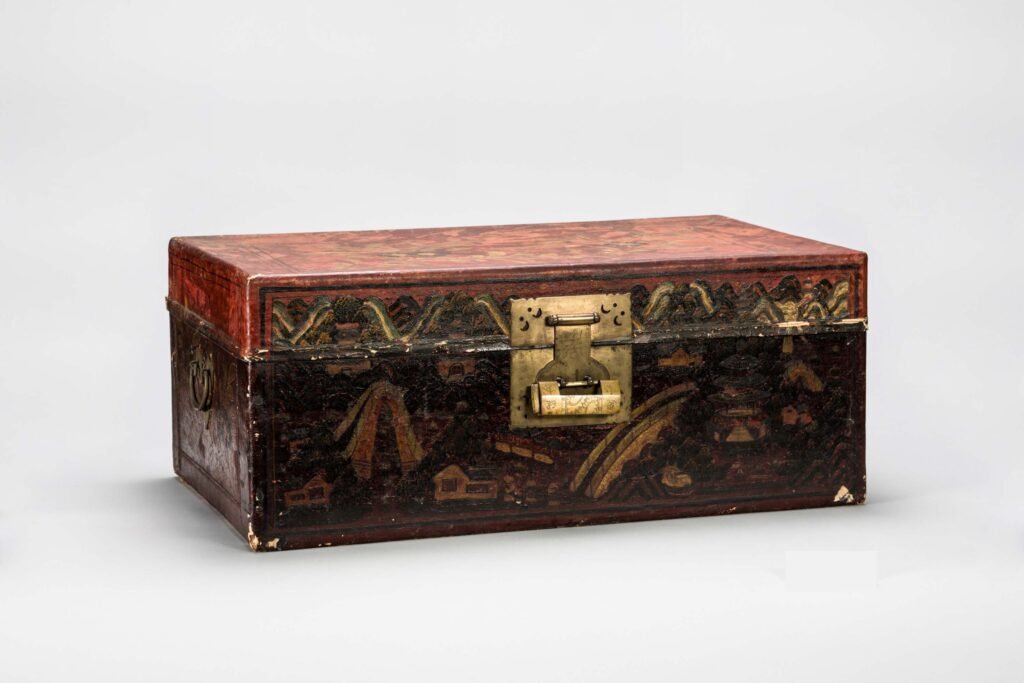
H. 26,7cm, W. 66cm, D. 39,2cm.
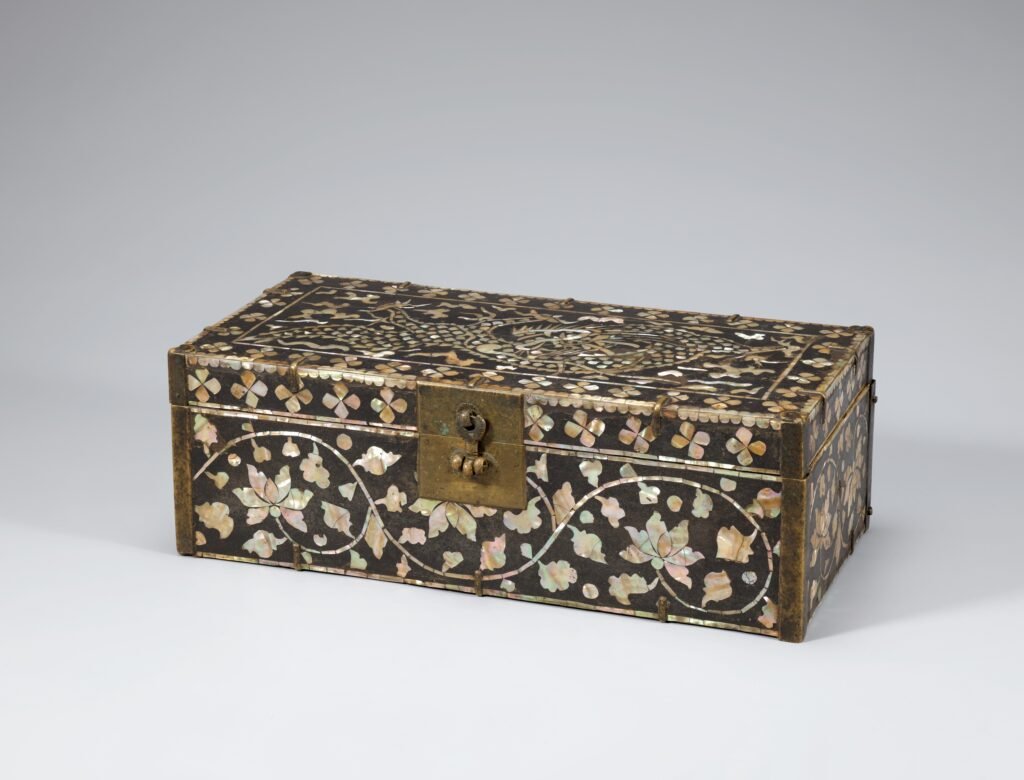
H. 10,9cm, W. 33,2cm, D. 15,6cm.

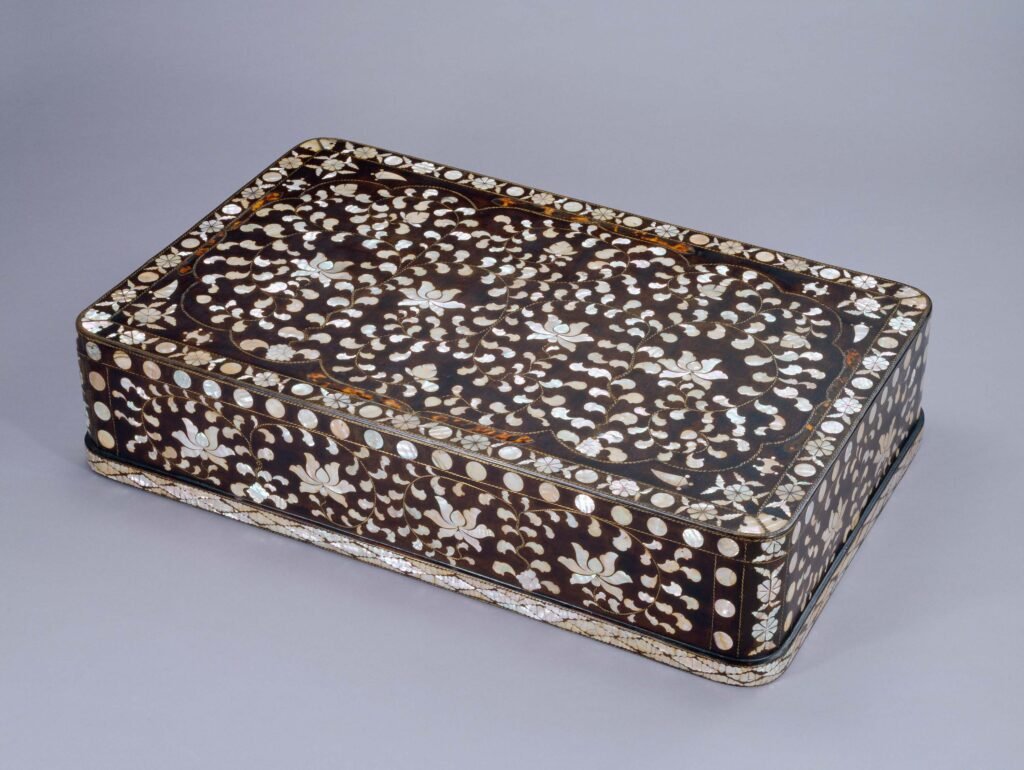
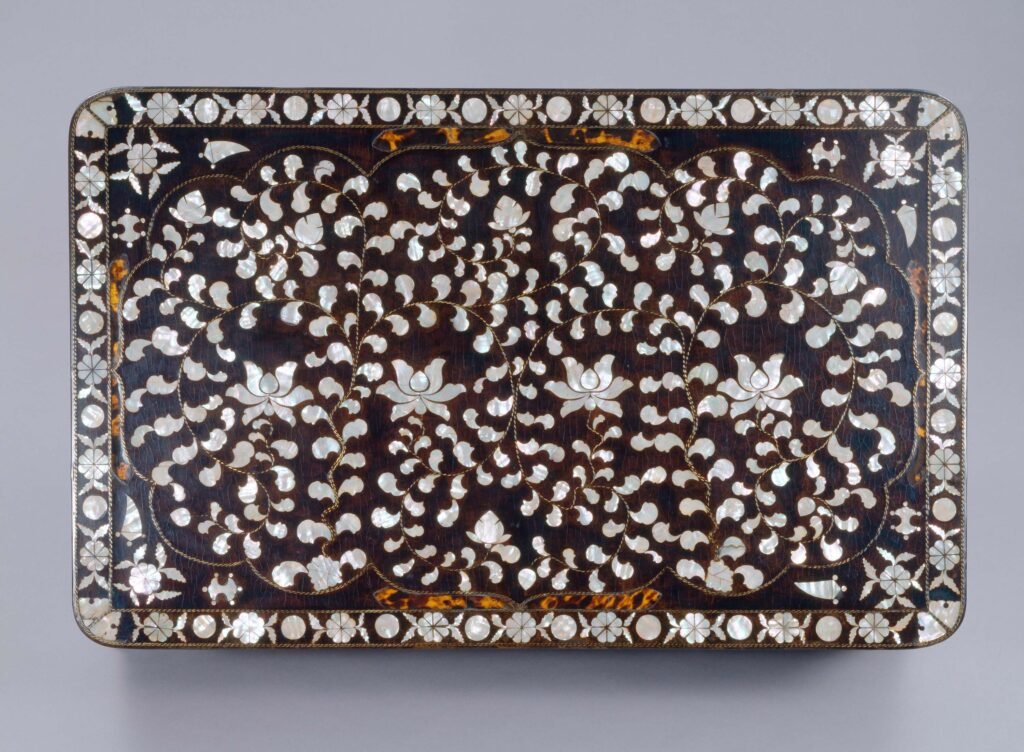

H. 23cm, W. 33,3cm, D. 22cm.
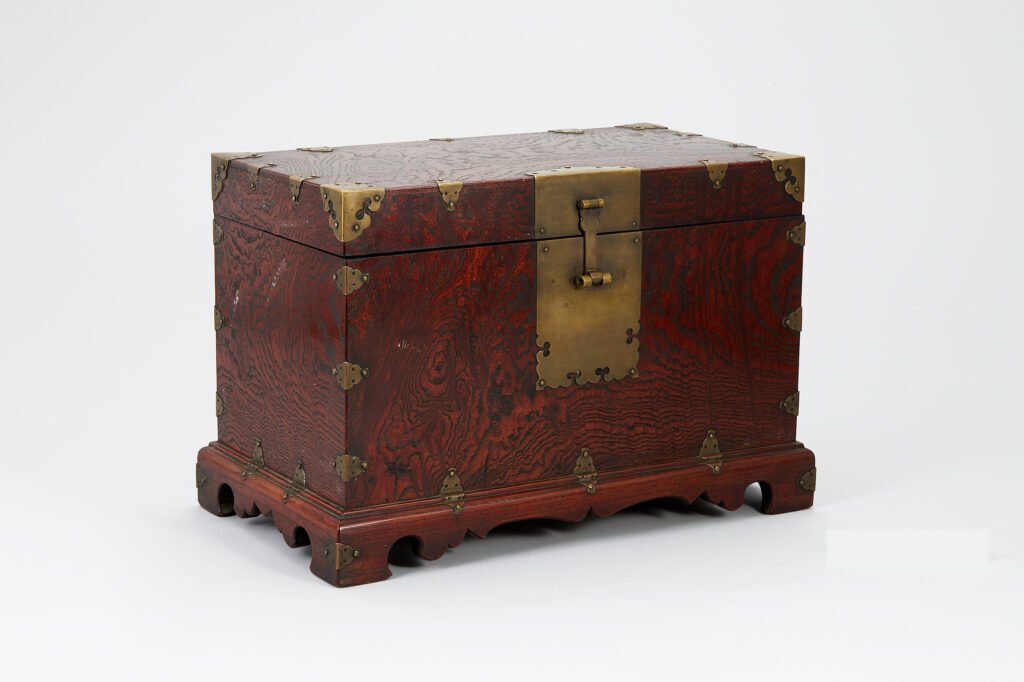

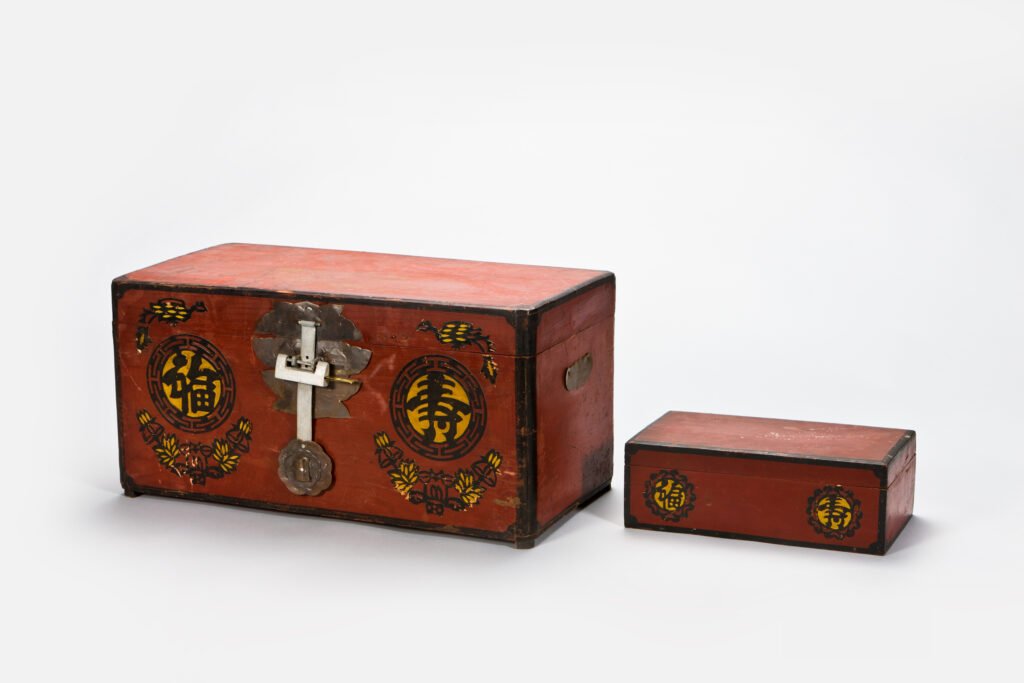
Small box: H. 10,9cm, W. 31,7cm, D. 16,7cm.
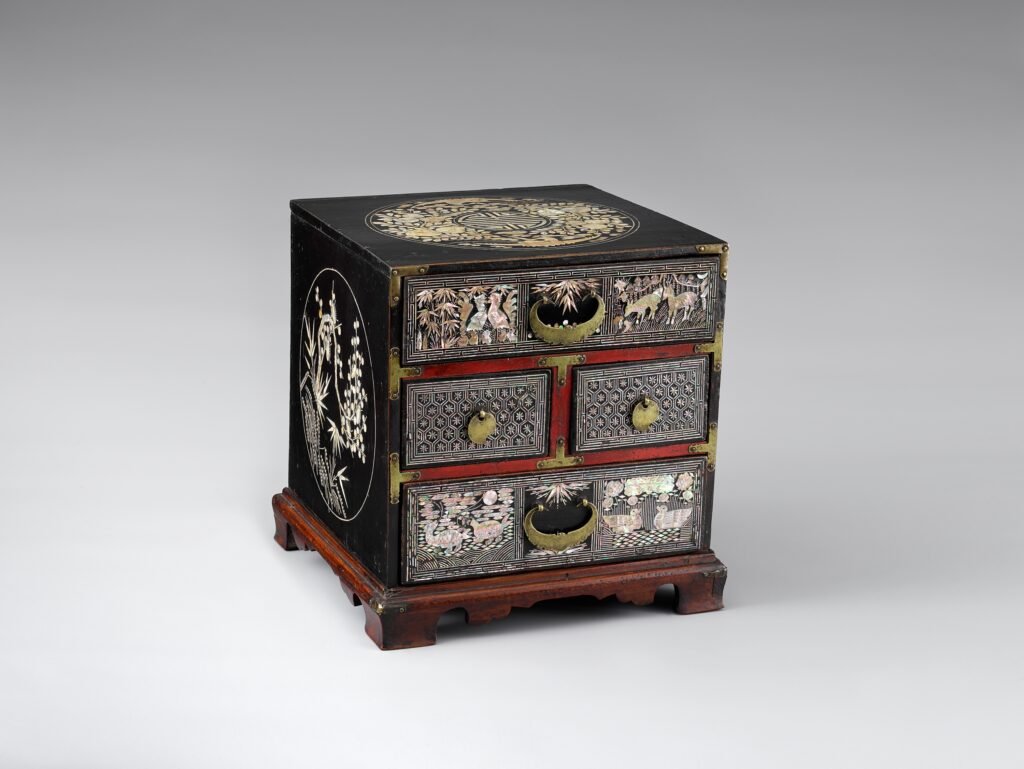
H. 29,8cm, W. 29,3cm, D. 28cm.

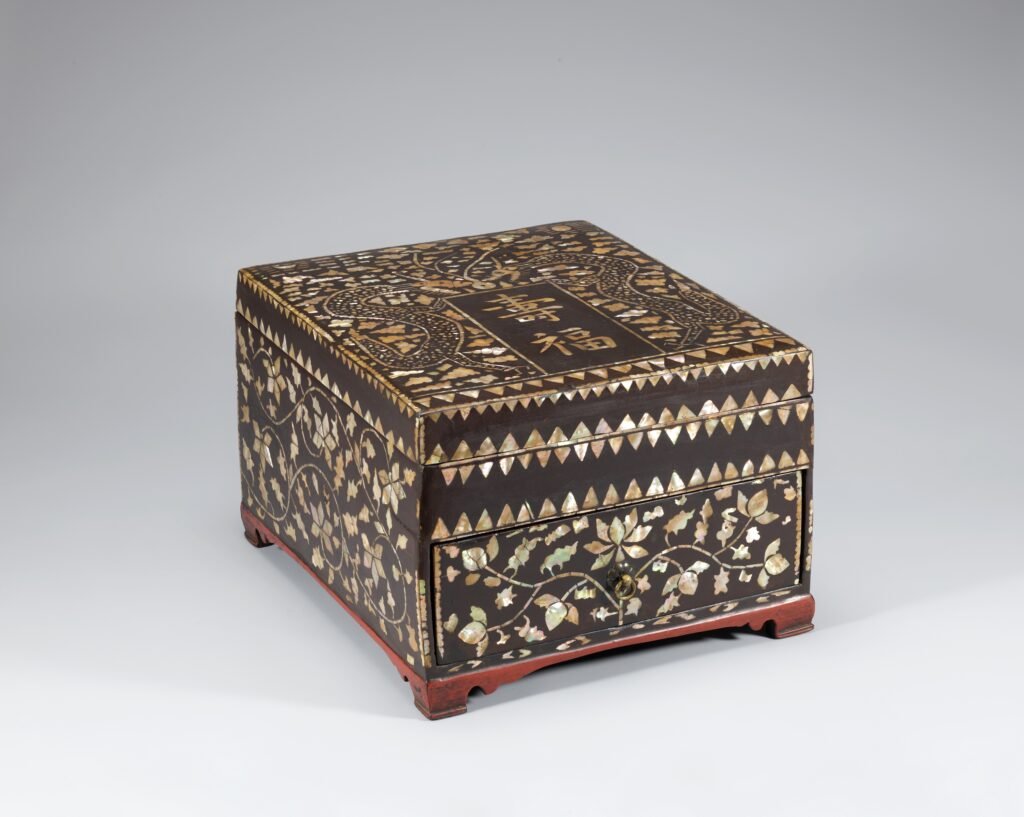
H. 20,2cm, W. 27,1cm, D. 37,9cm.
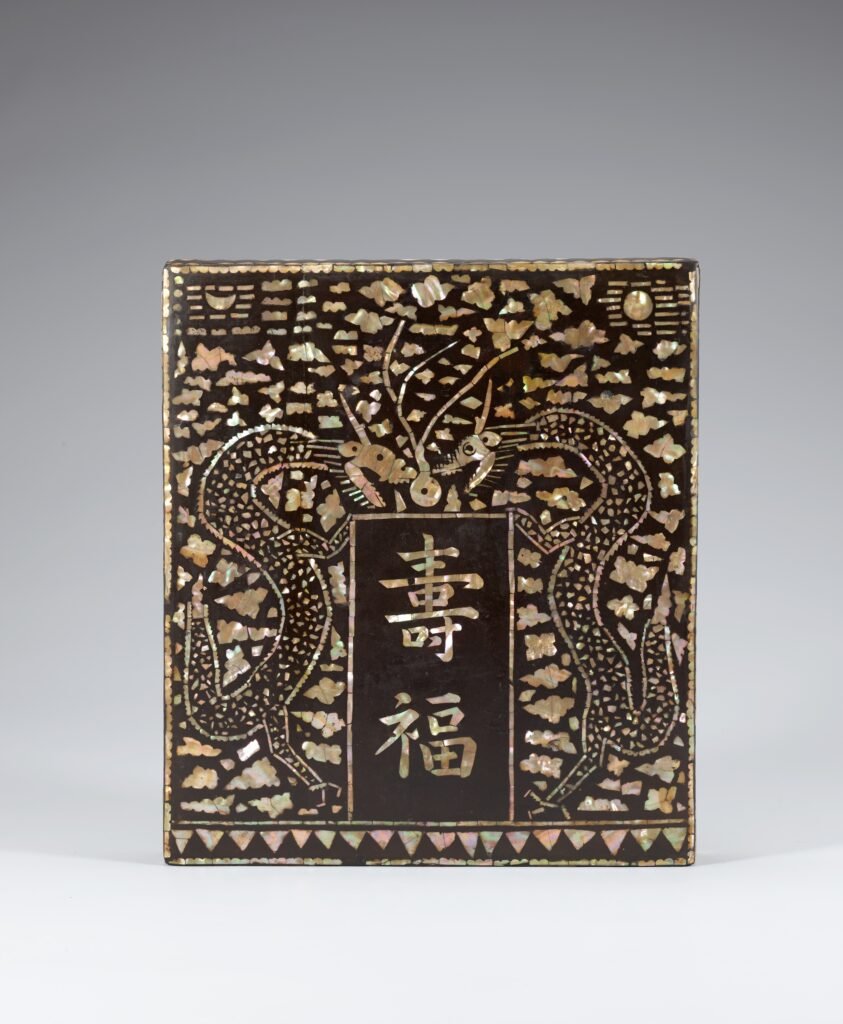
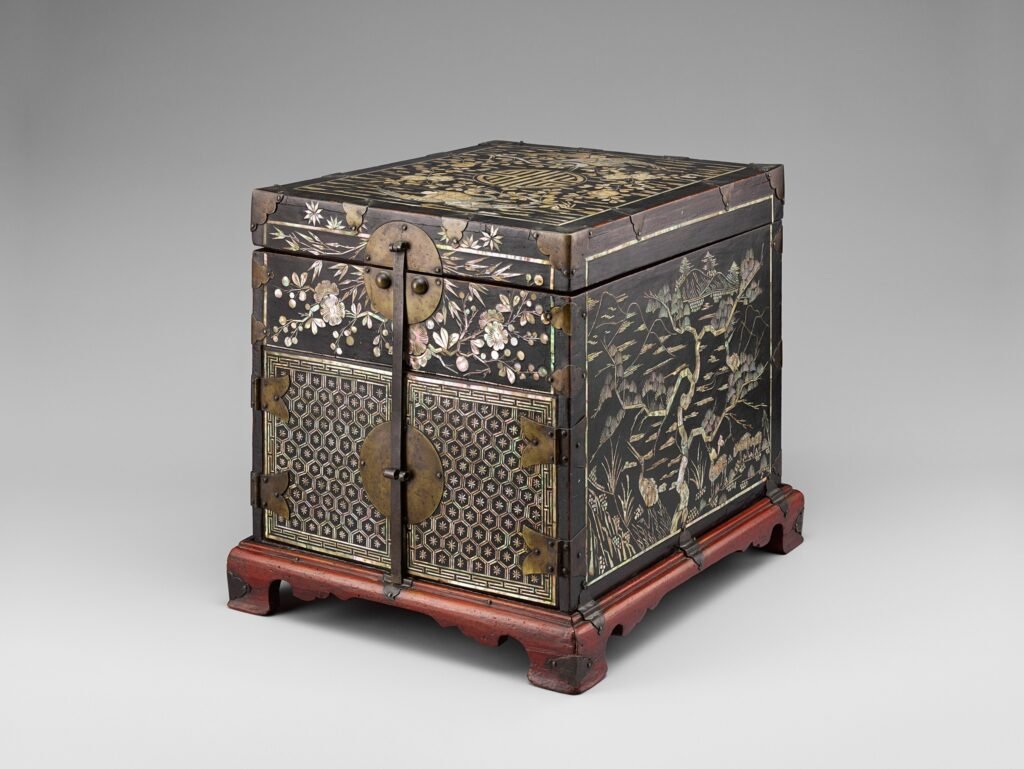

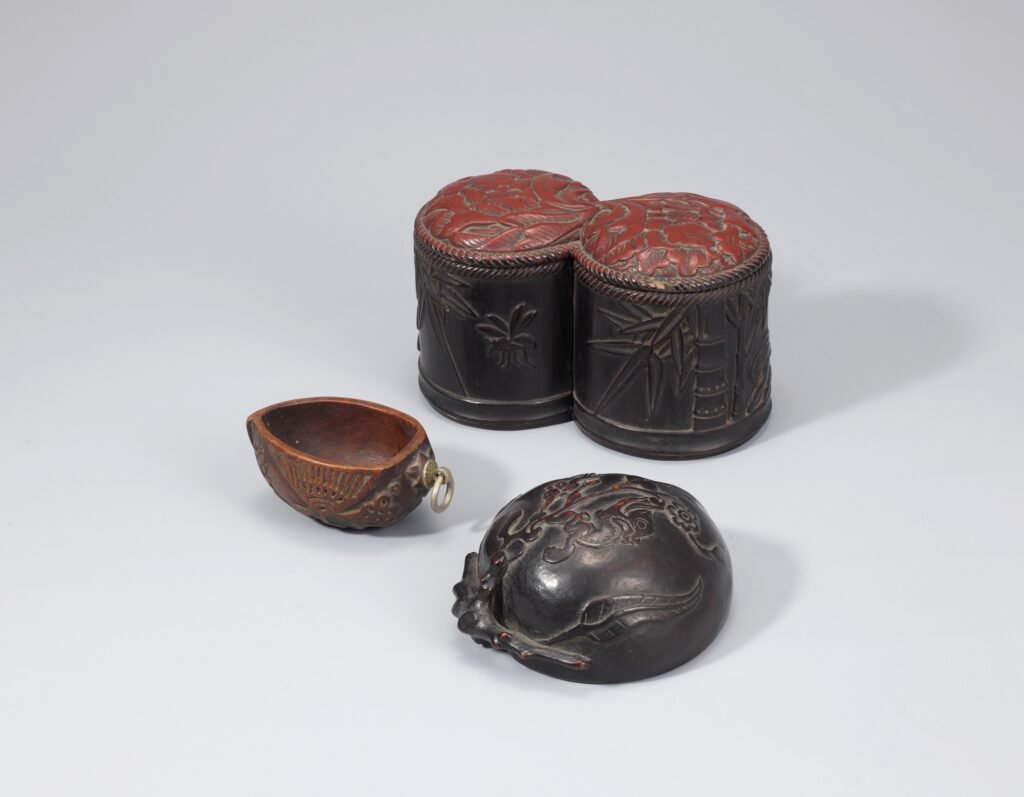
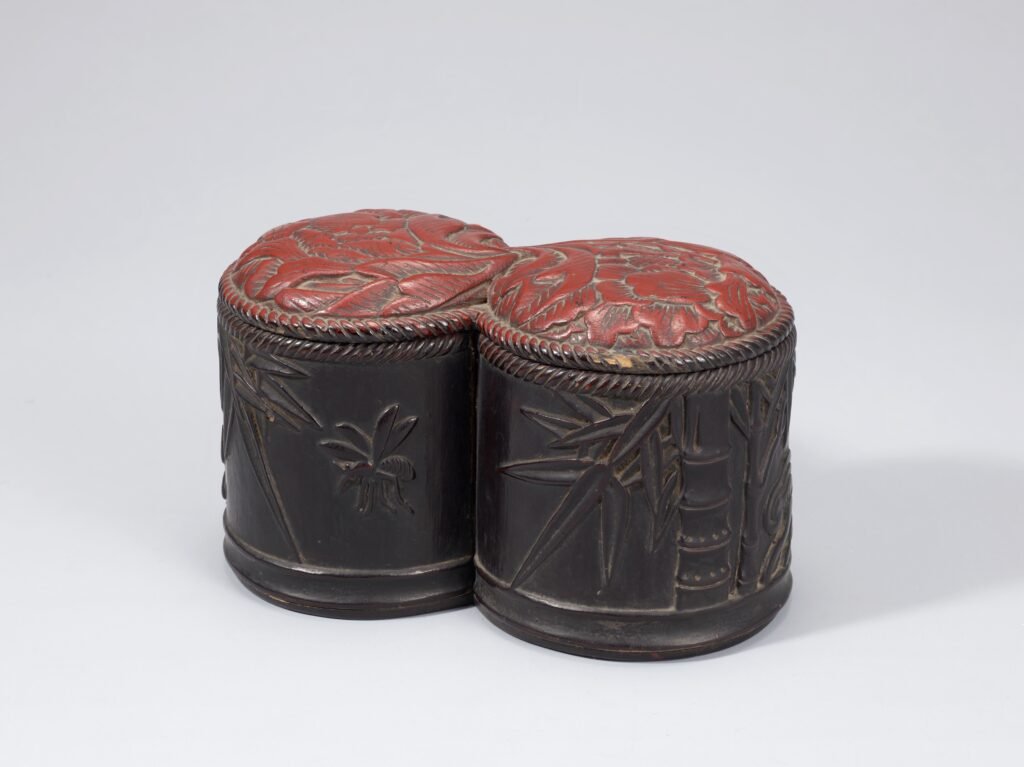
Jeonju. Jeolla Do province.

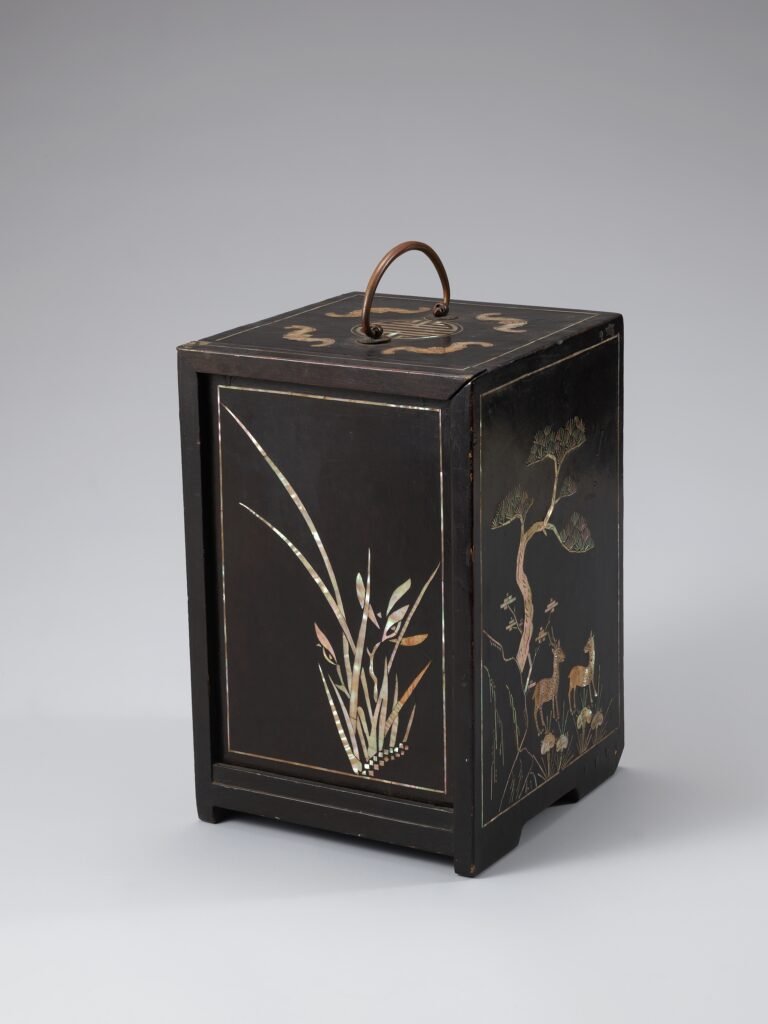
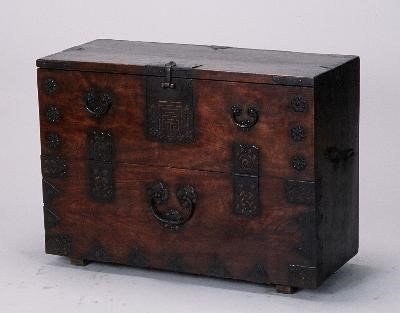
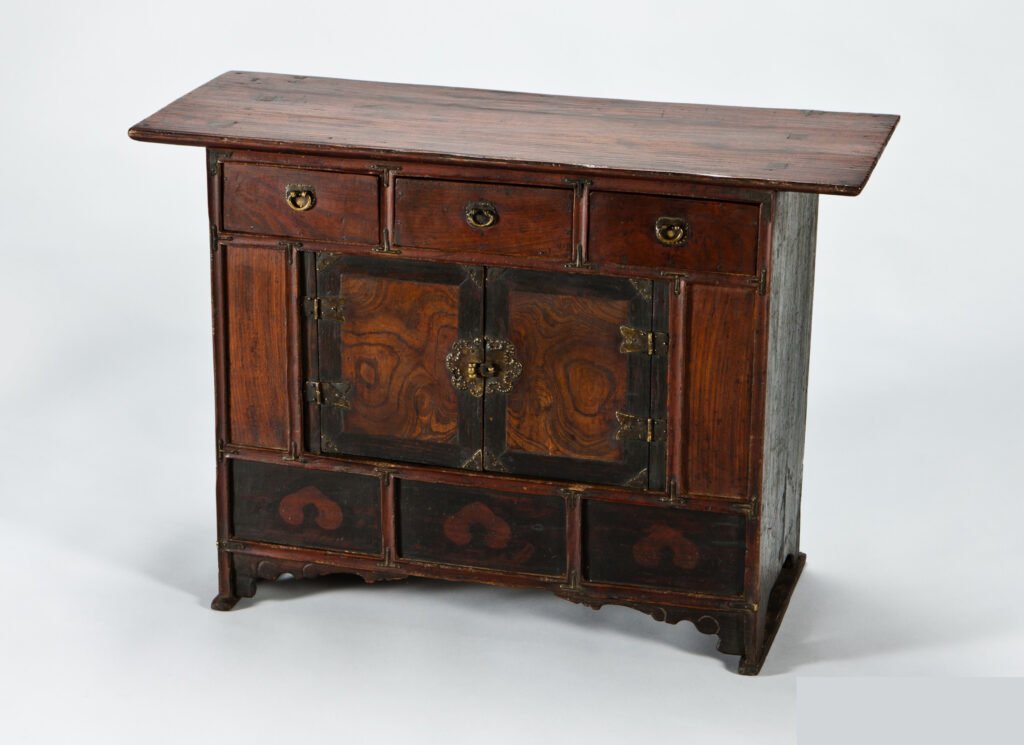
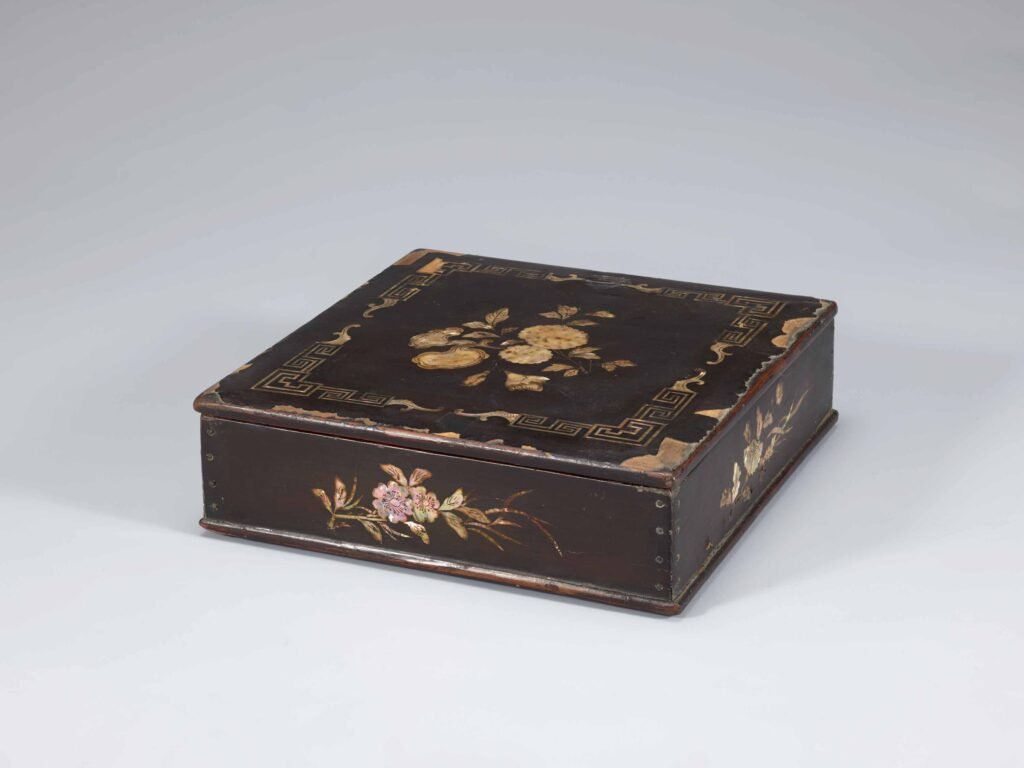
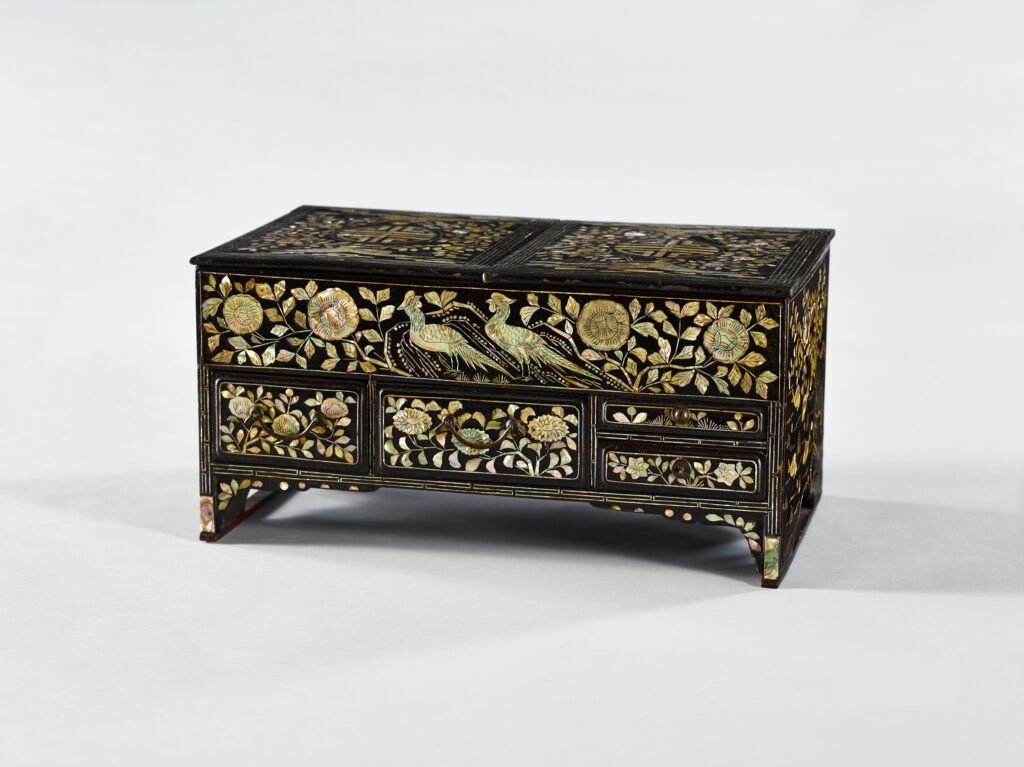

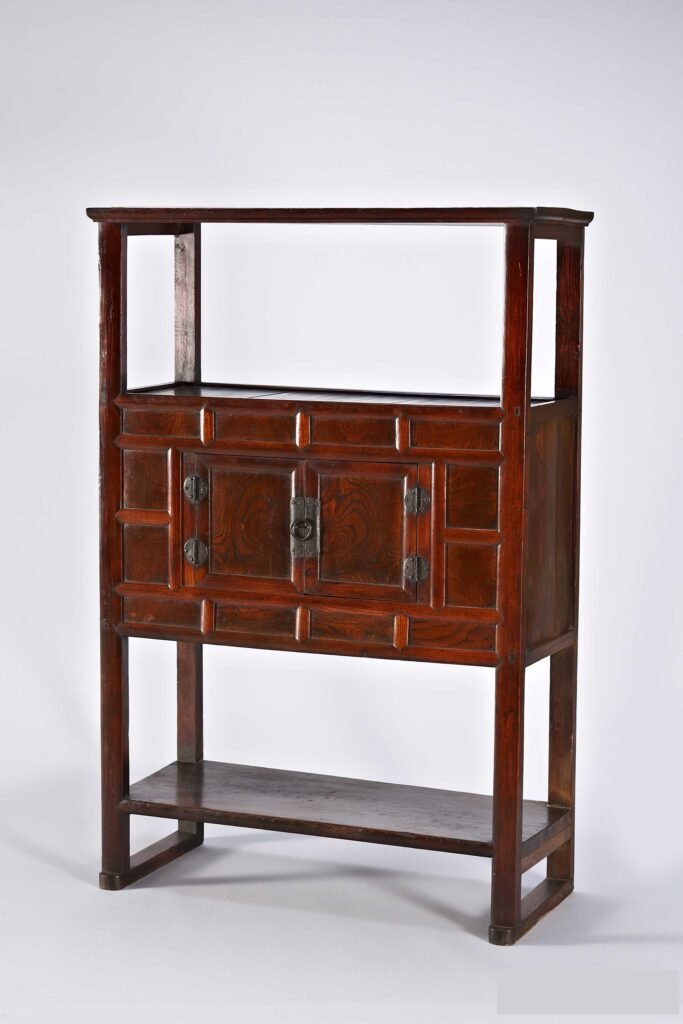

H. 121,5cm, W. 88cm, D. 39cm.
Also called a Jeongju wardrobe, this chest is from Jeongju city, capital of North Jeolla province
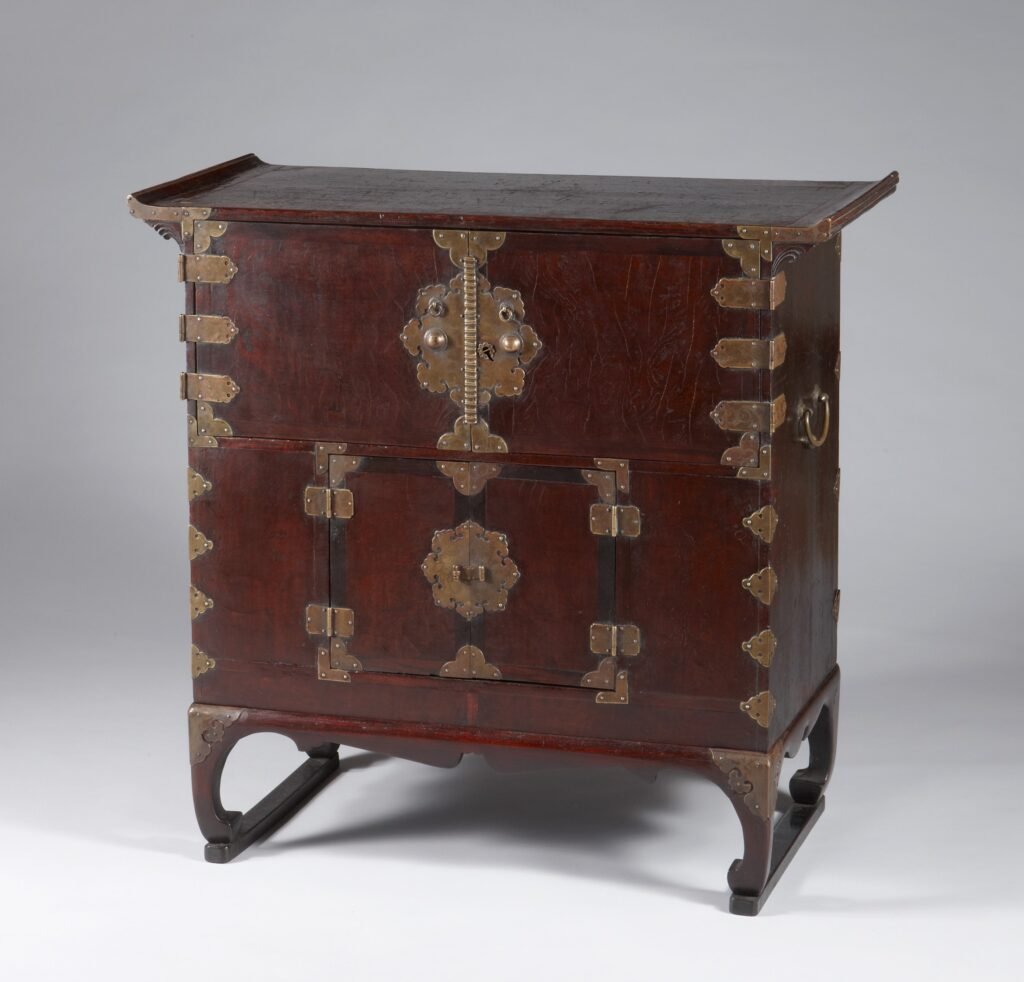
H. 80,3cm, W. 69,3cm, D. 37cm
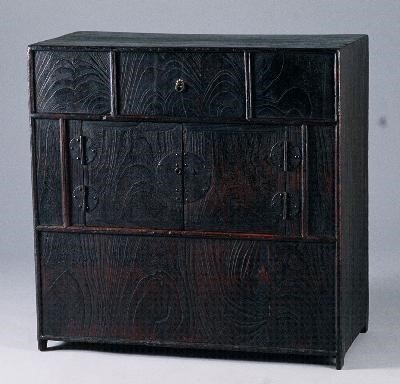
H. 70cm, W. 71cm, D. 37cm.
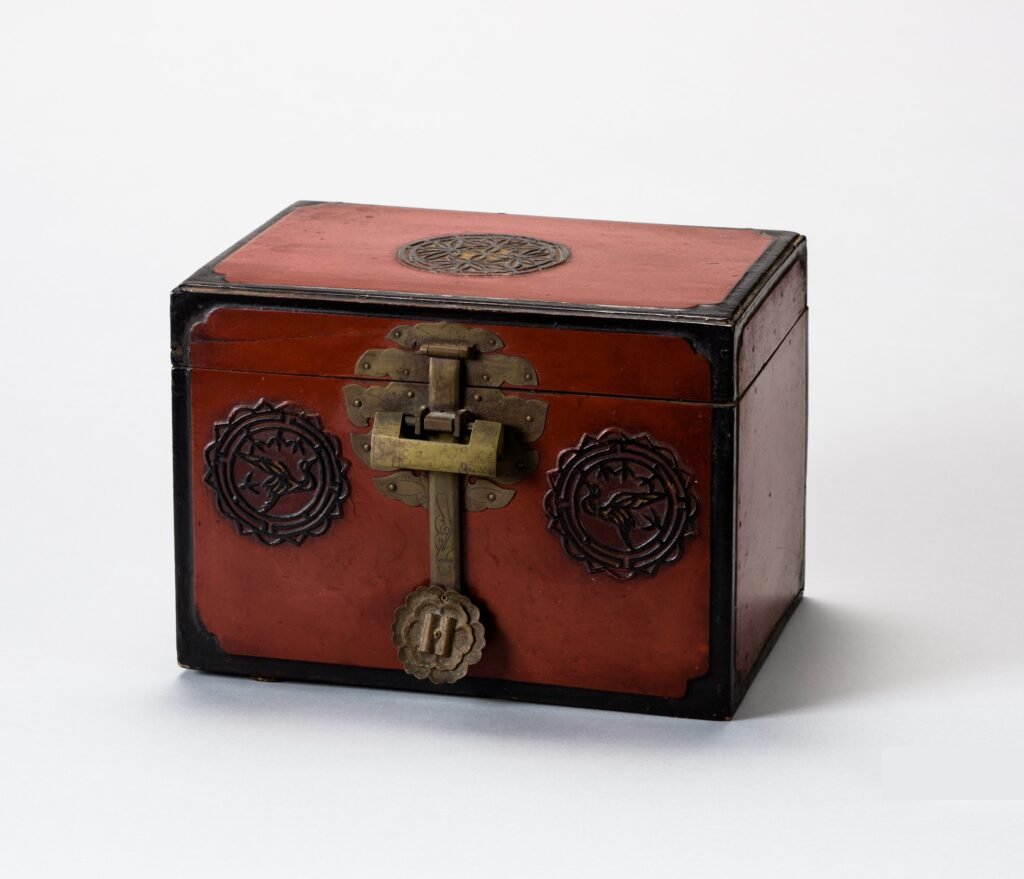

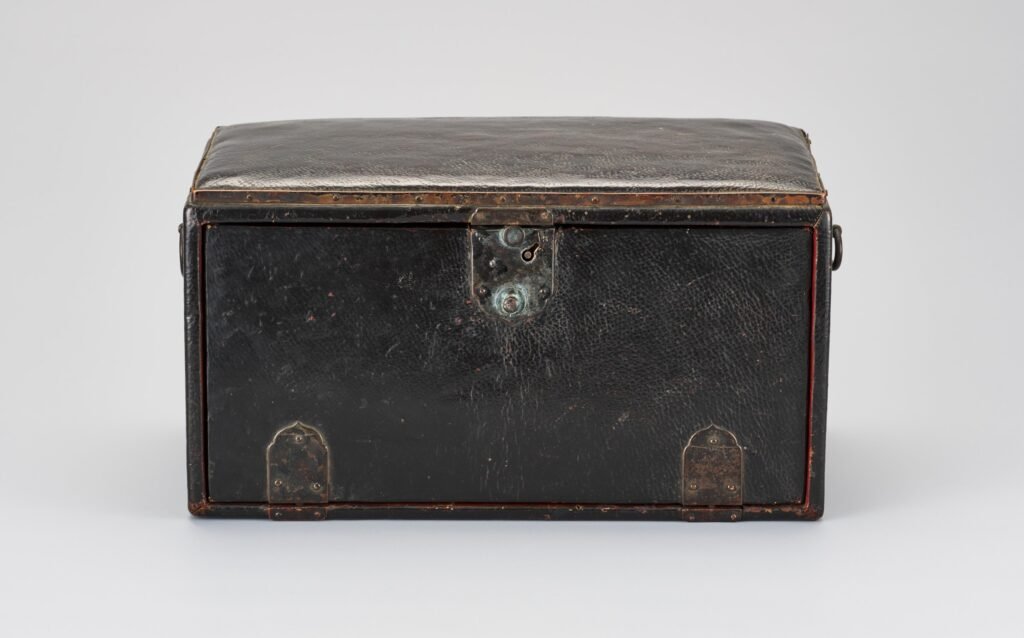
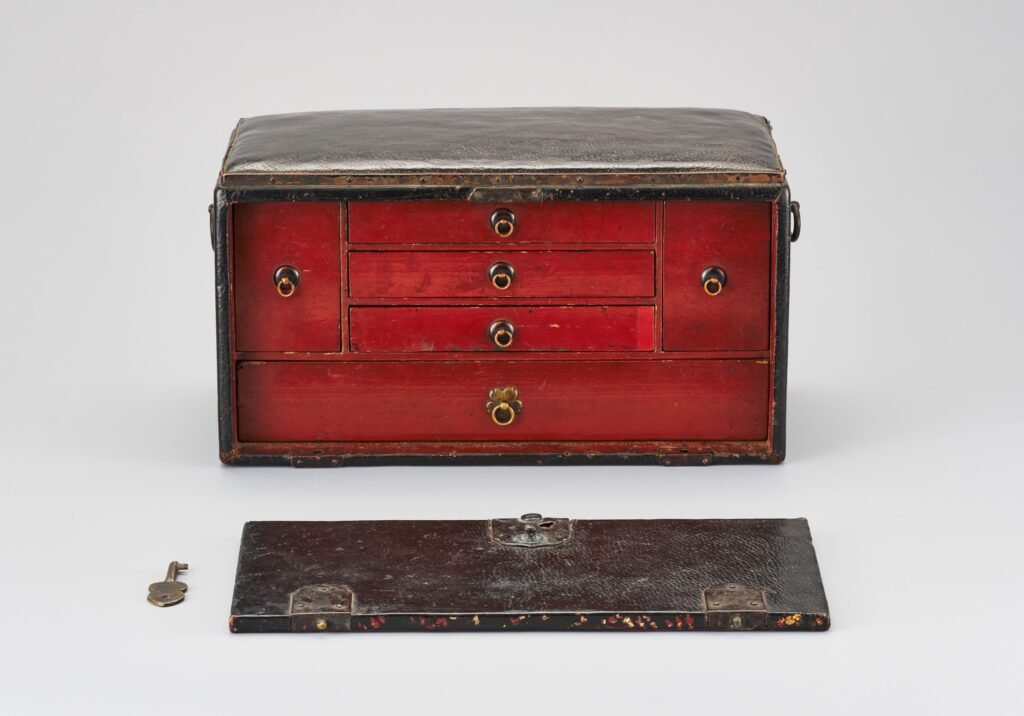




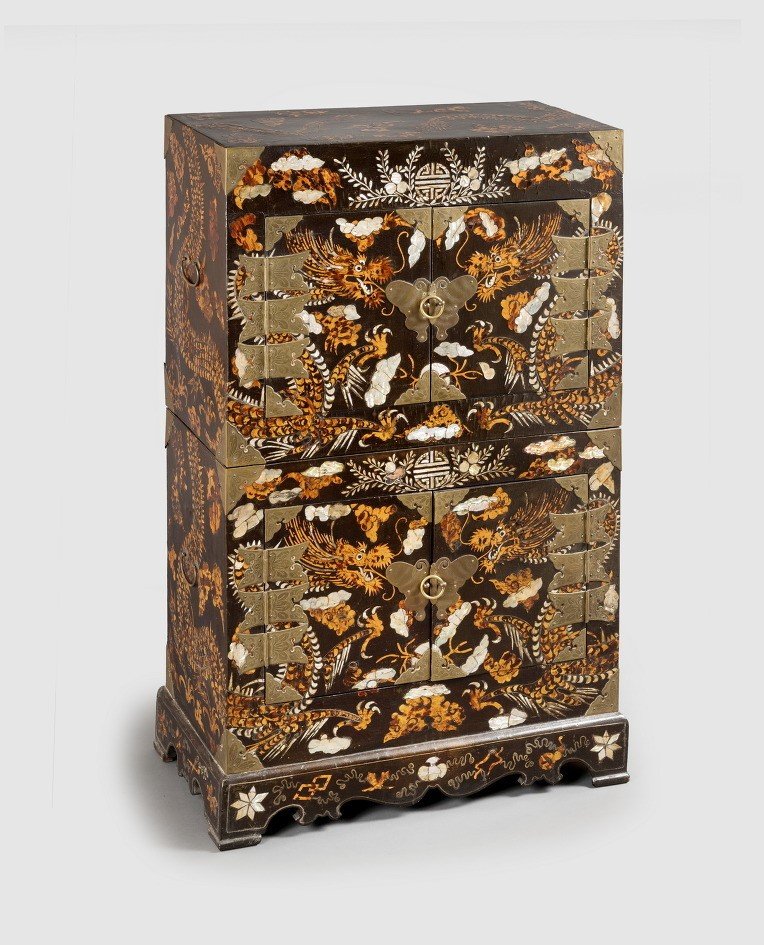
Lacquer with mother-of-pearl and tortoise shell inlay. Yellow brass fittings.

